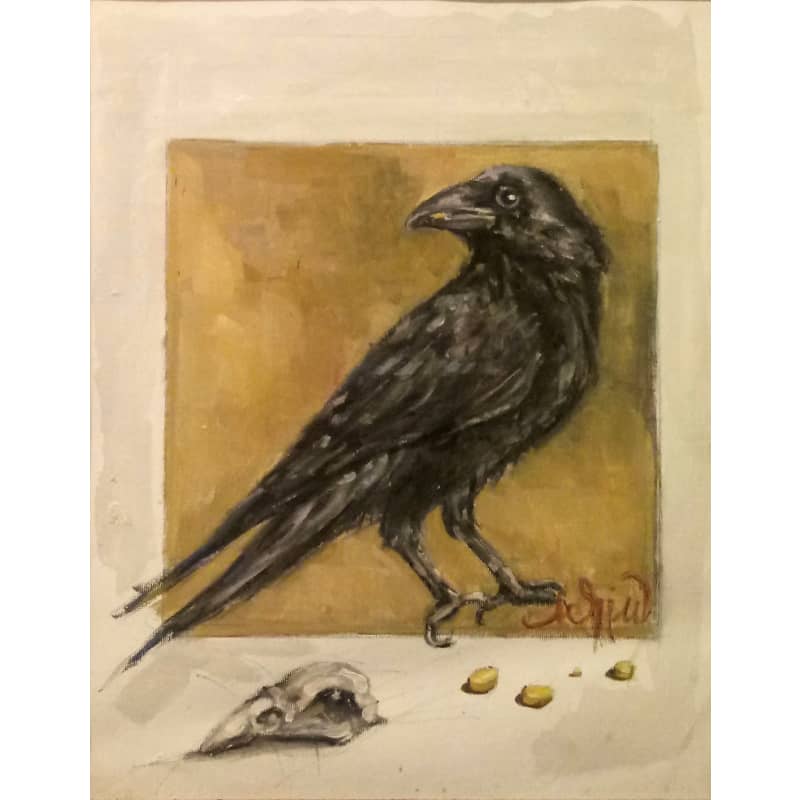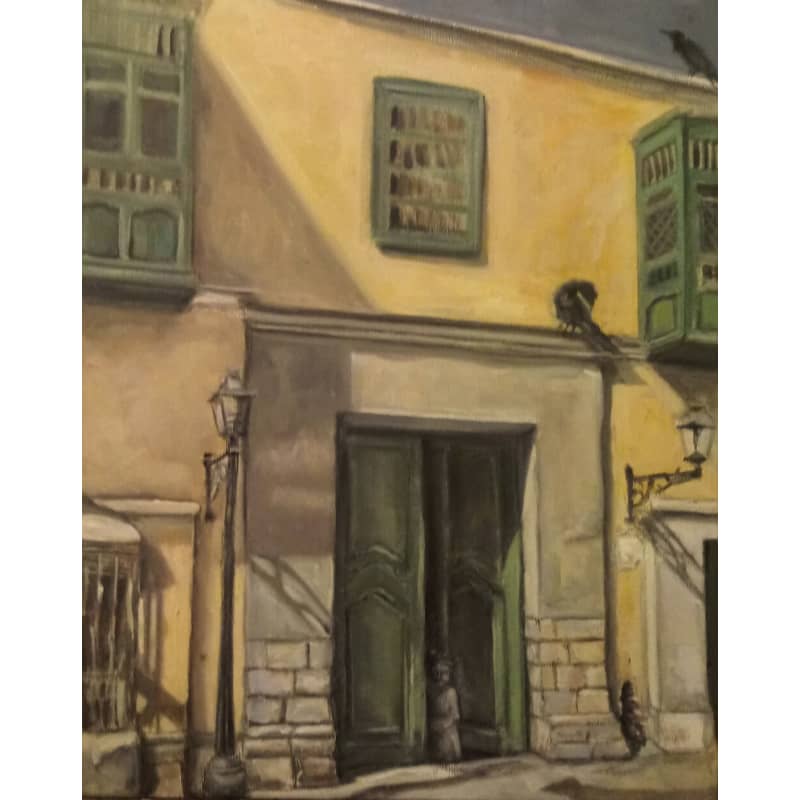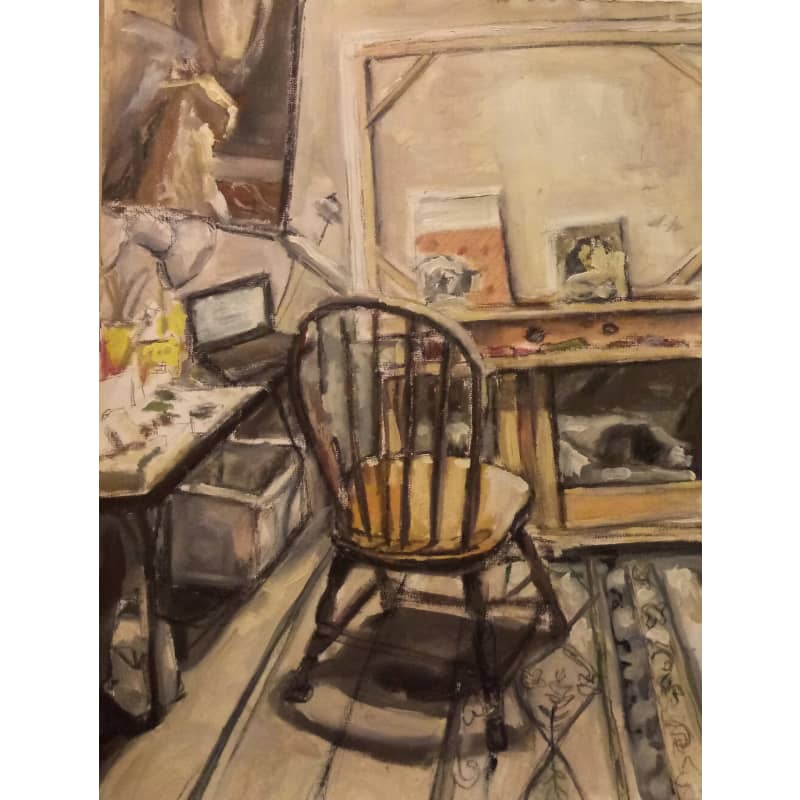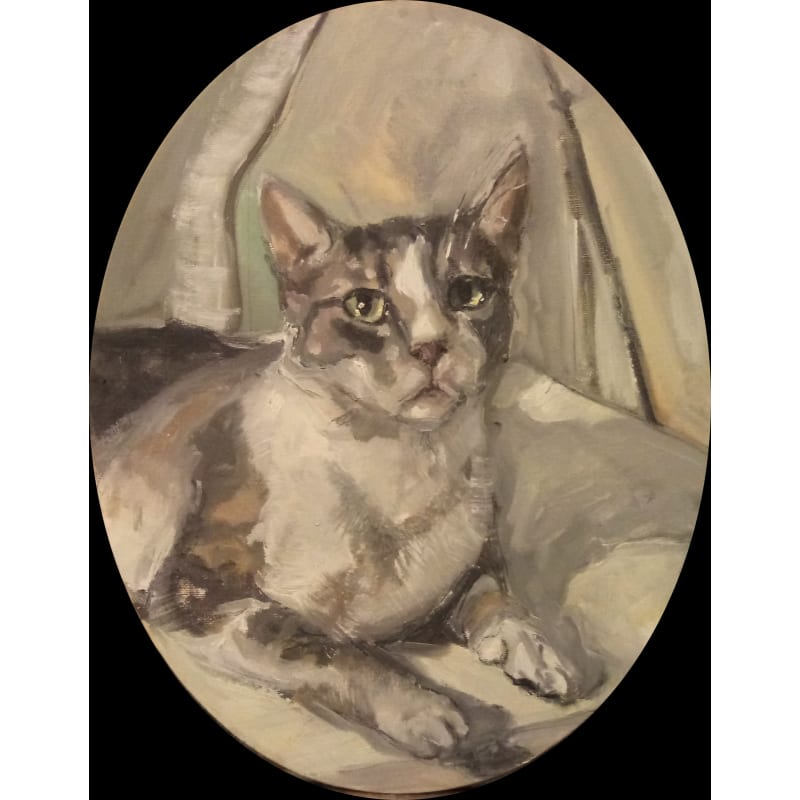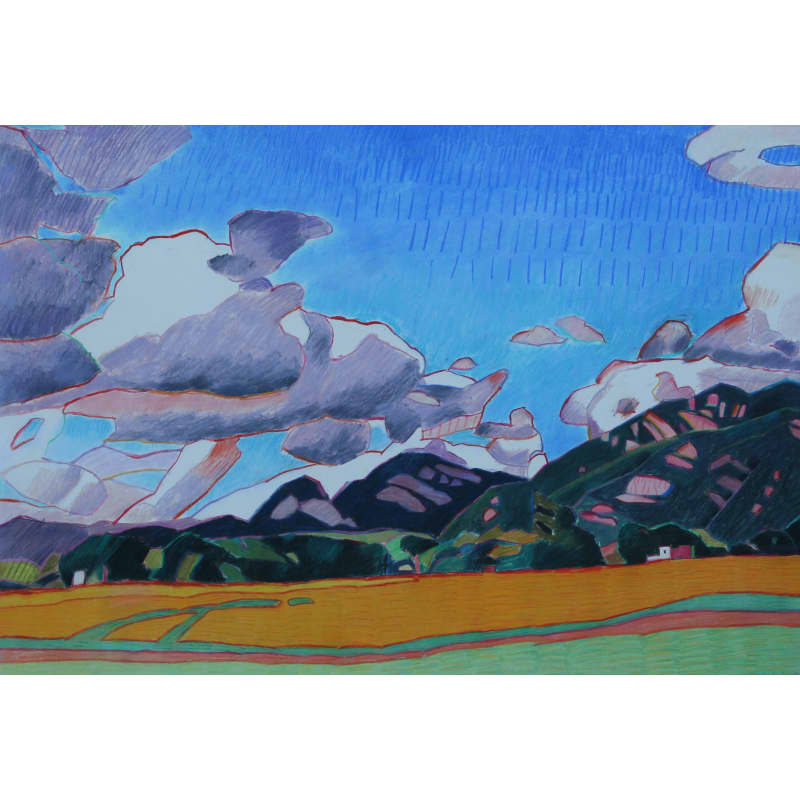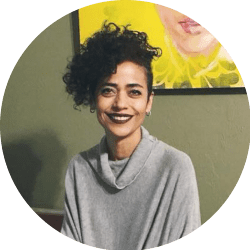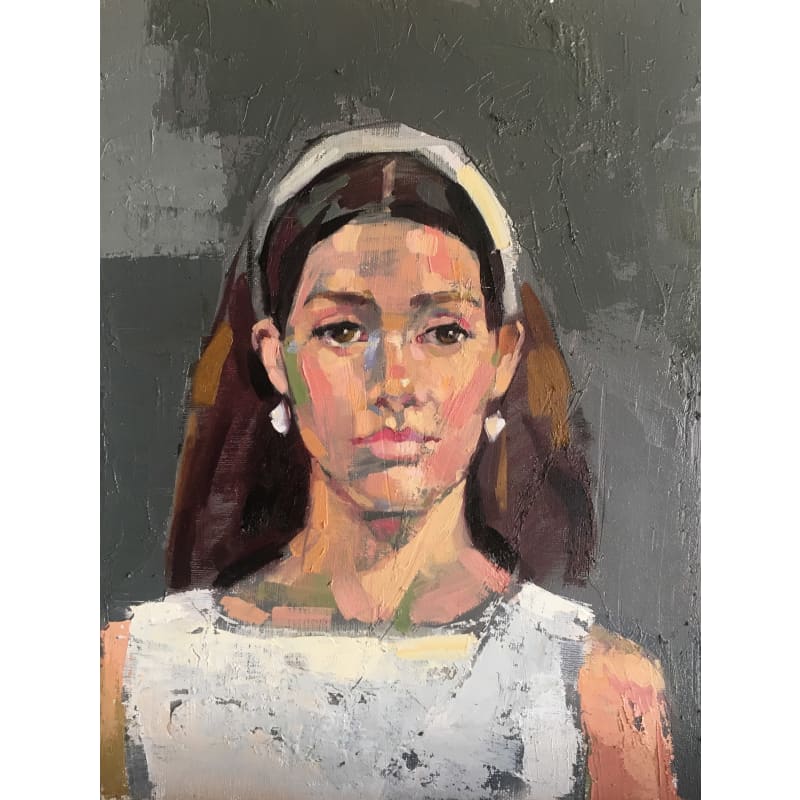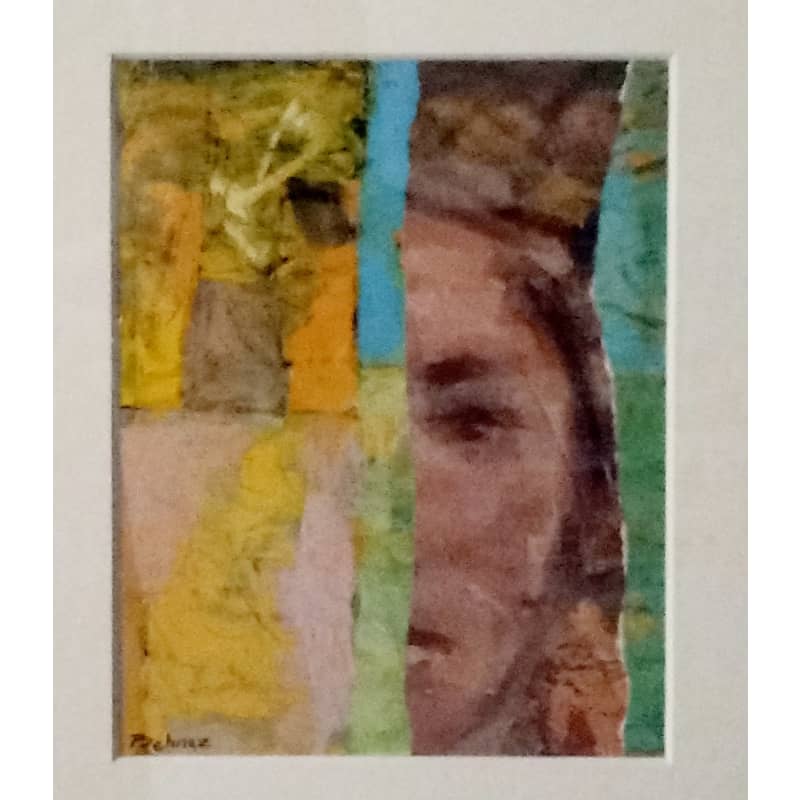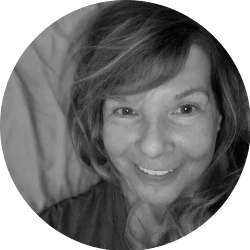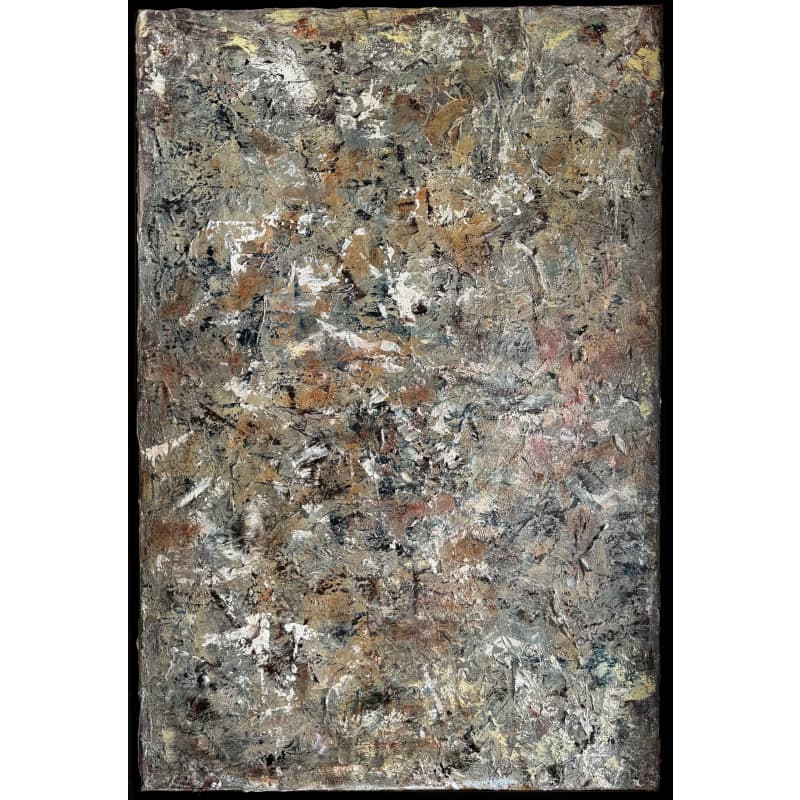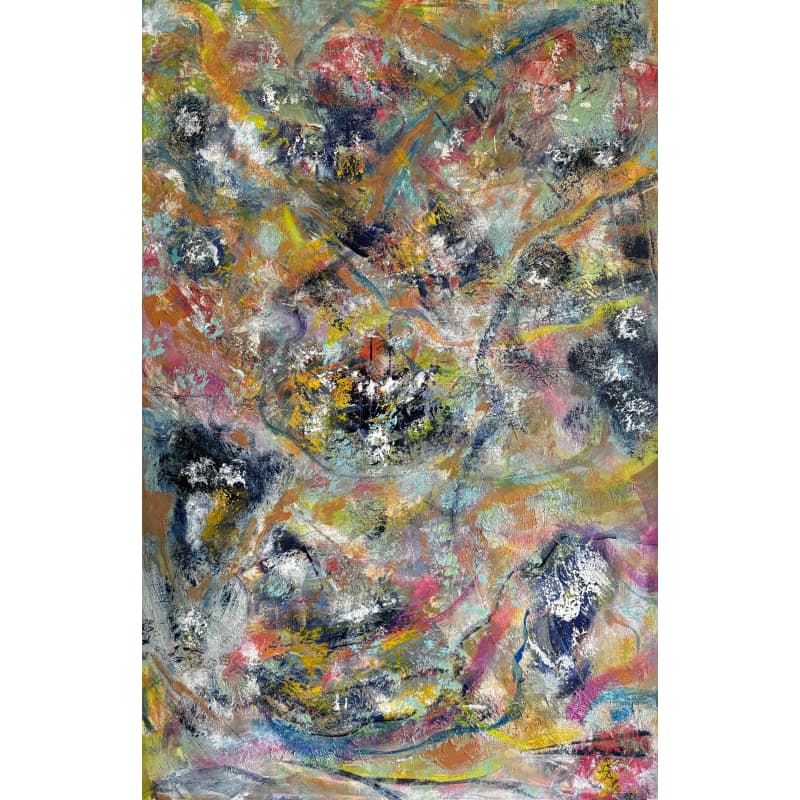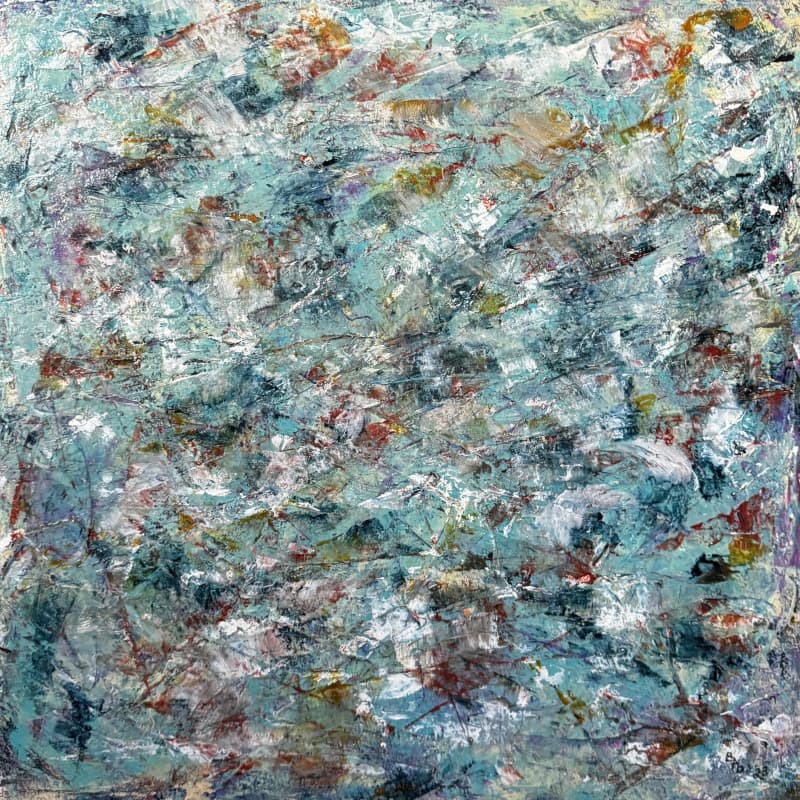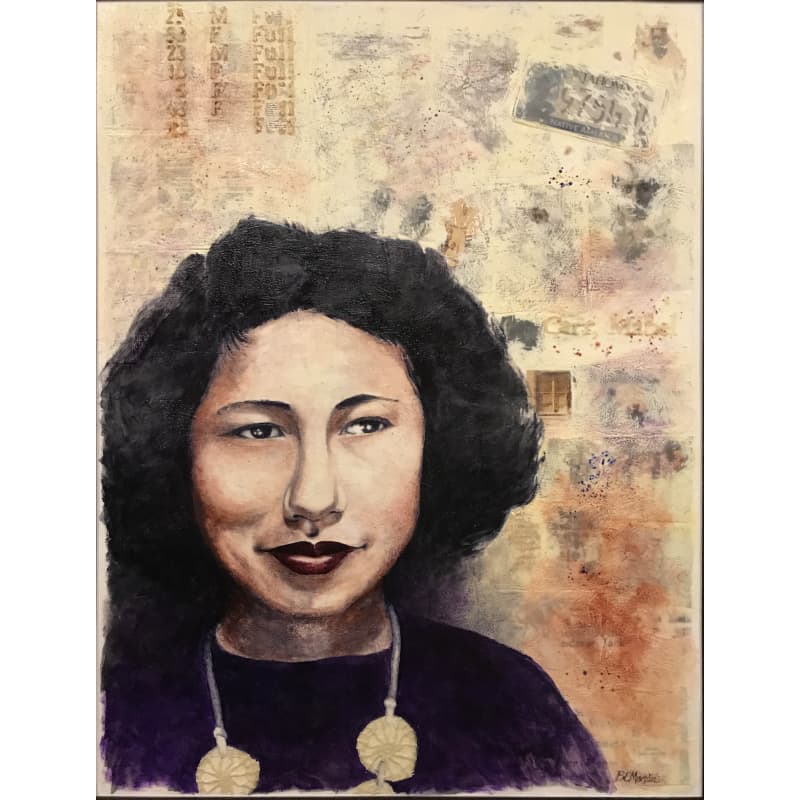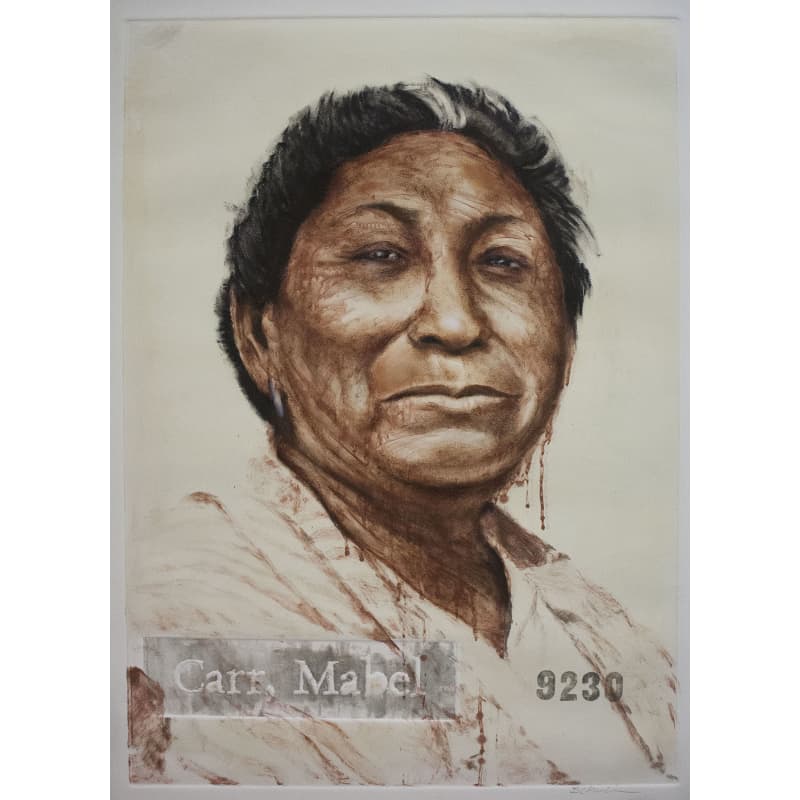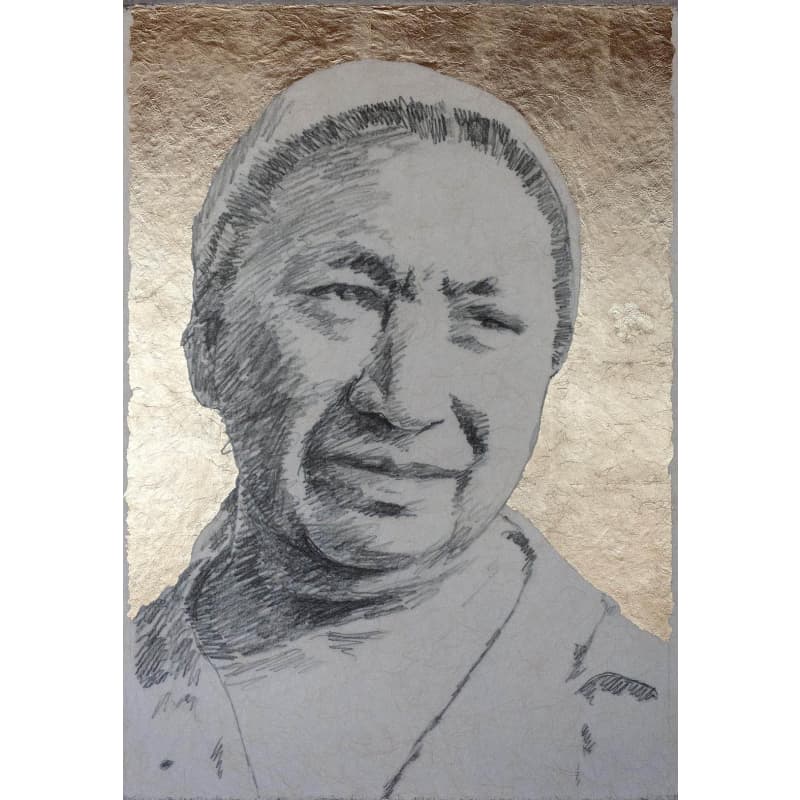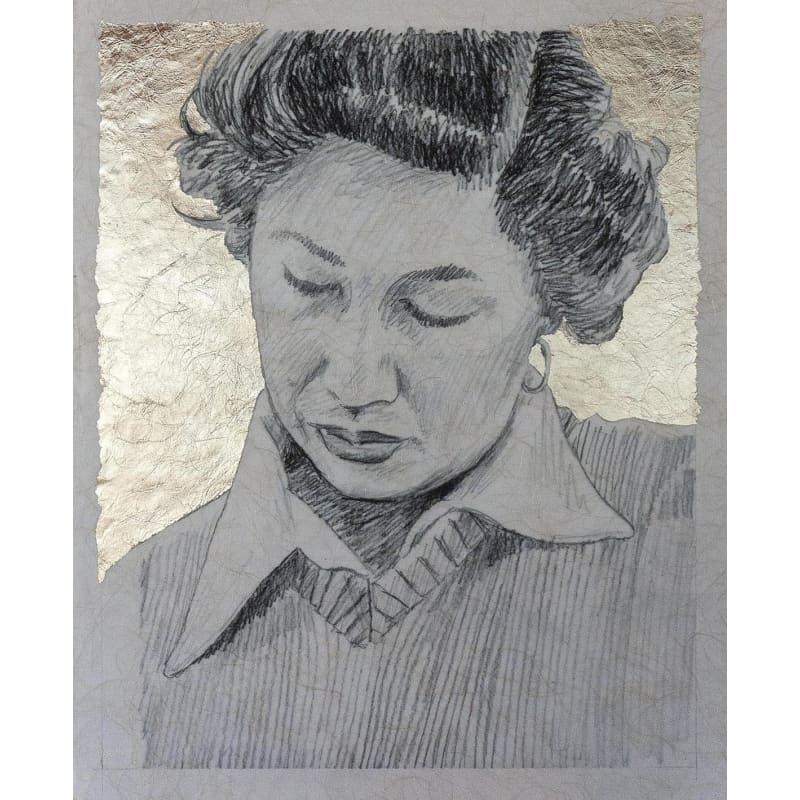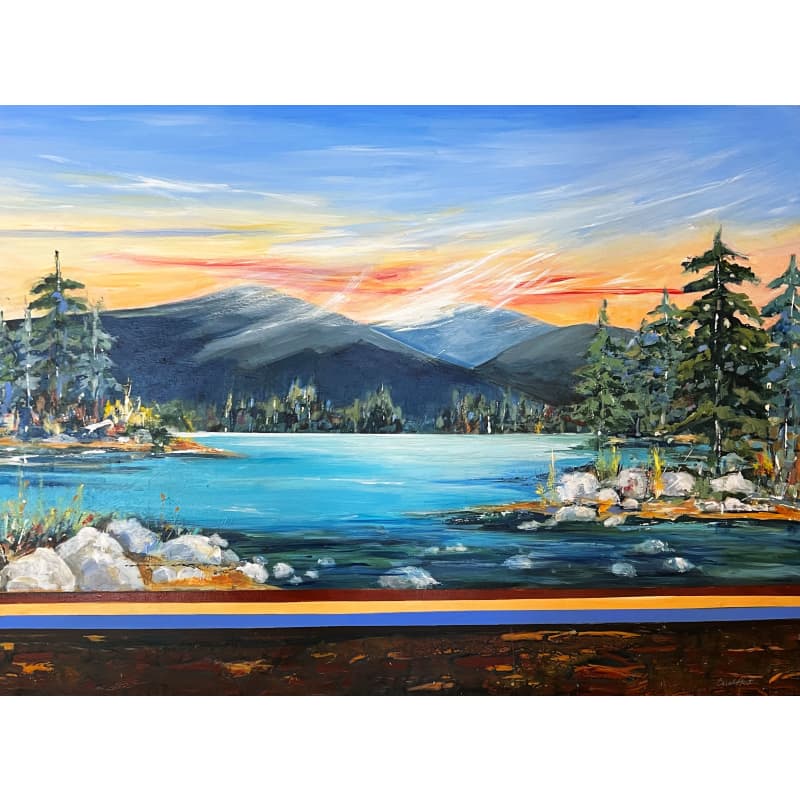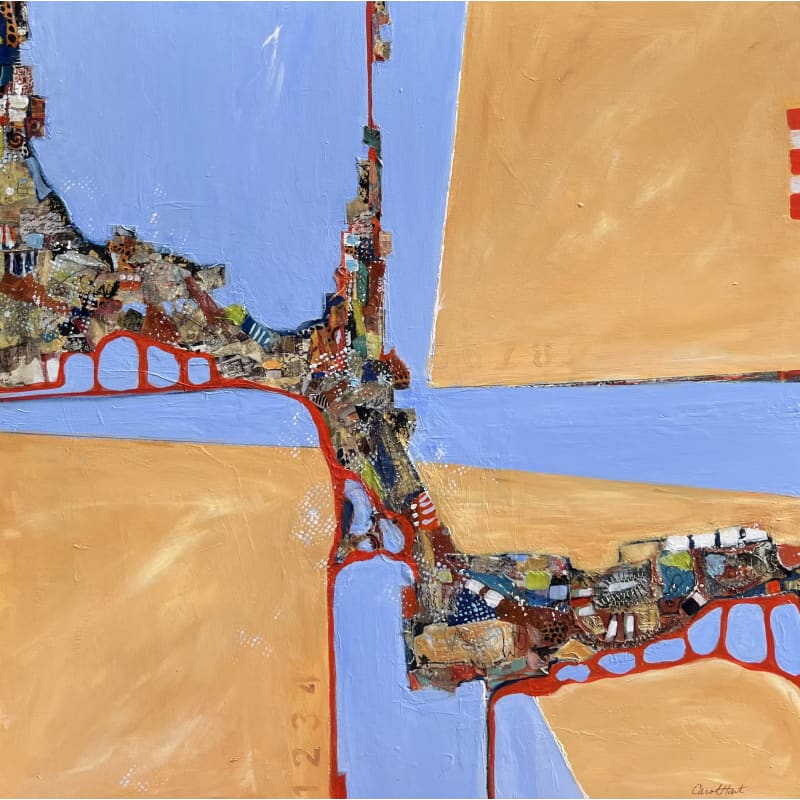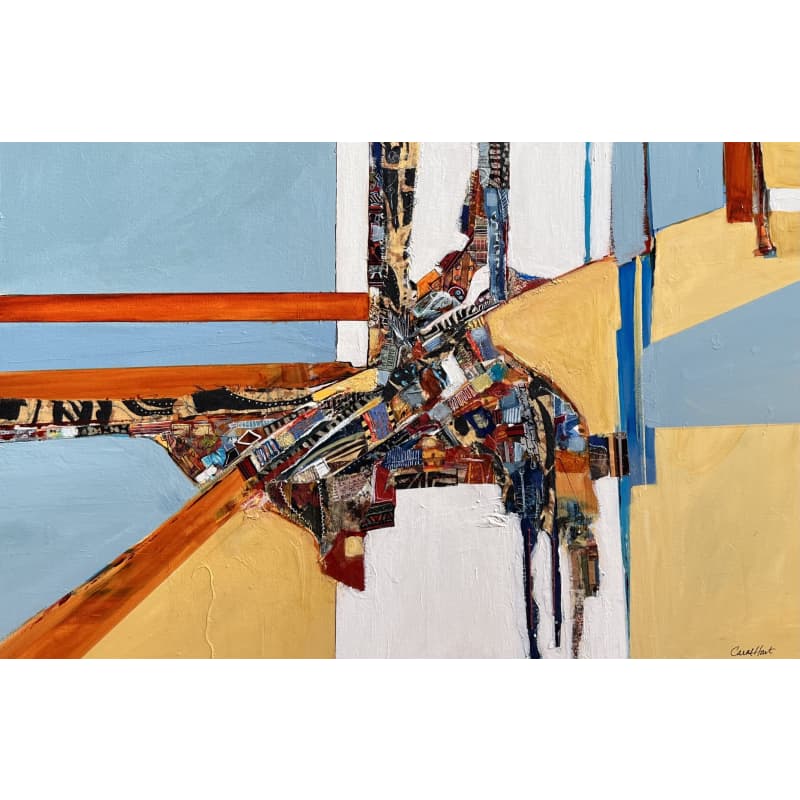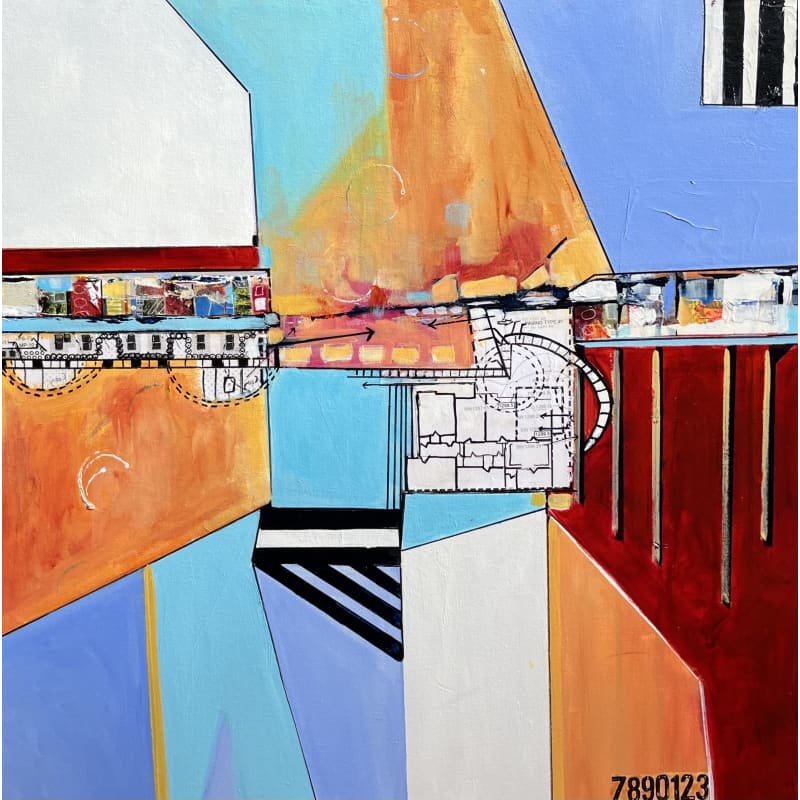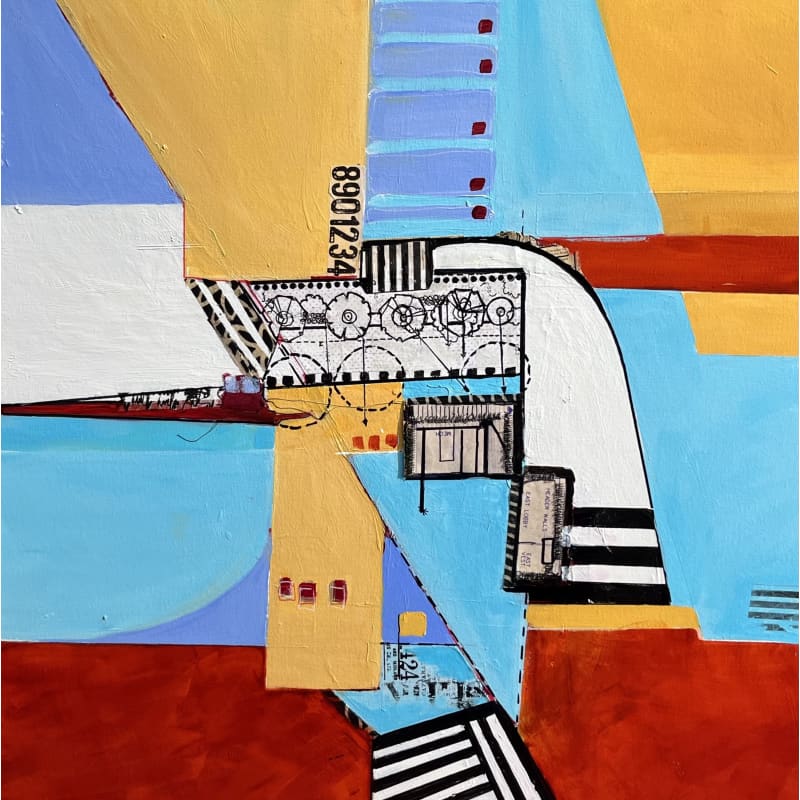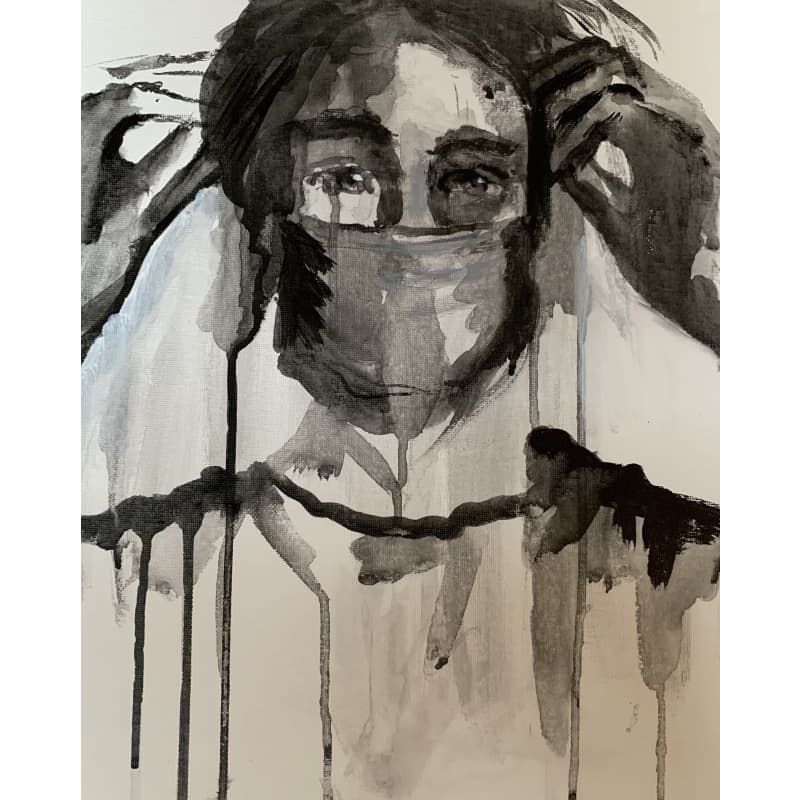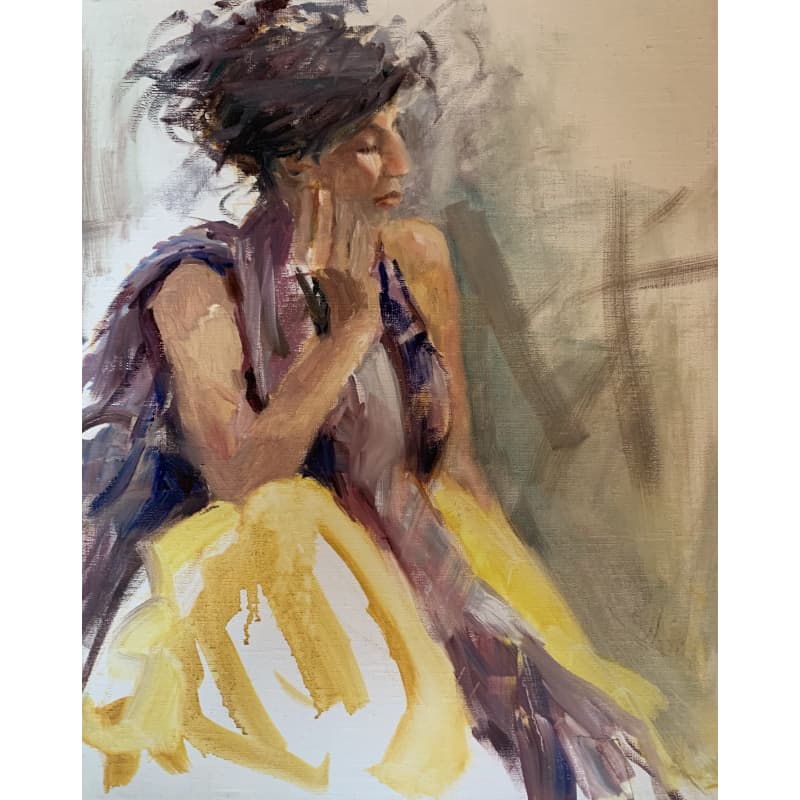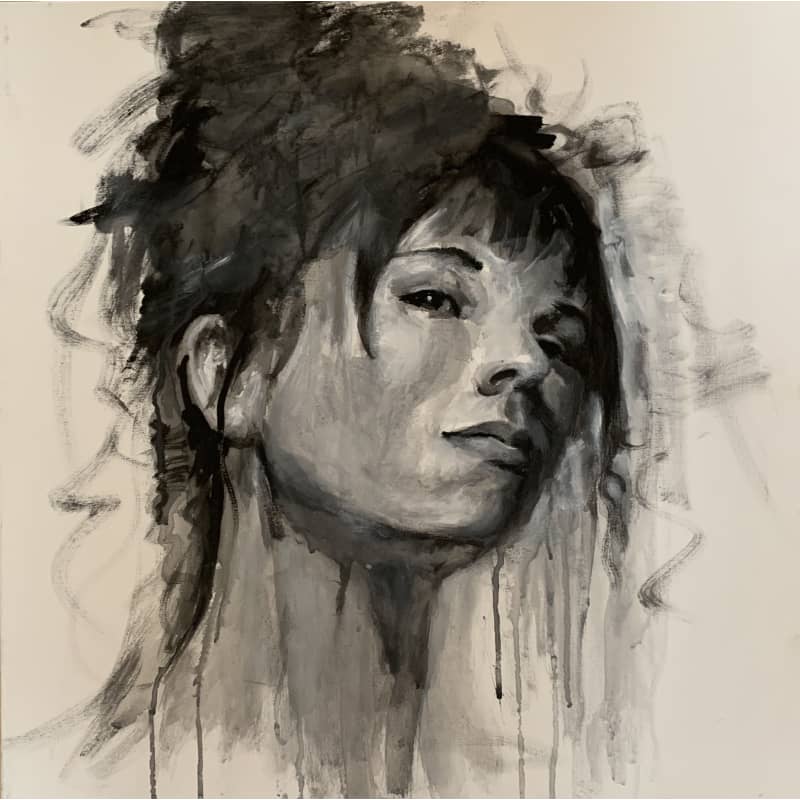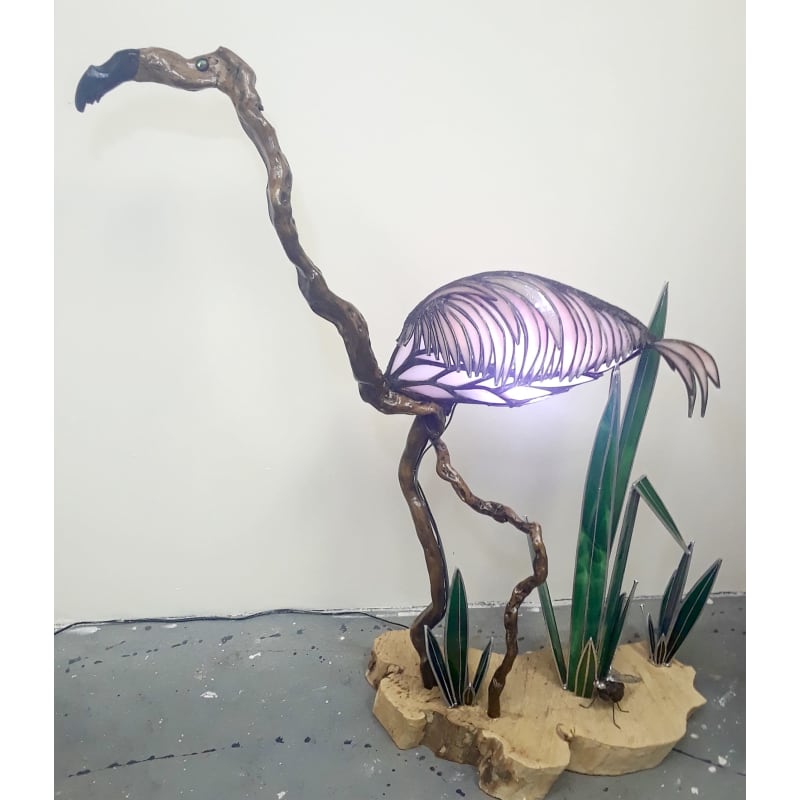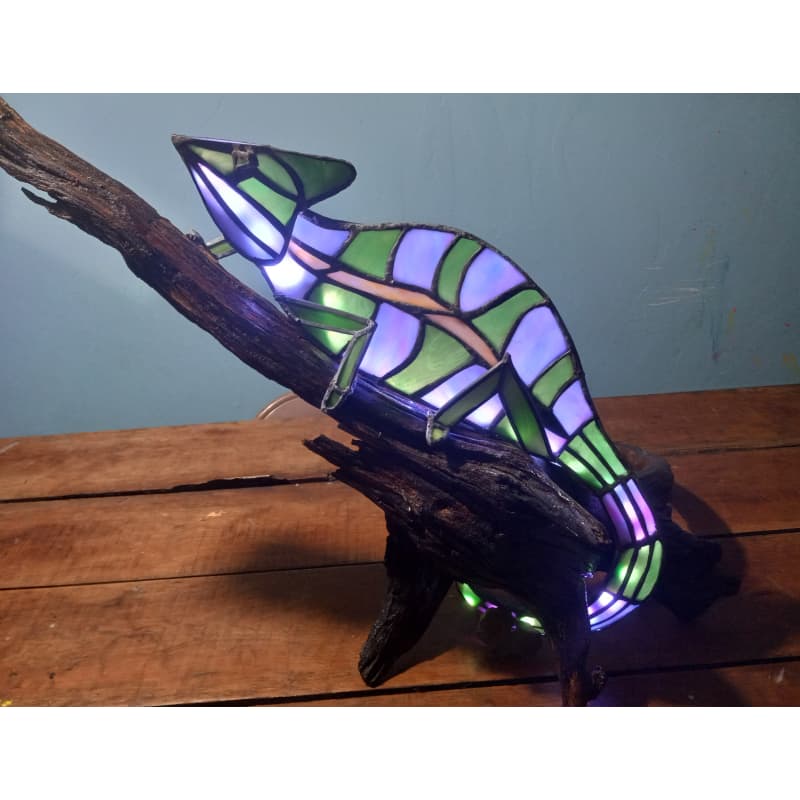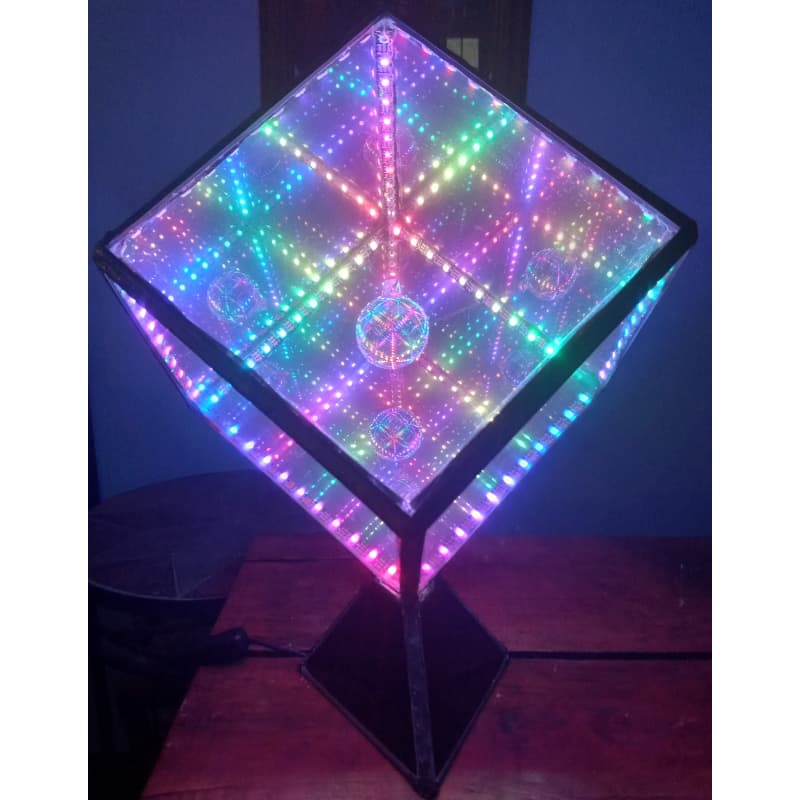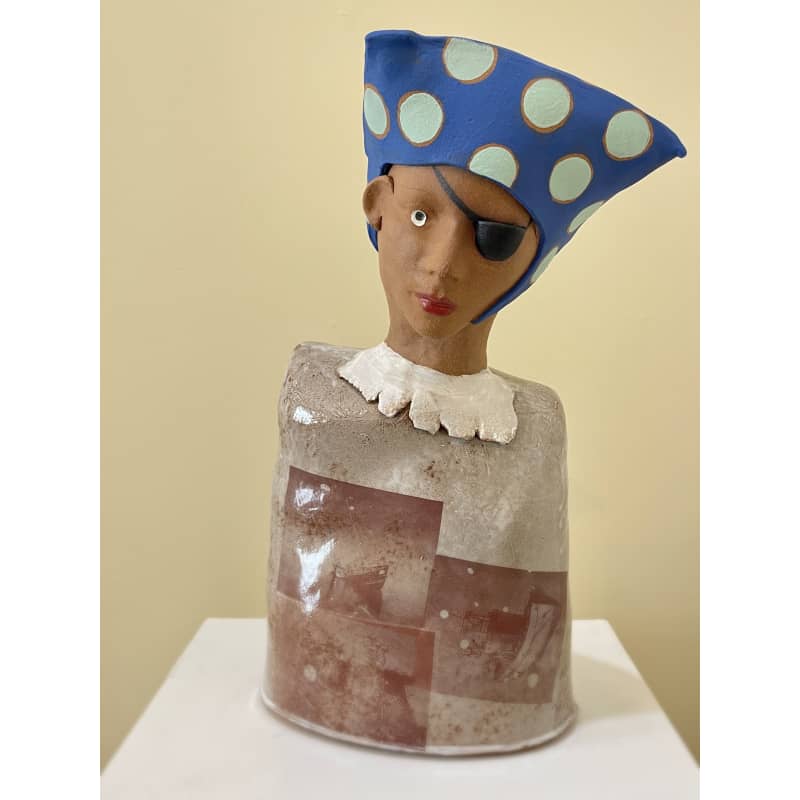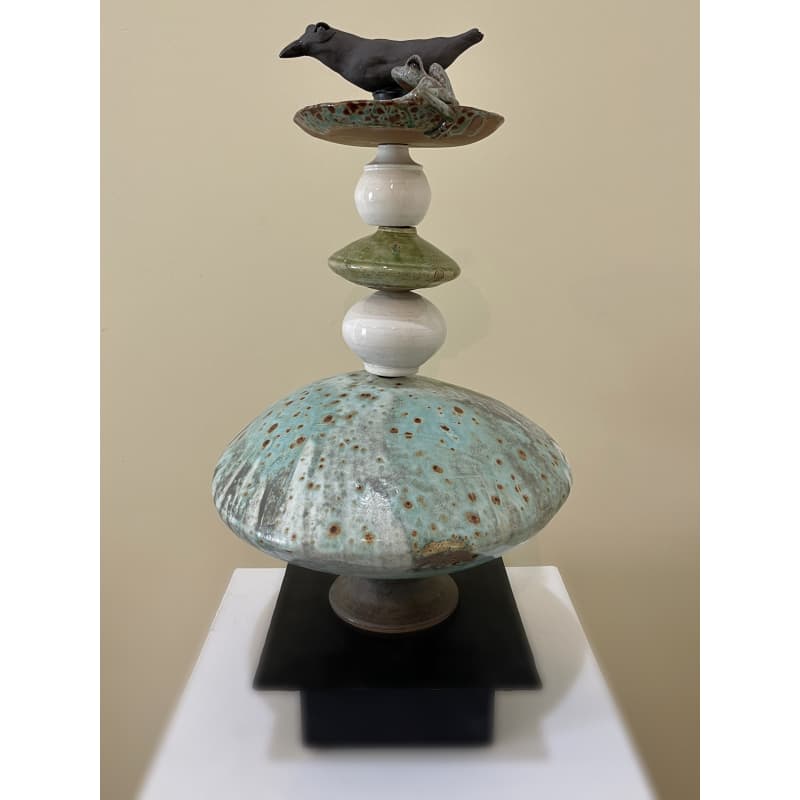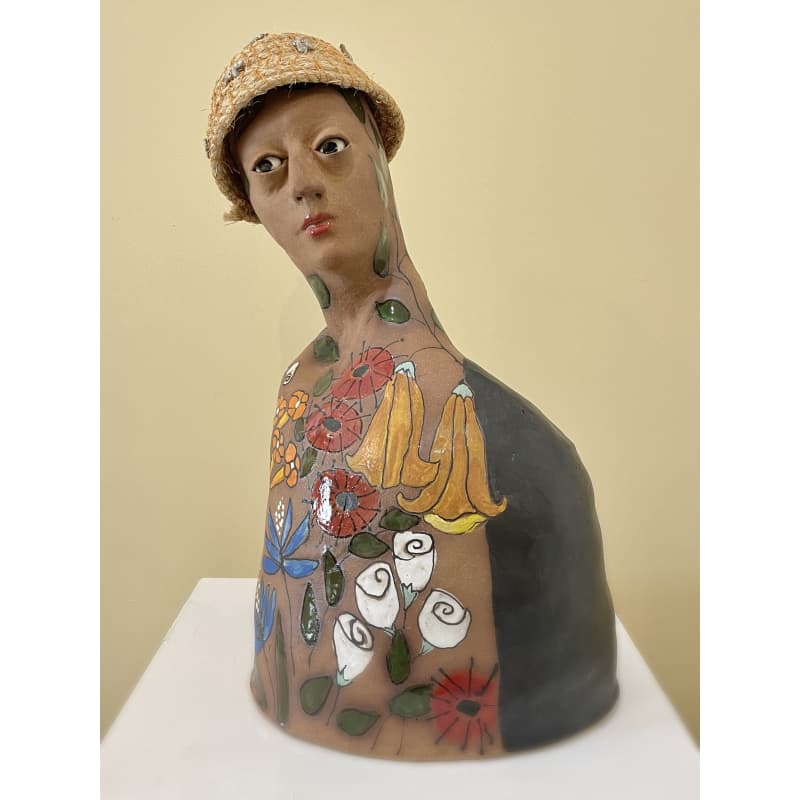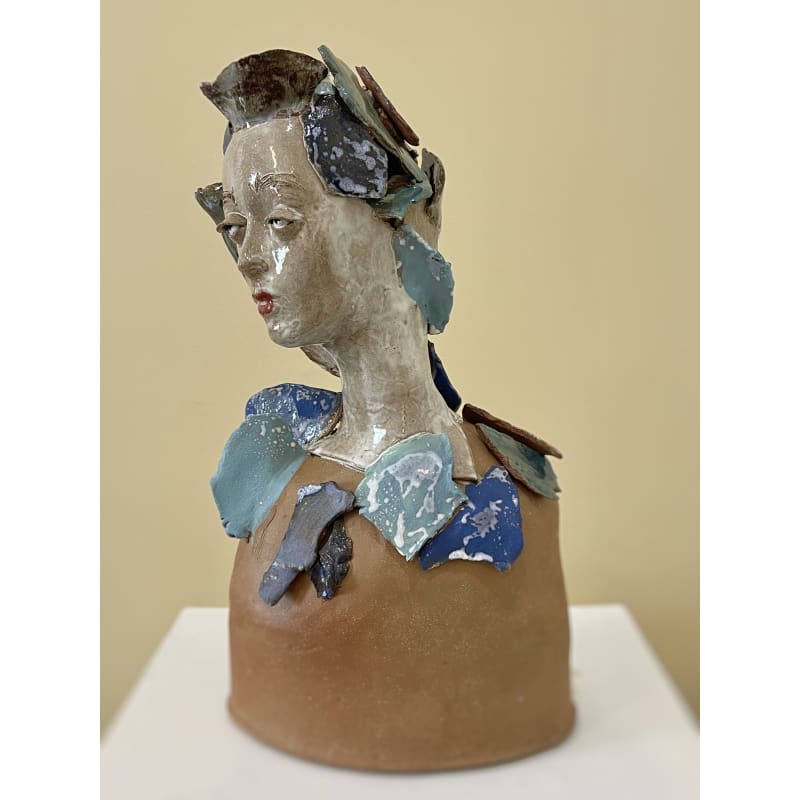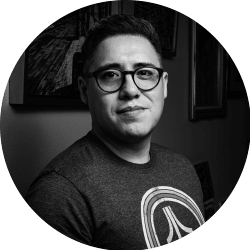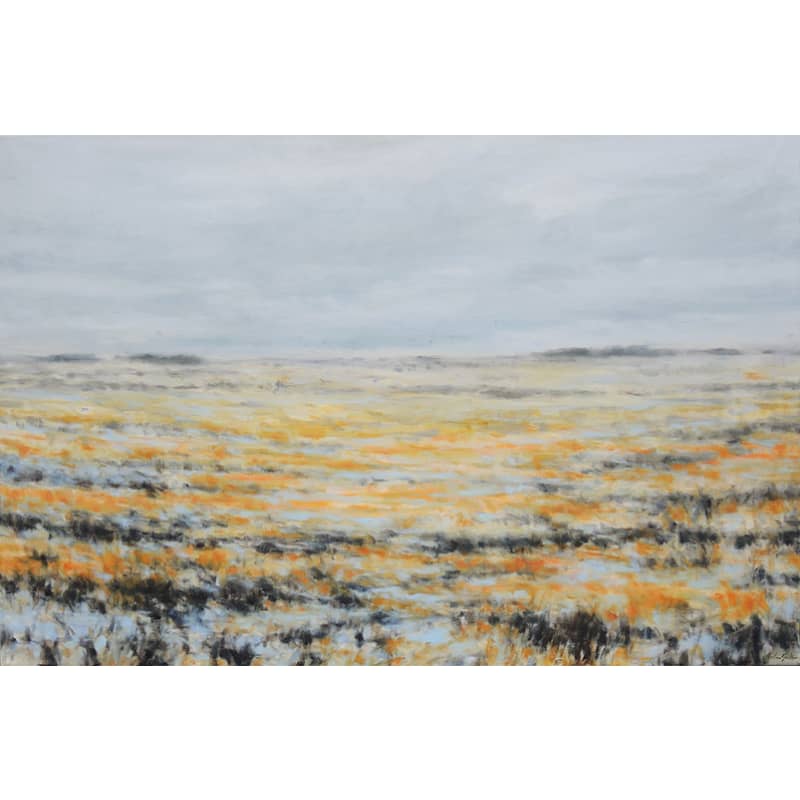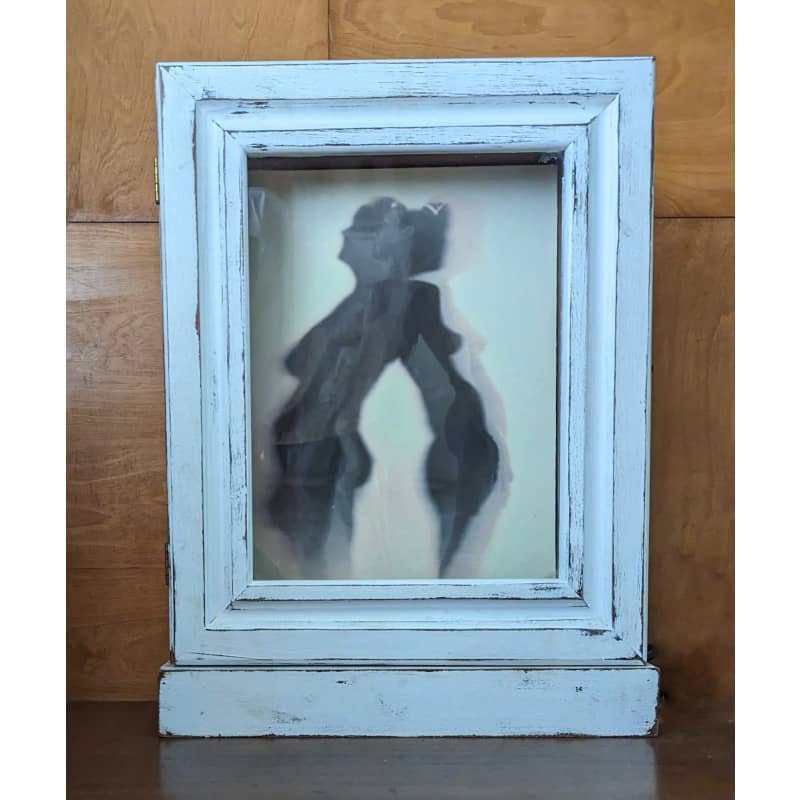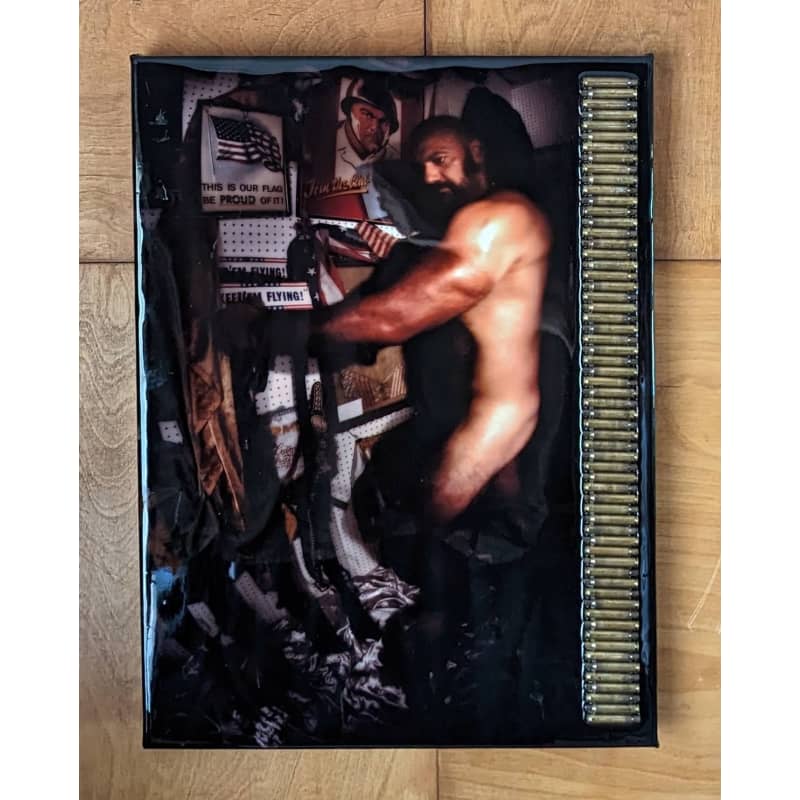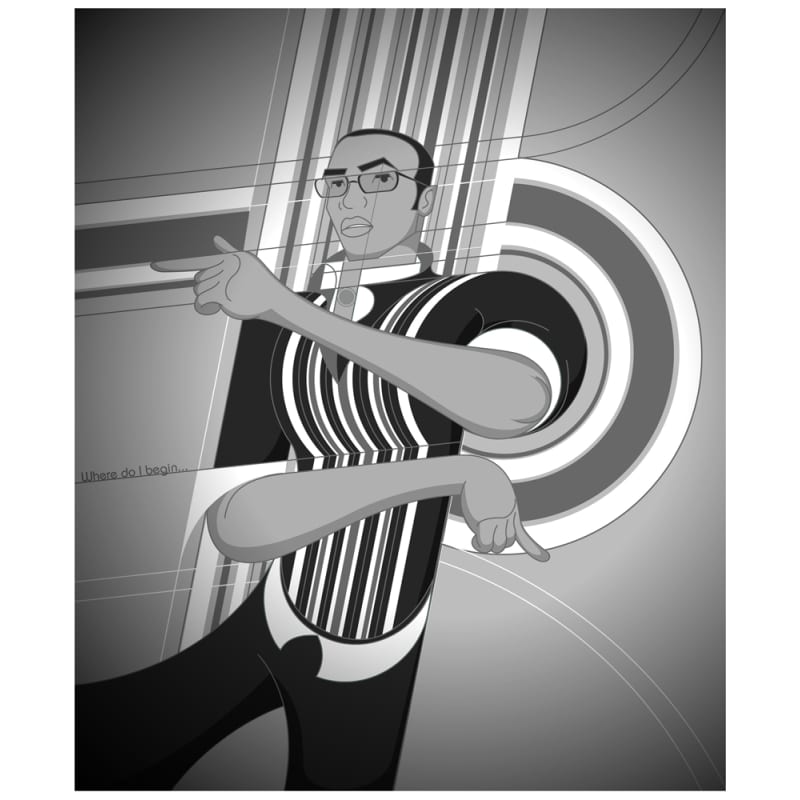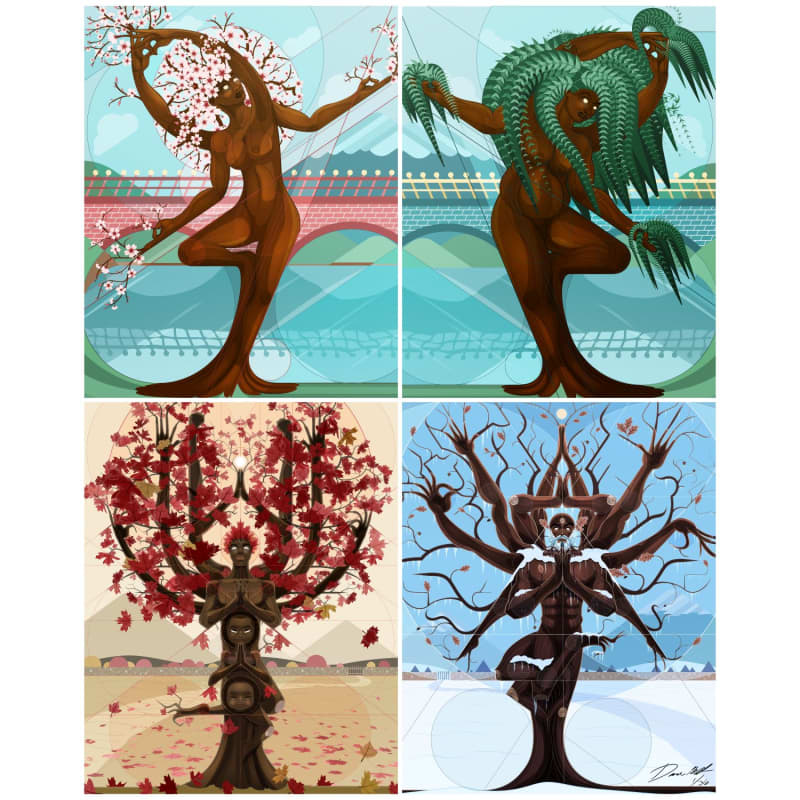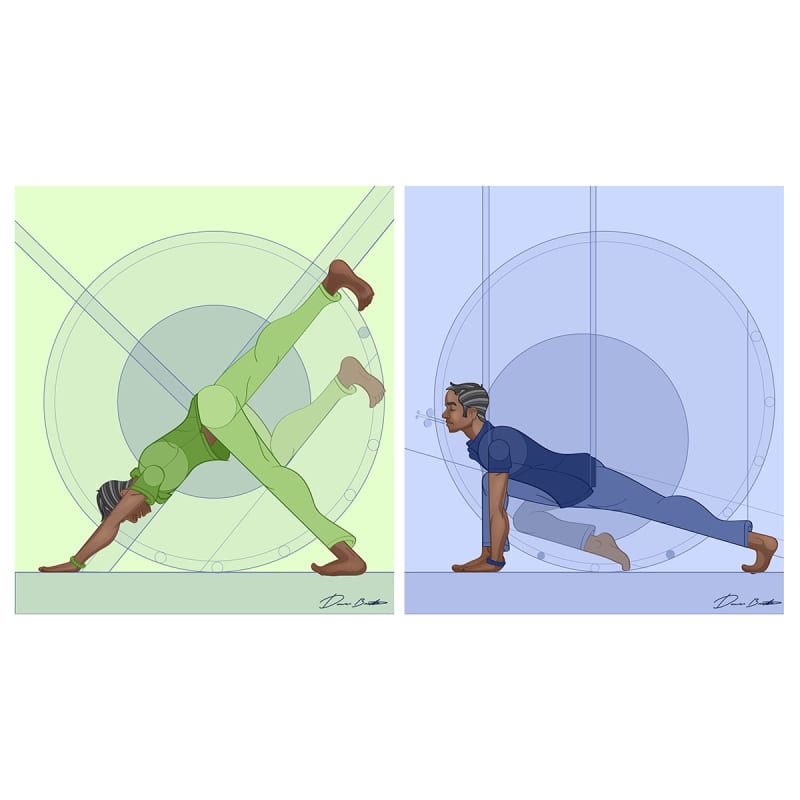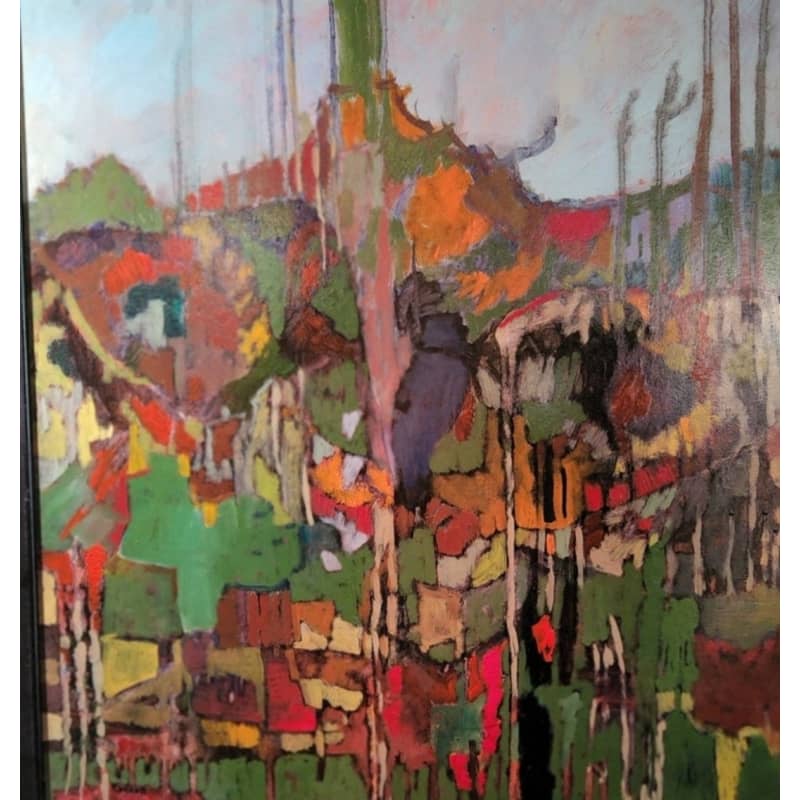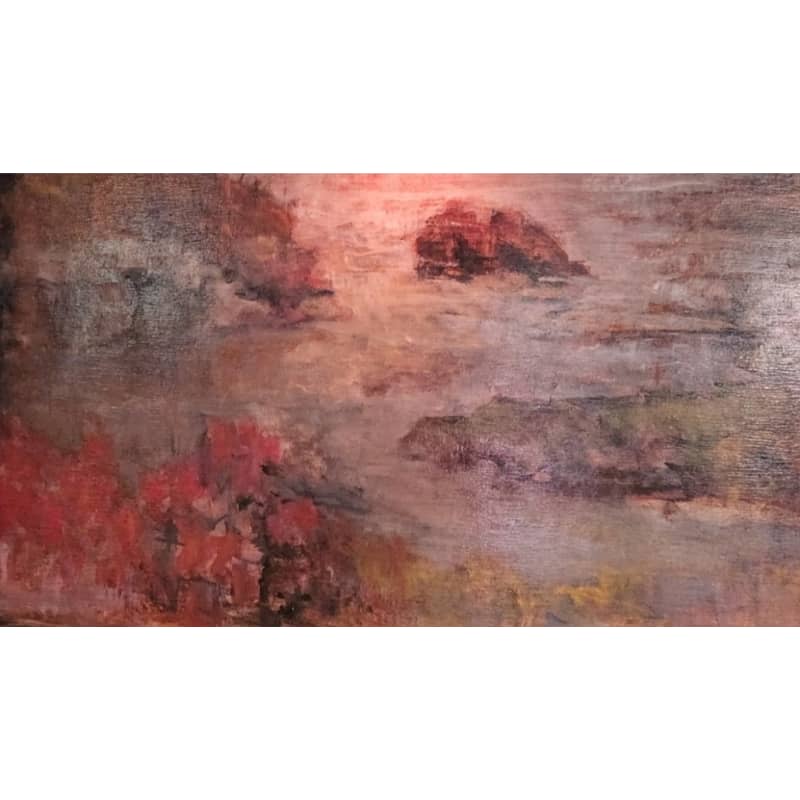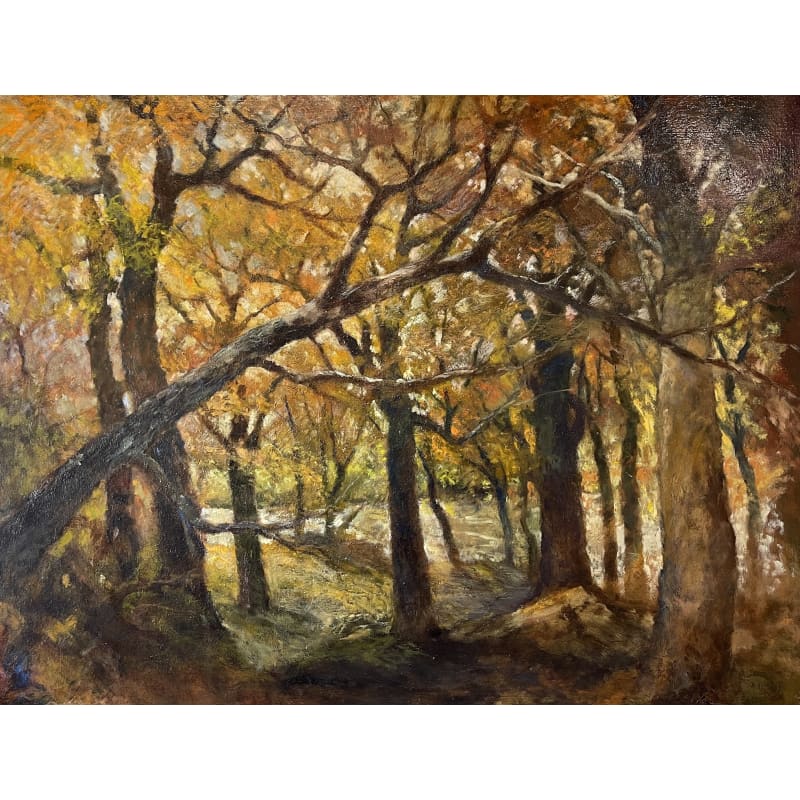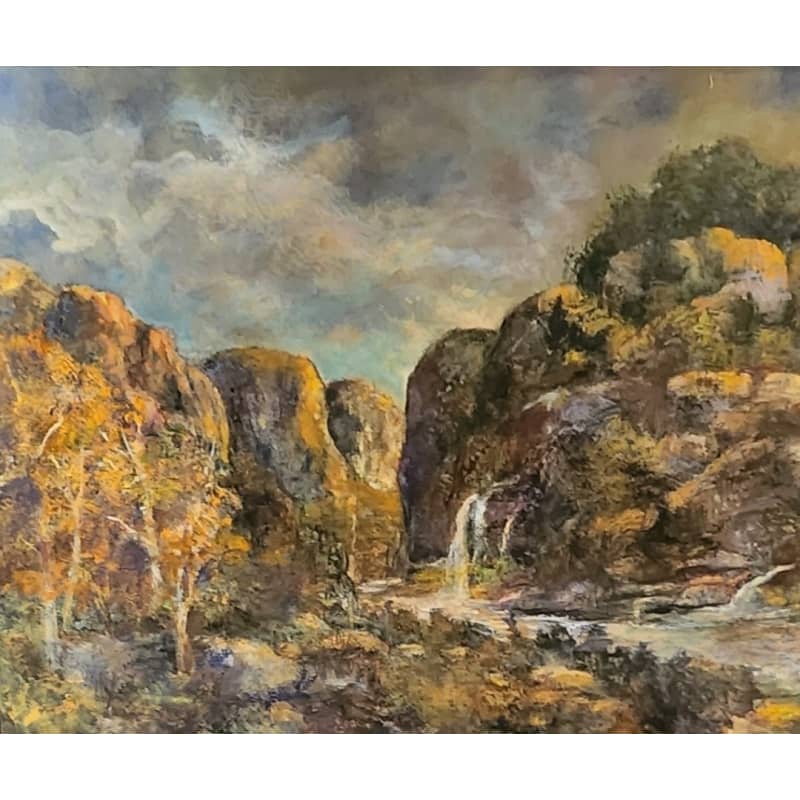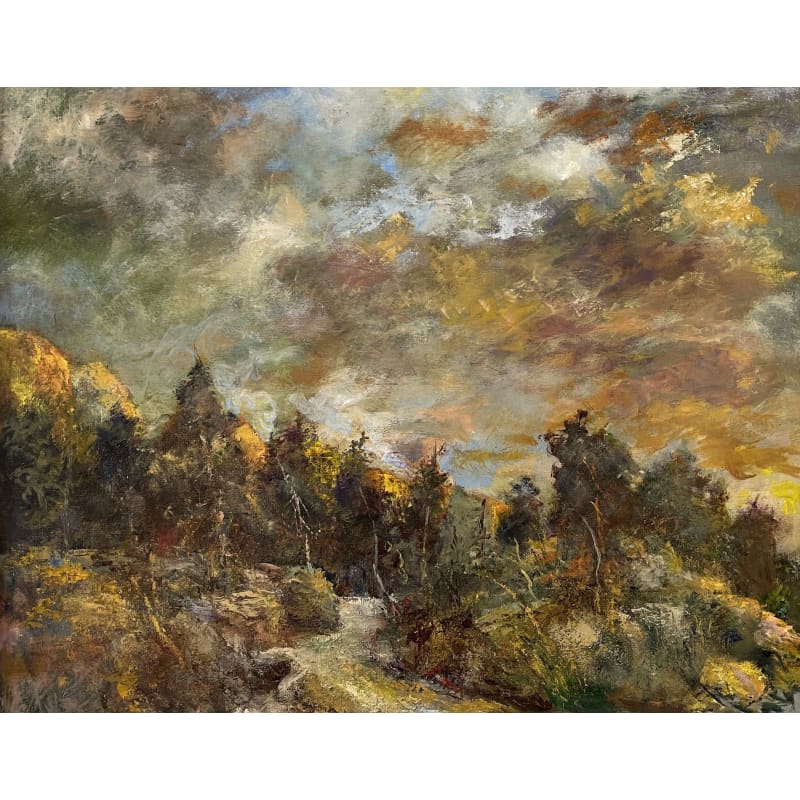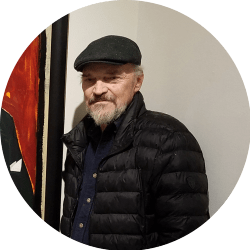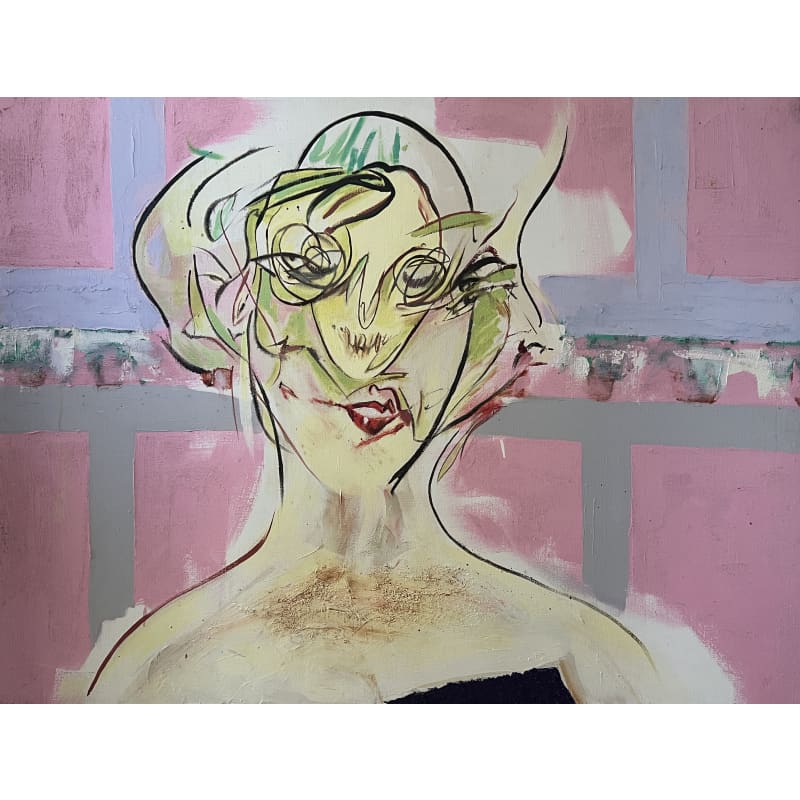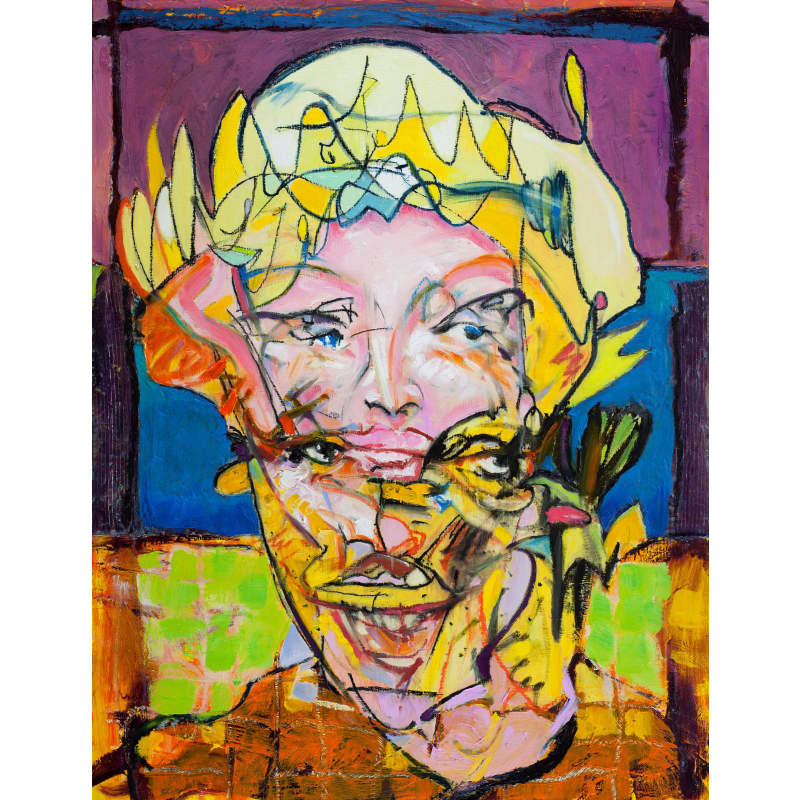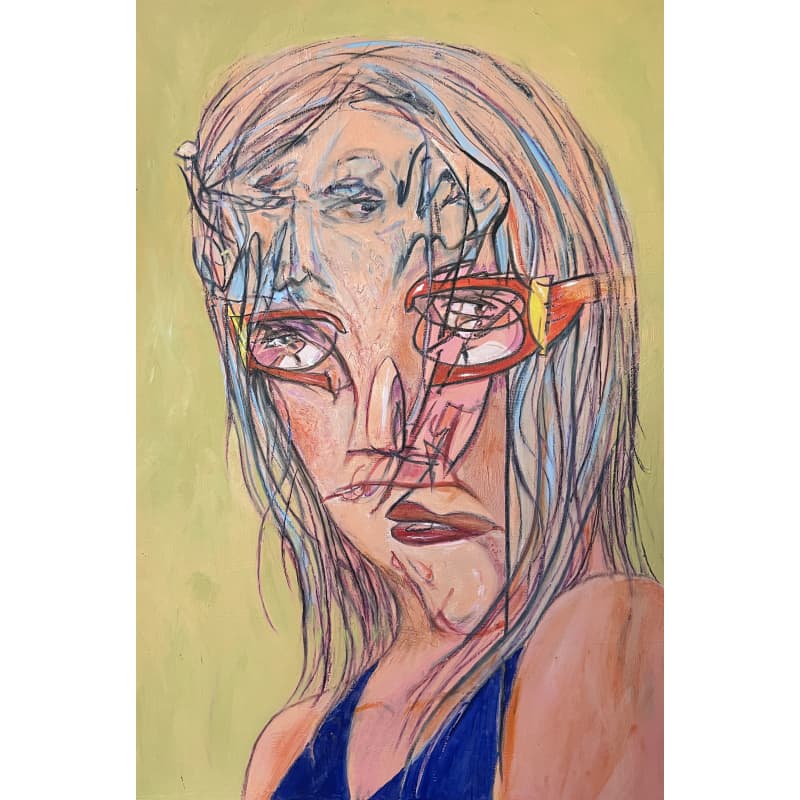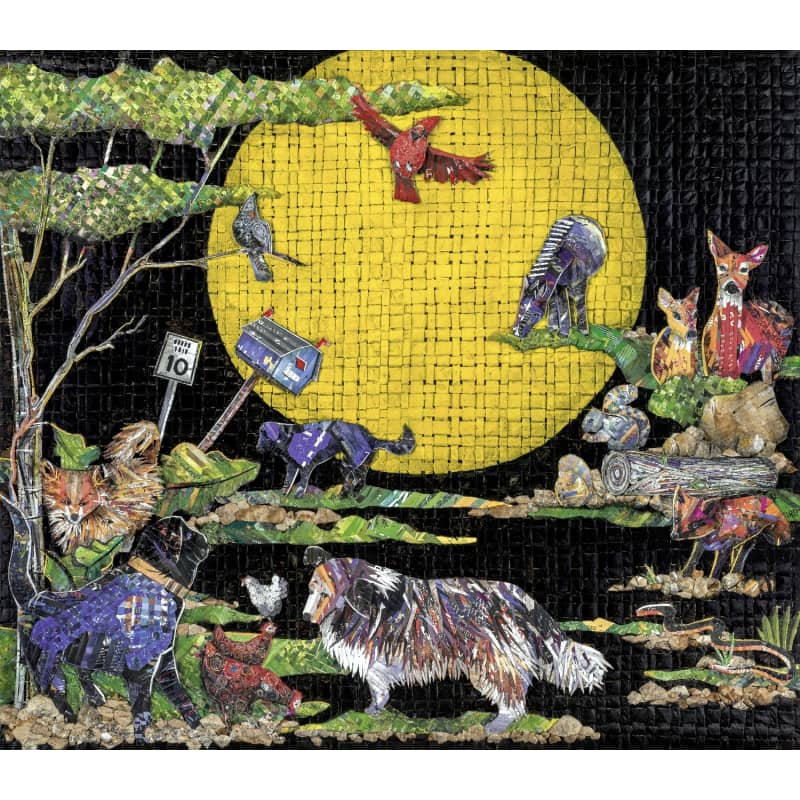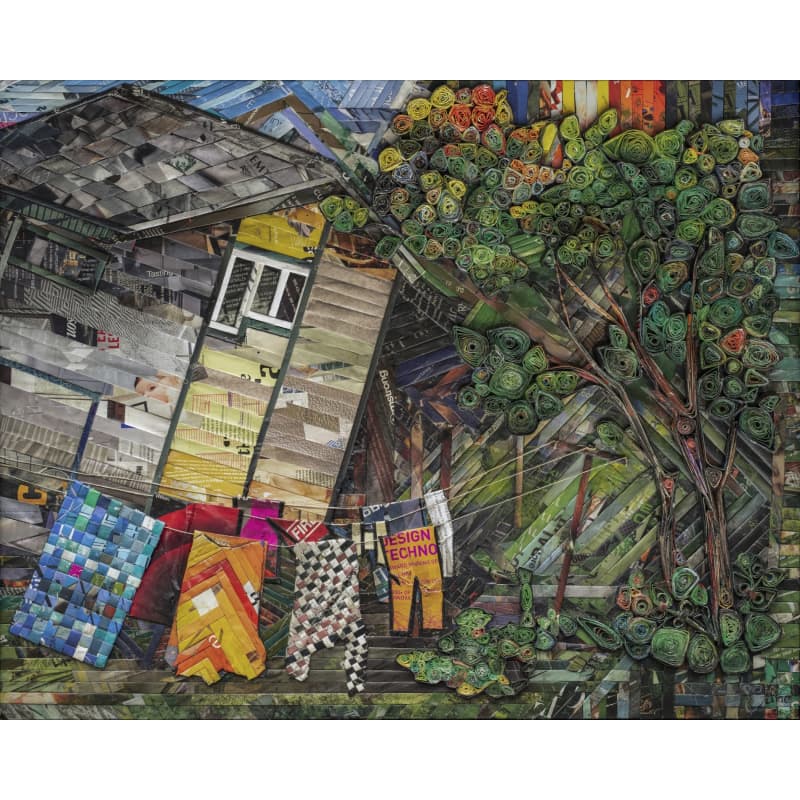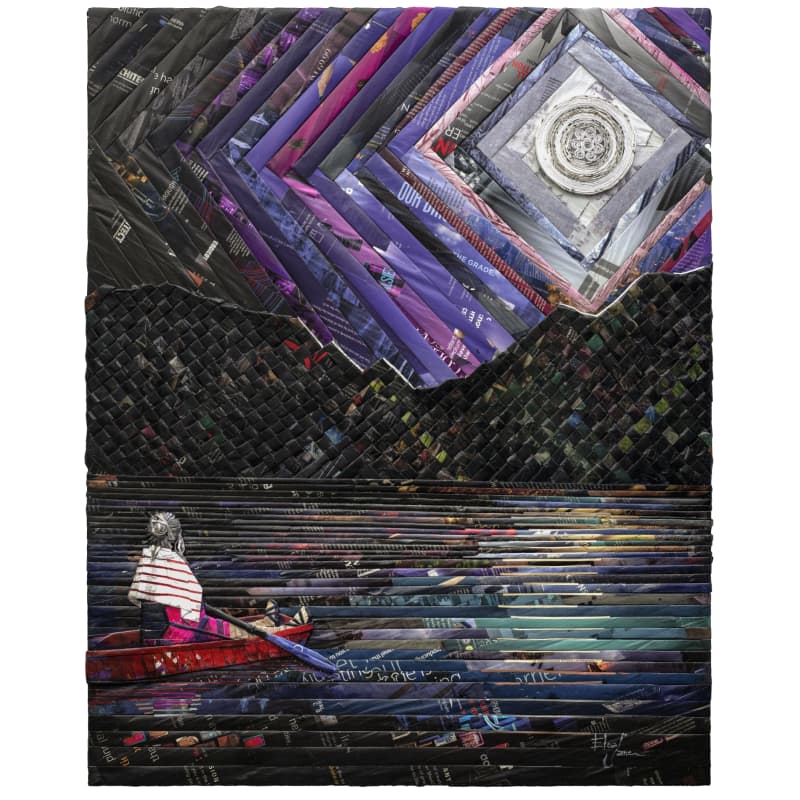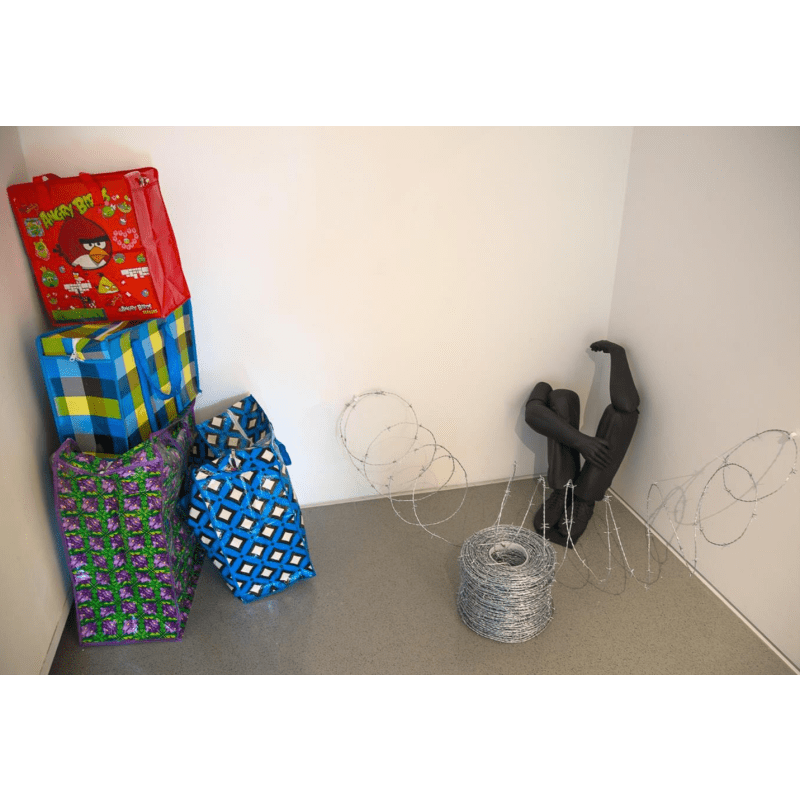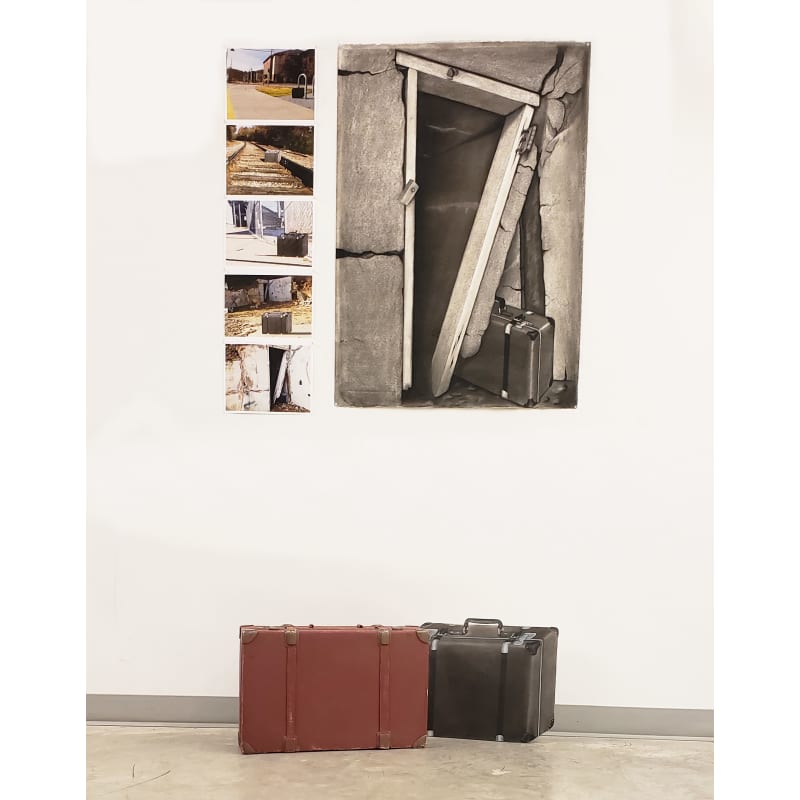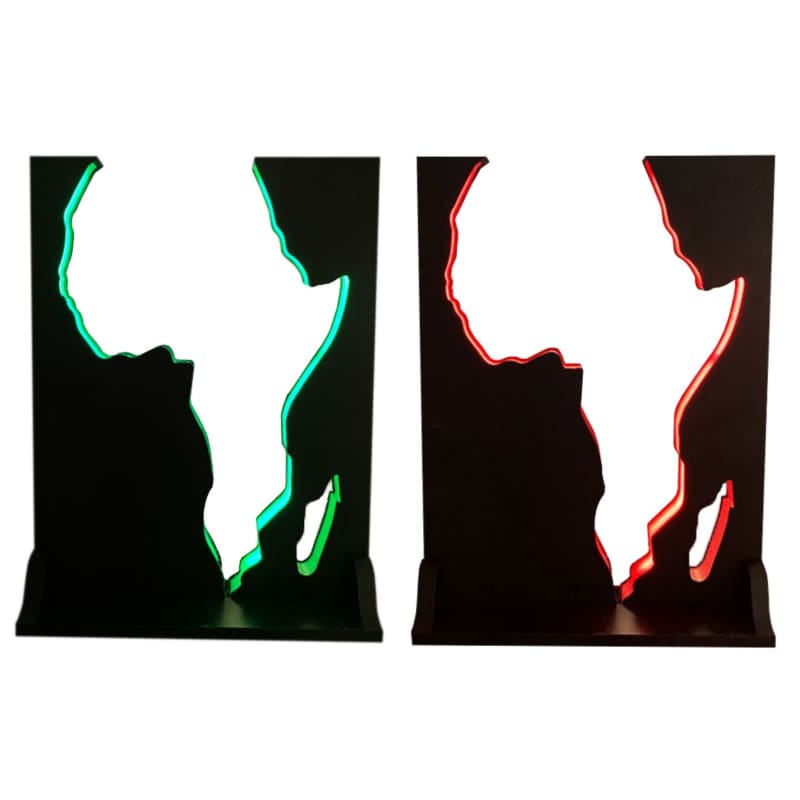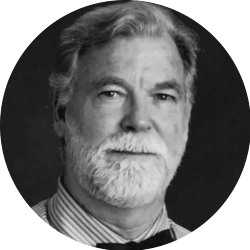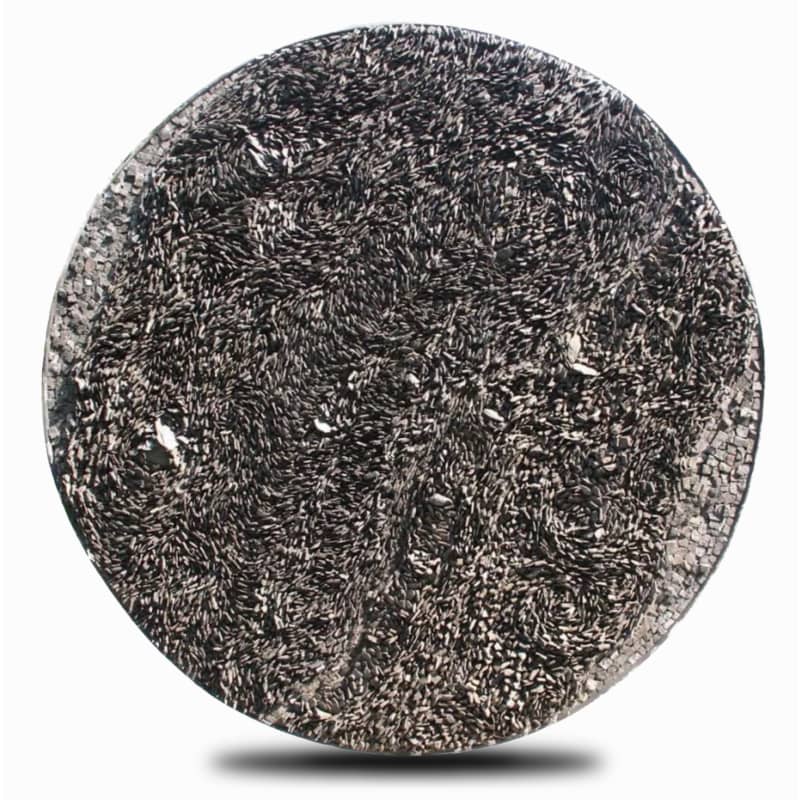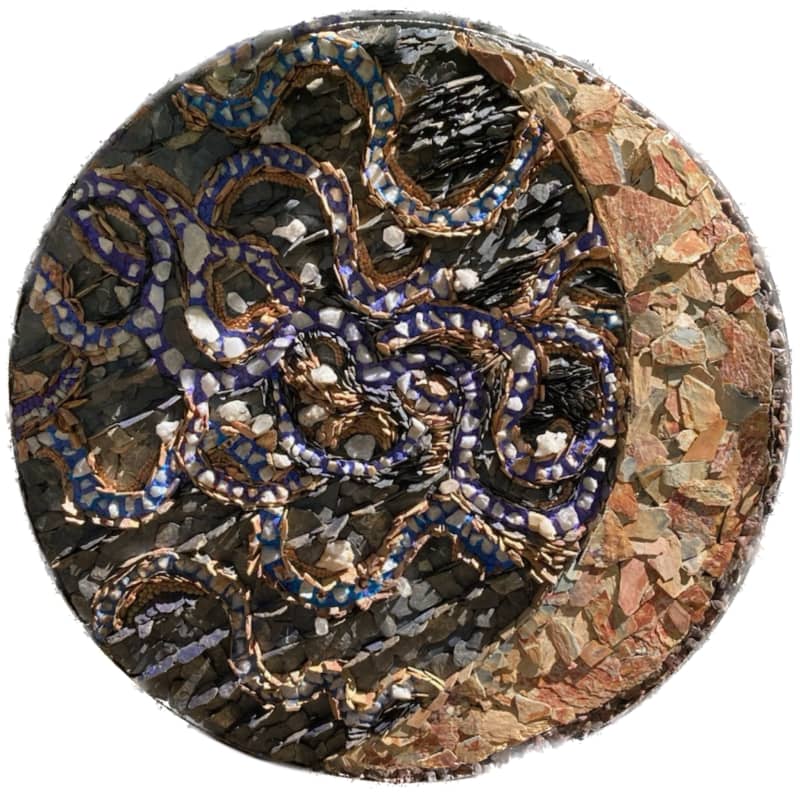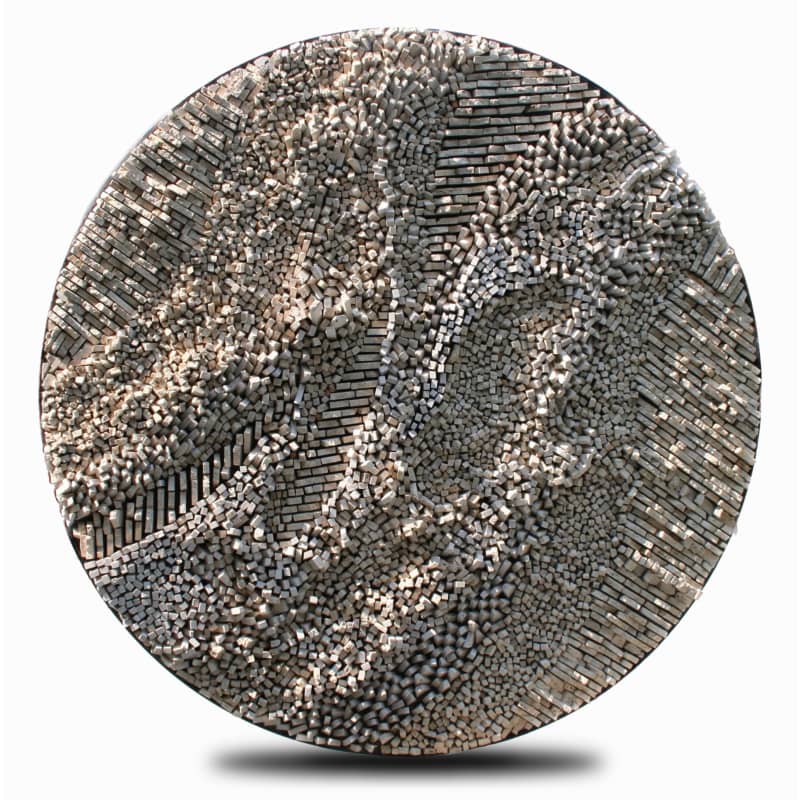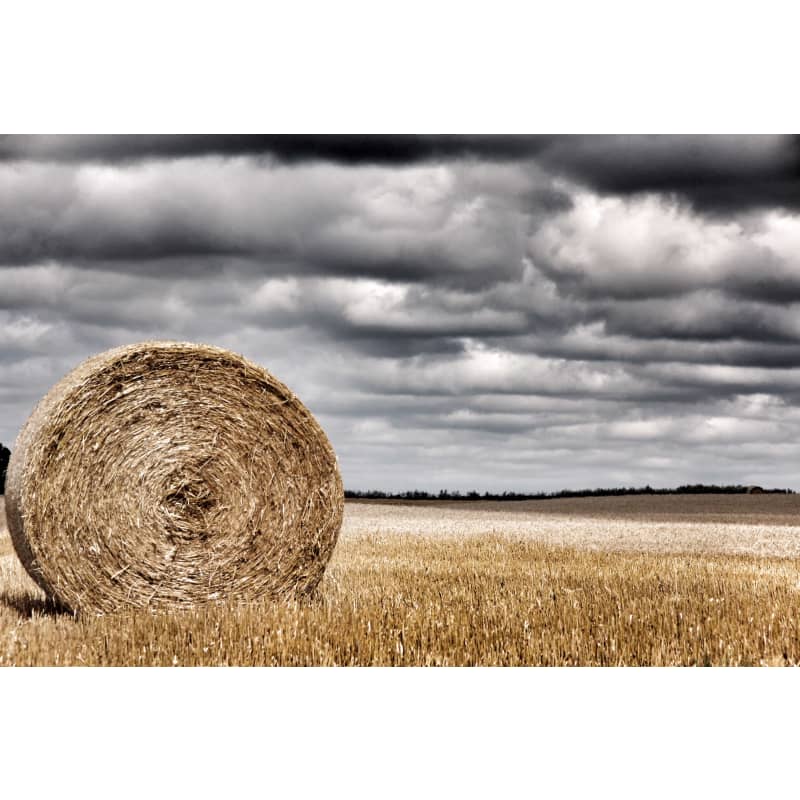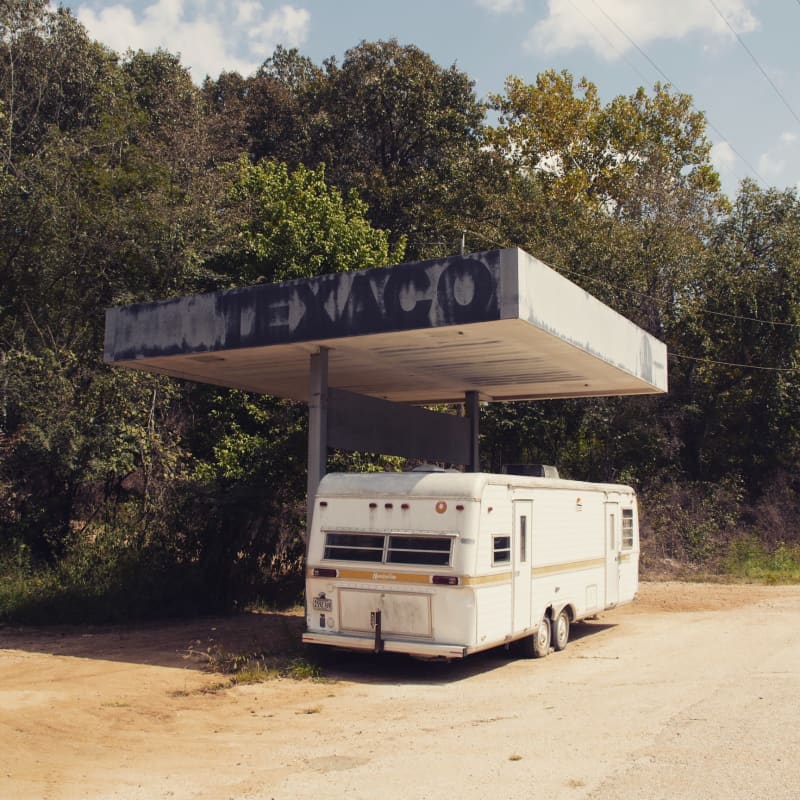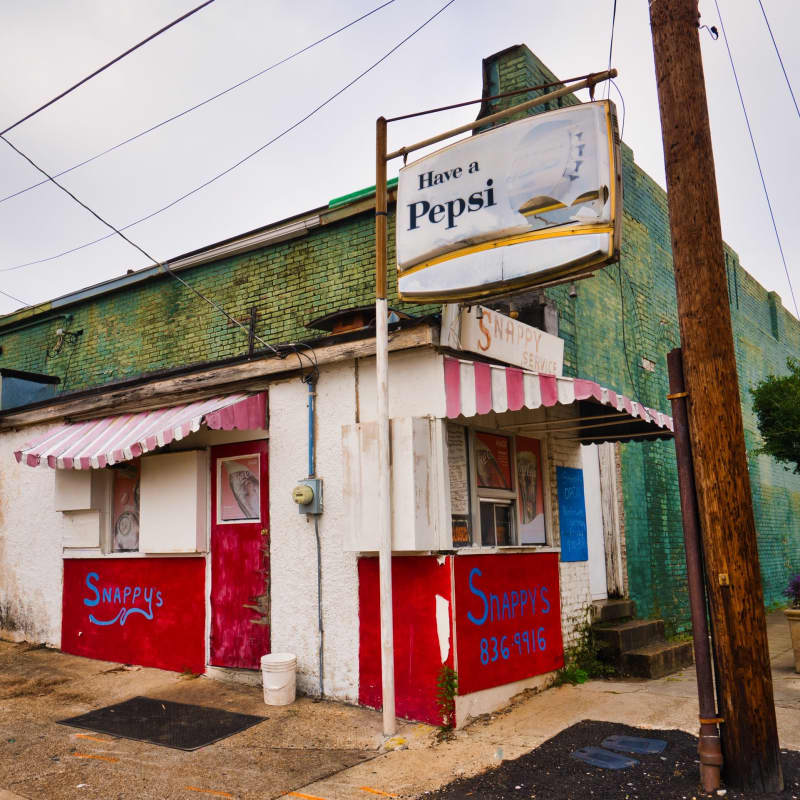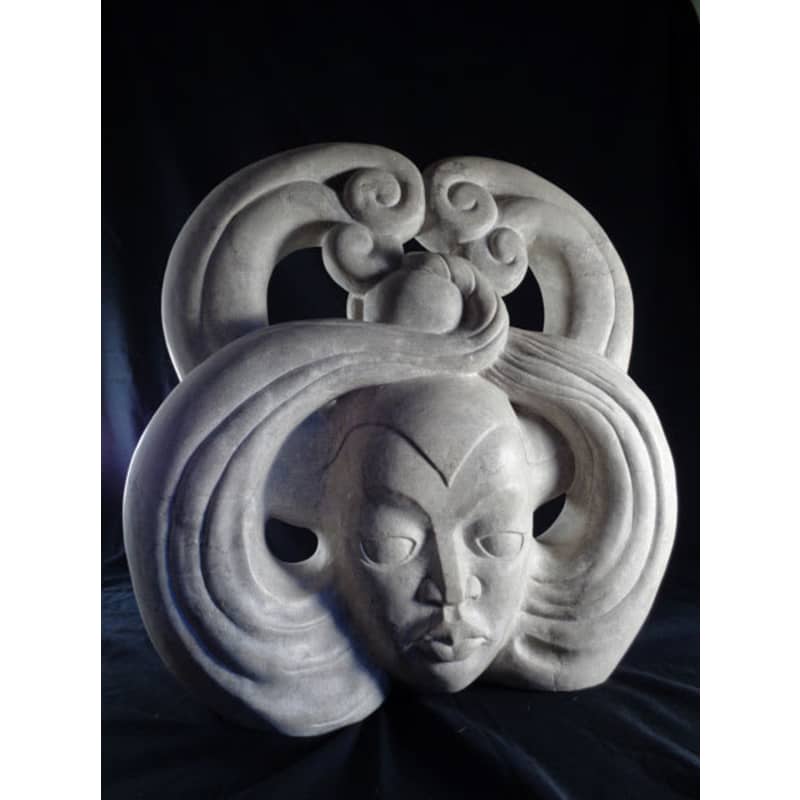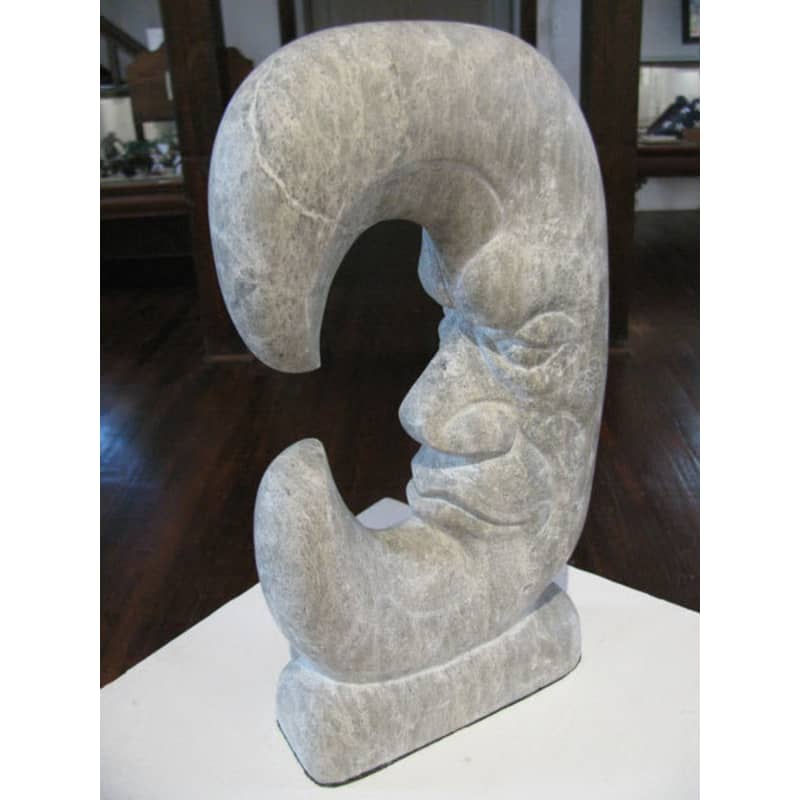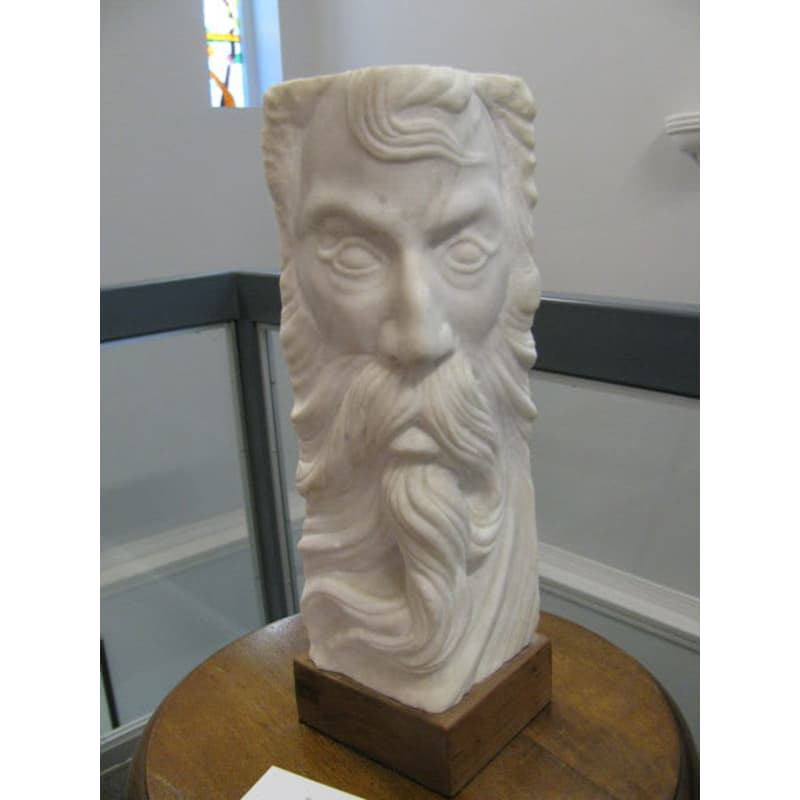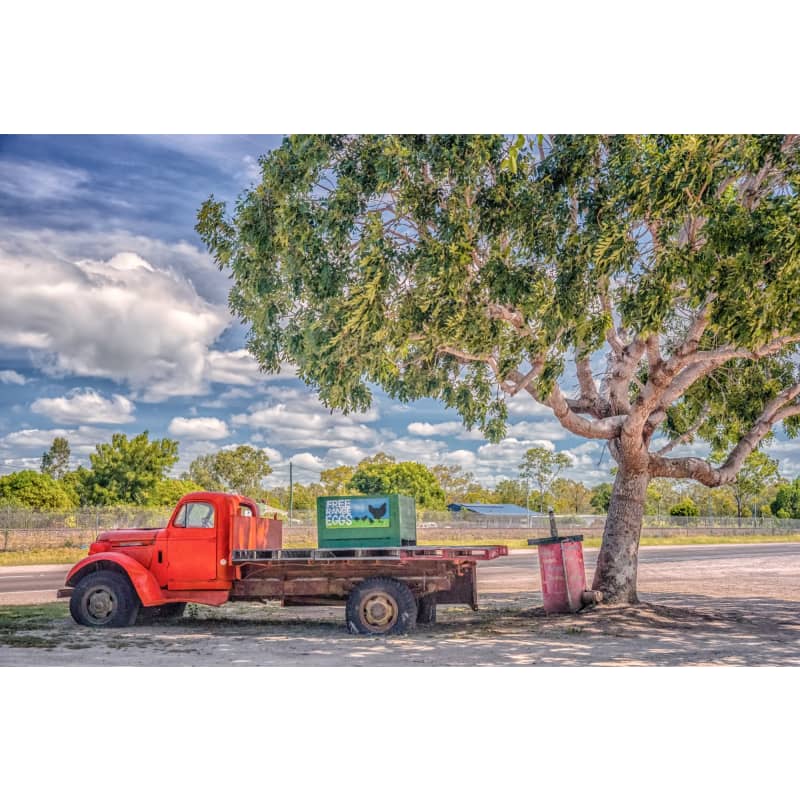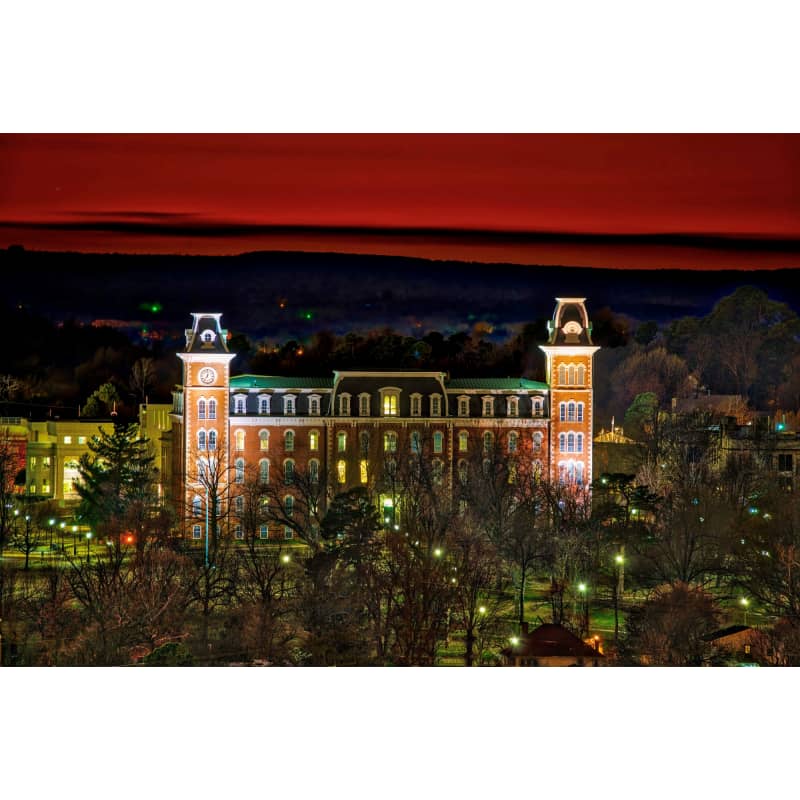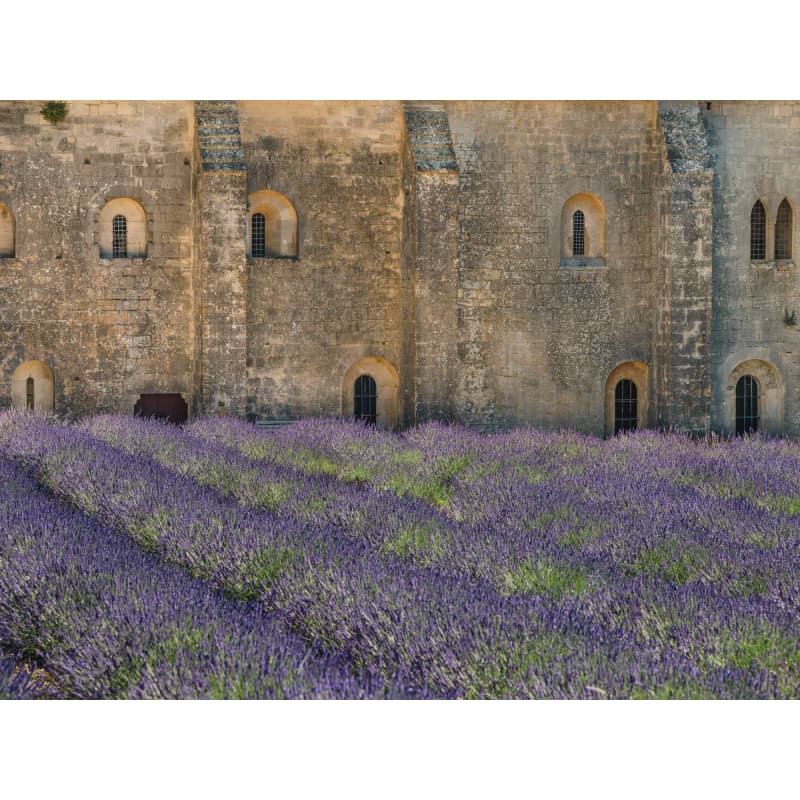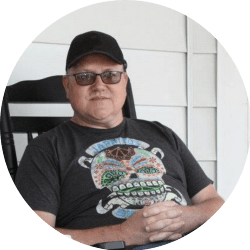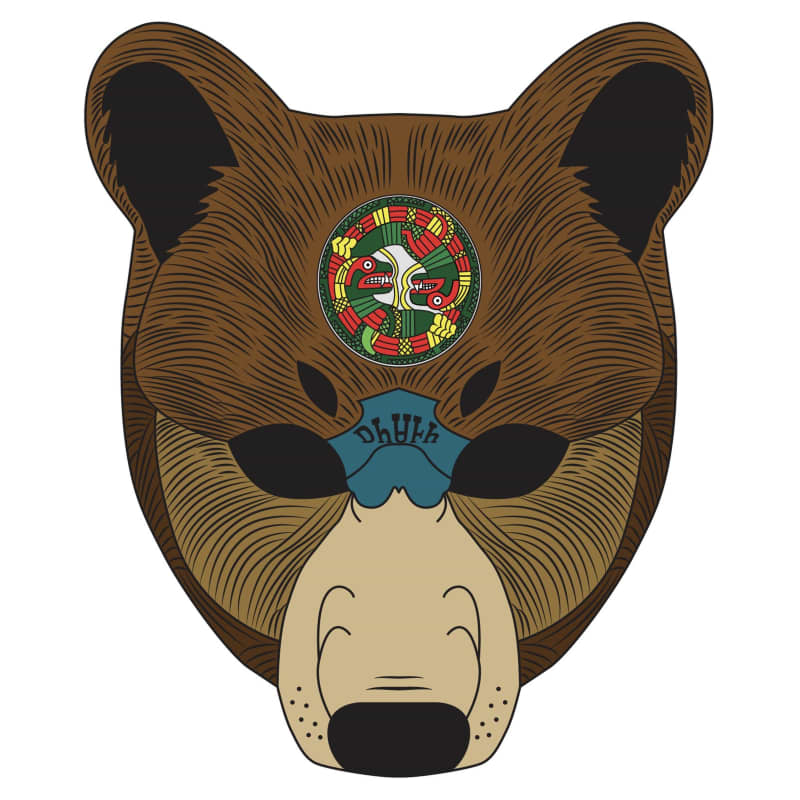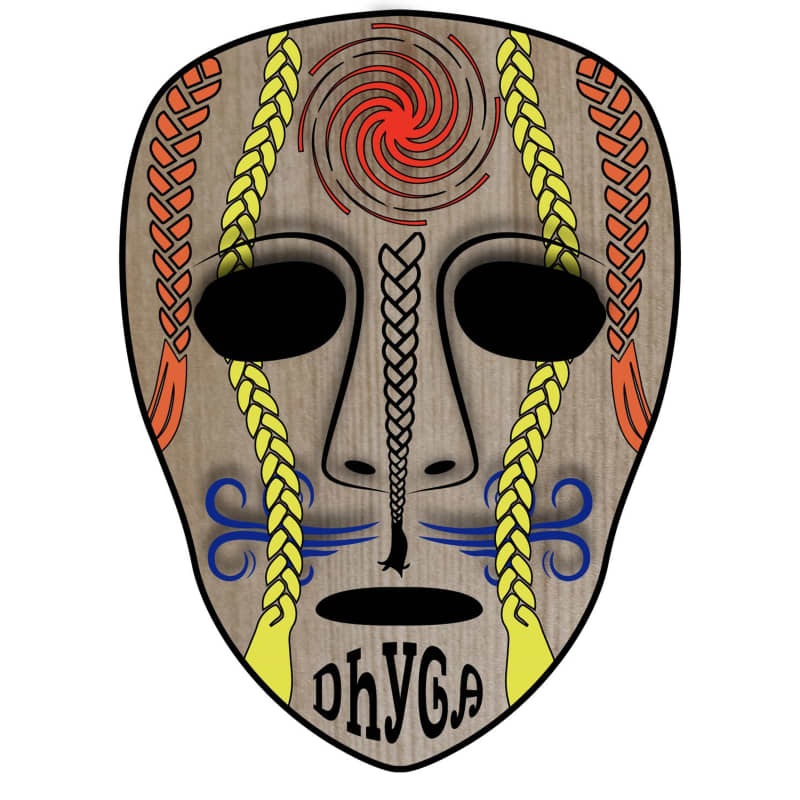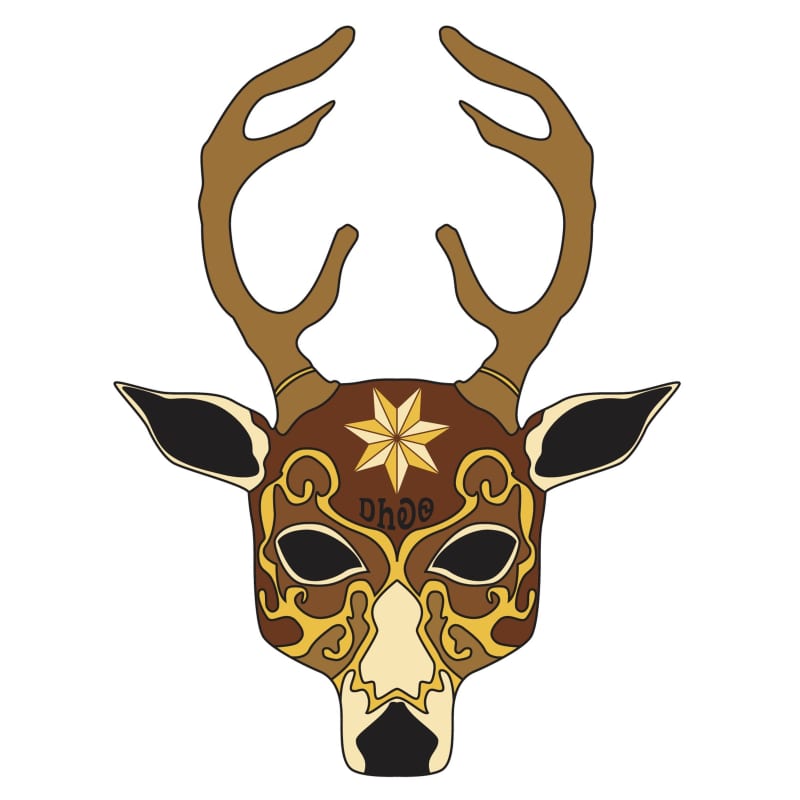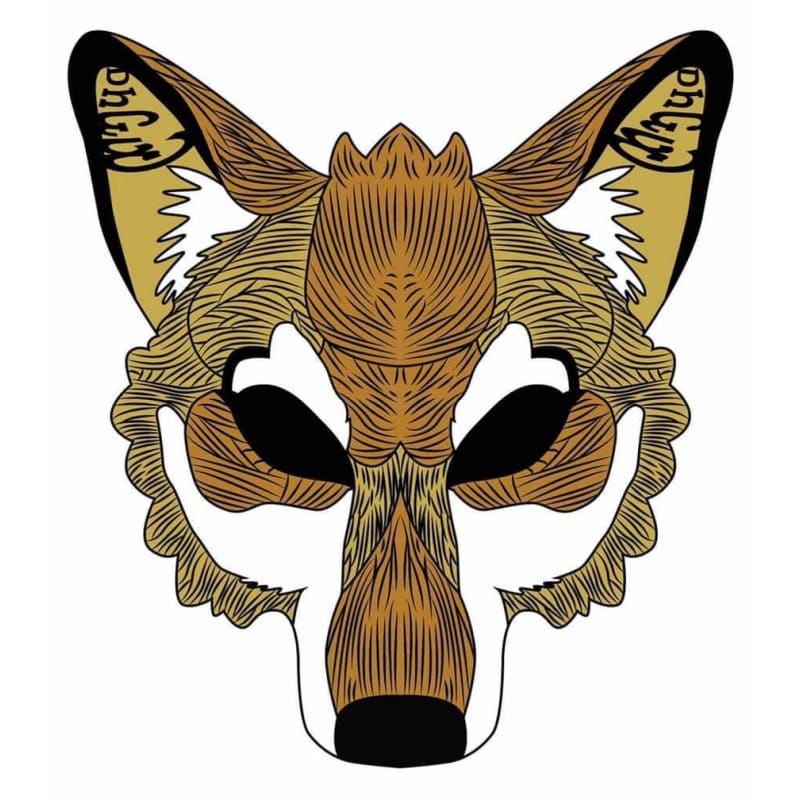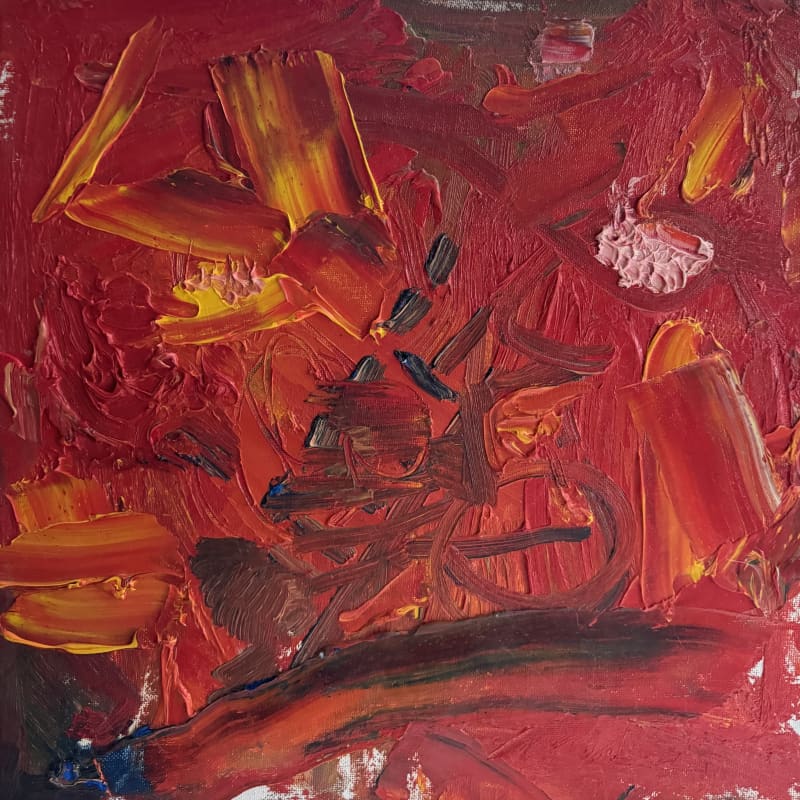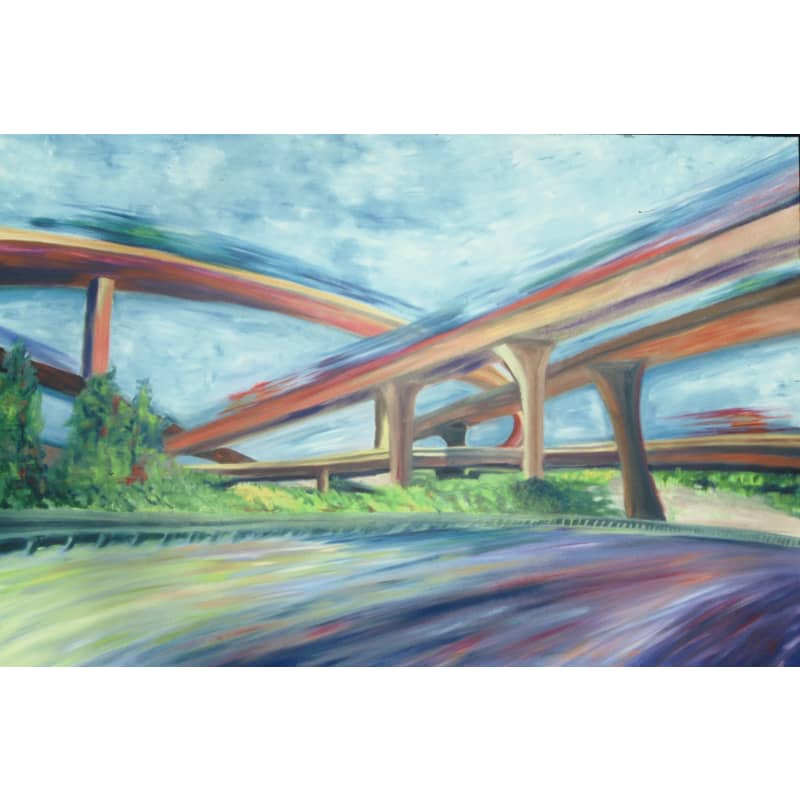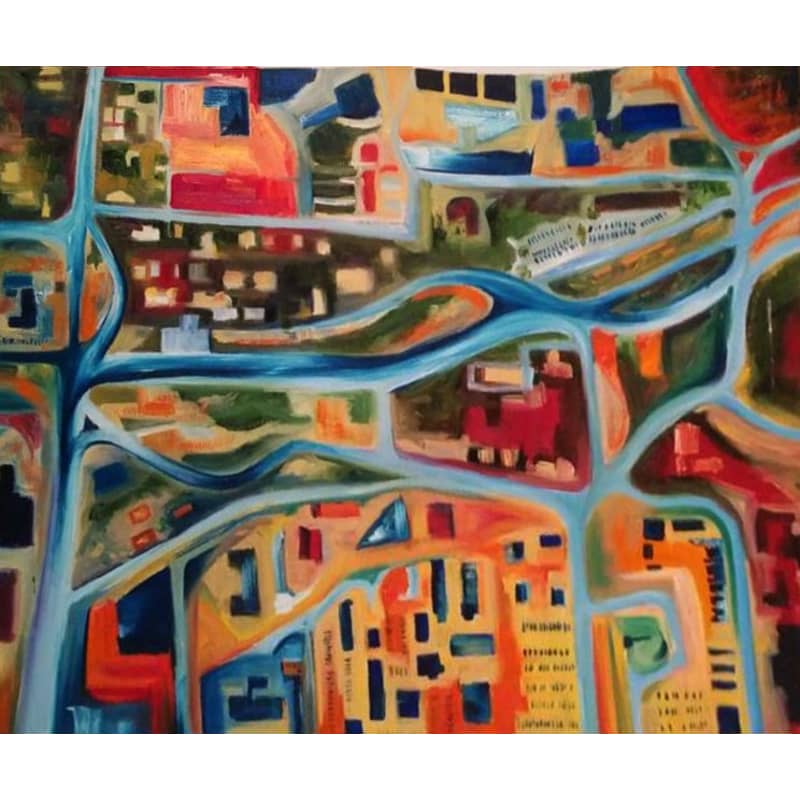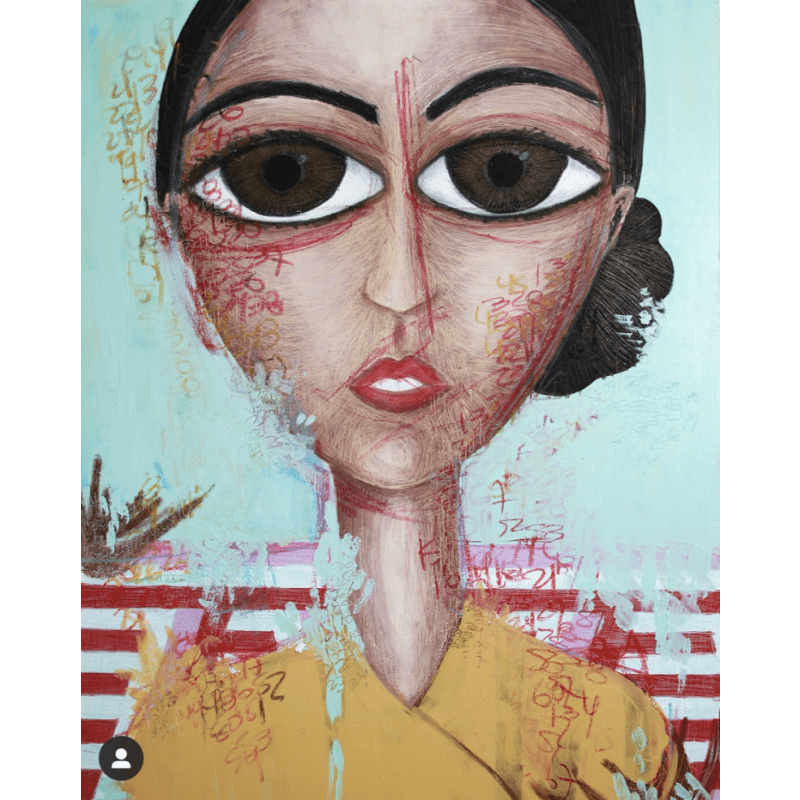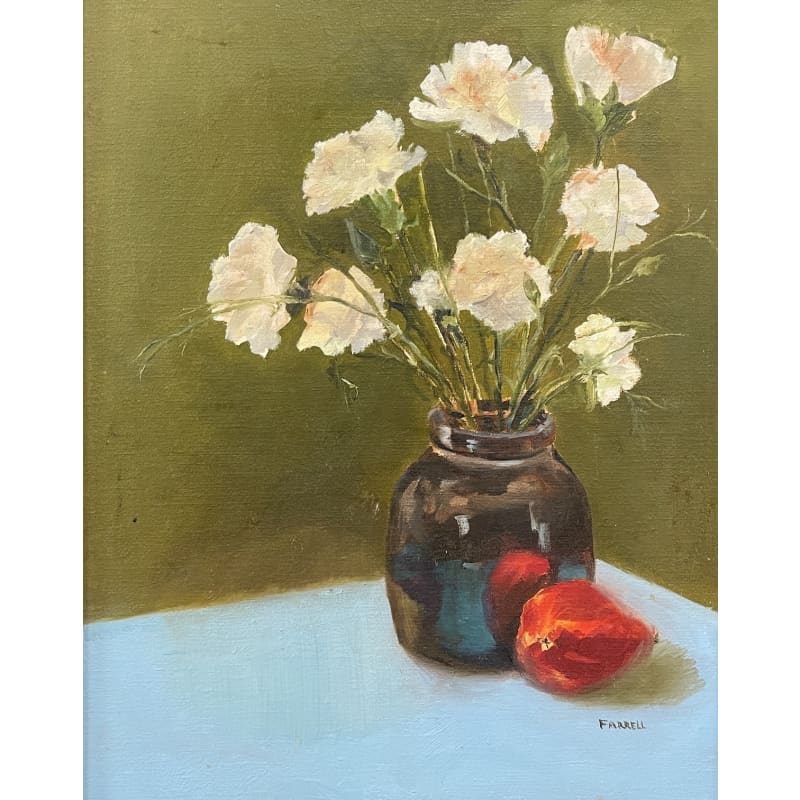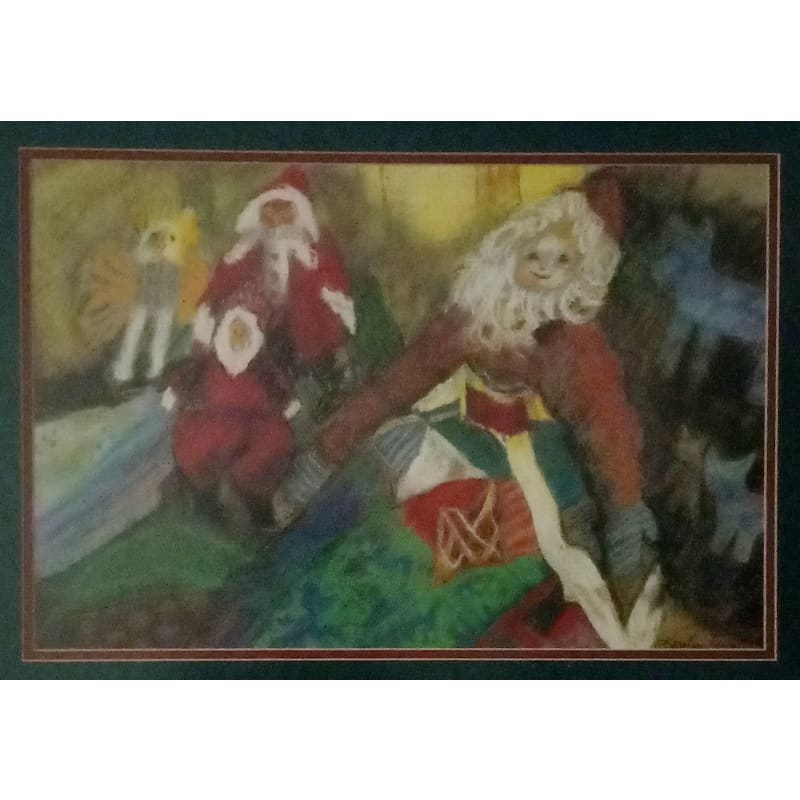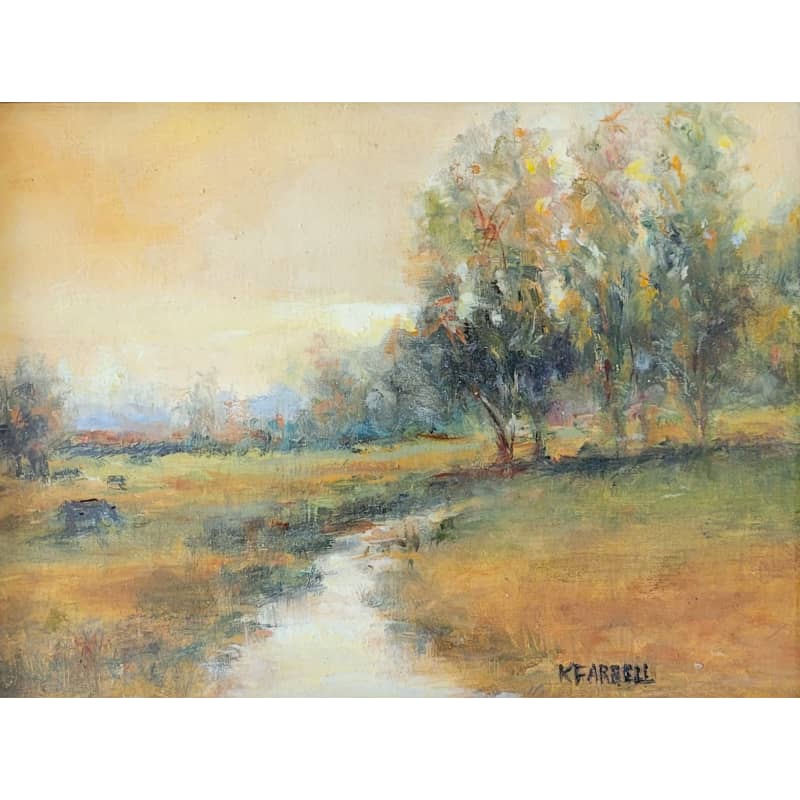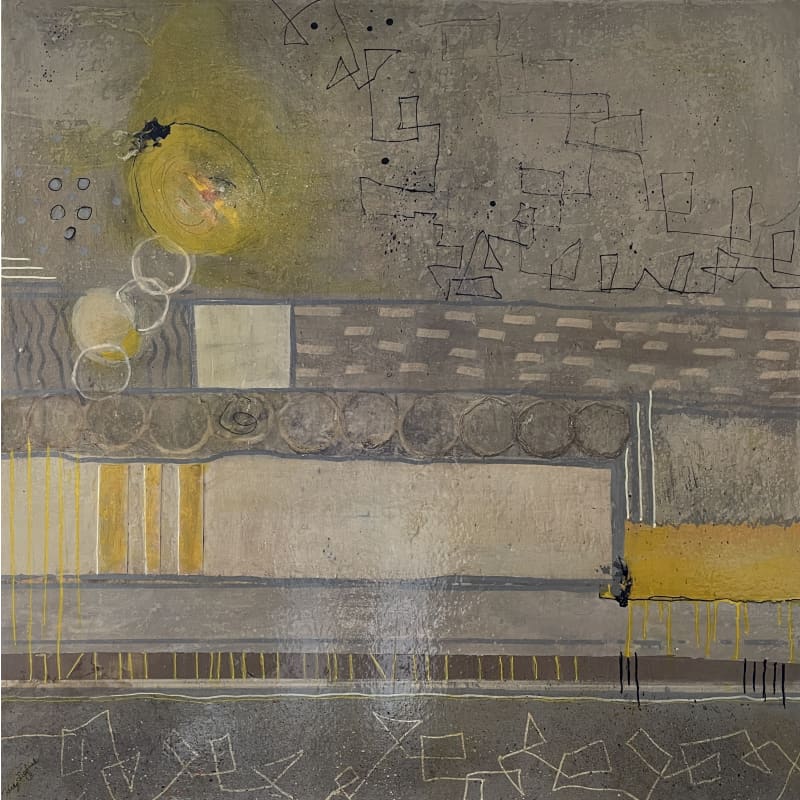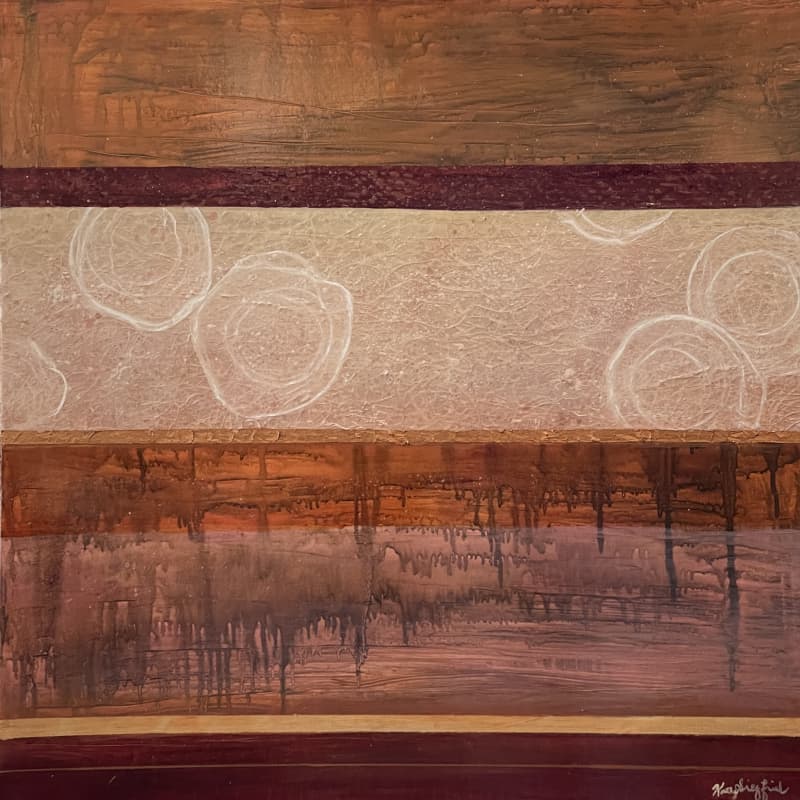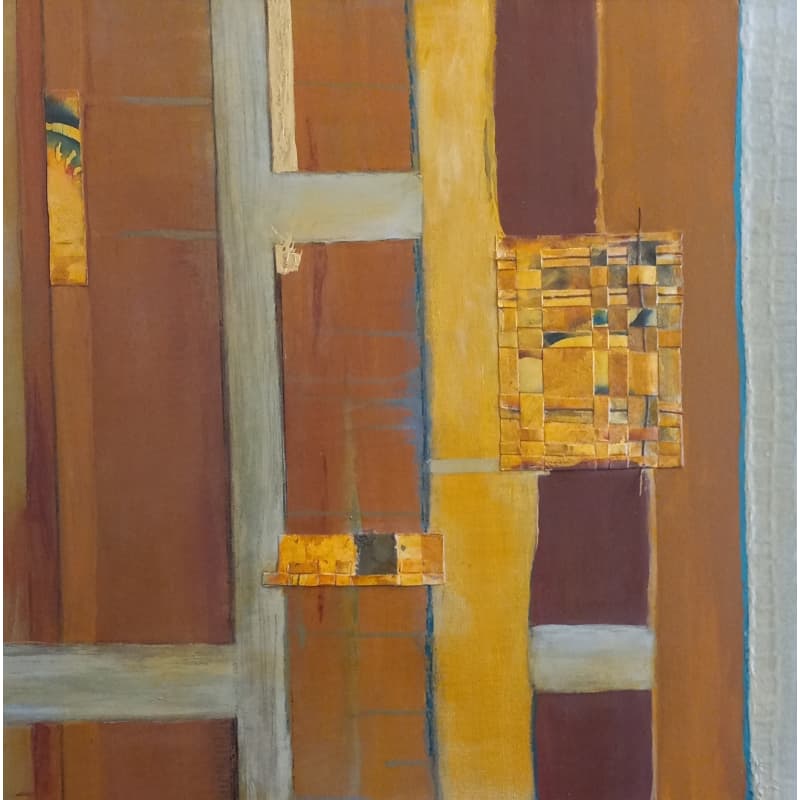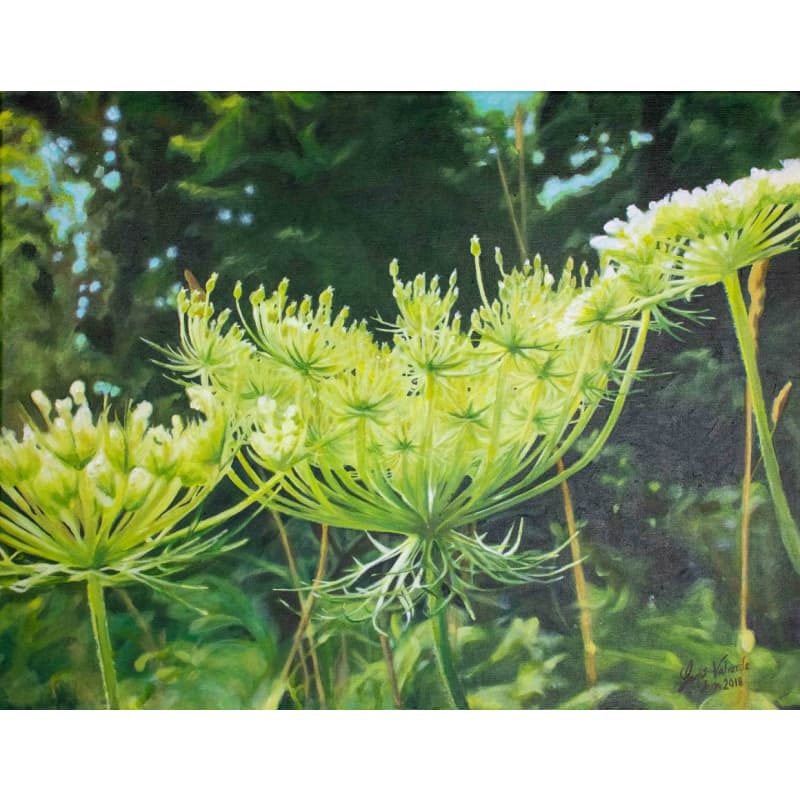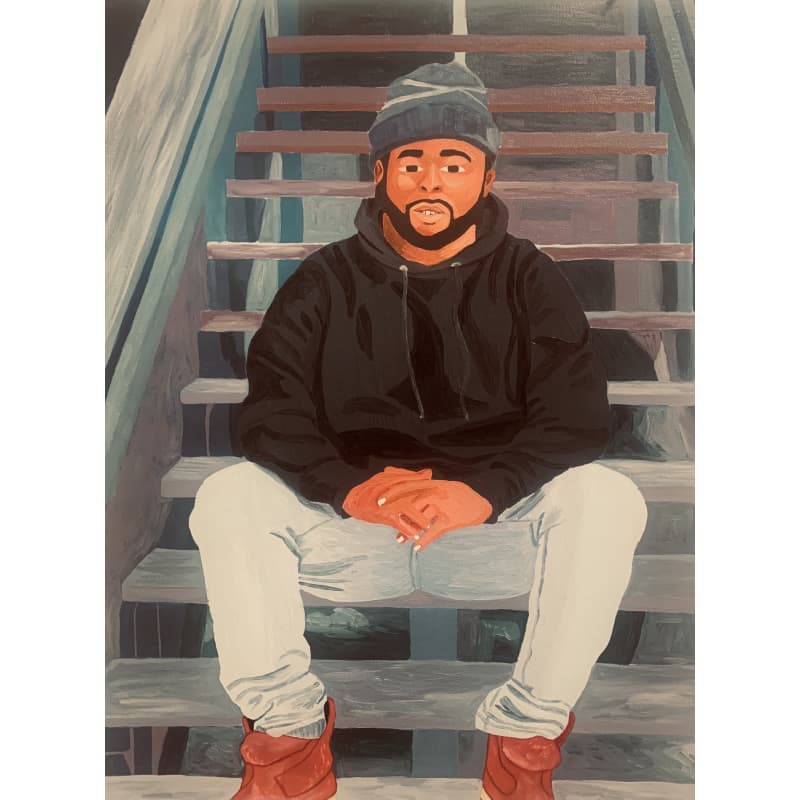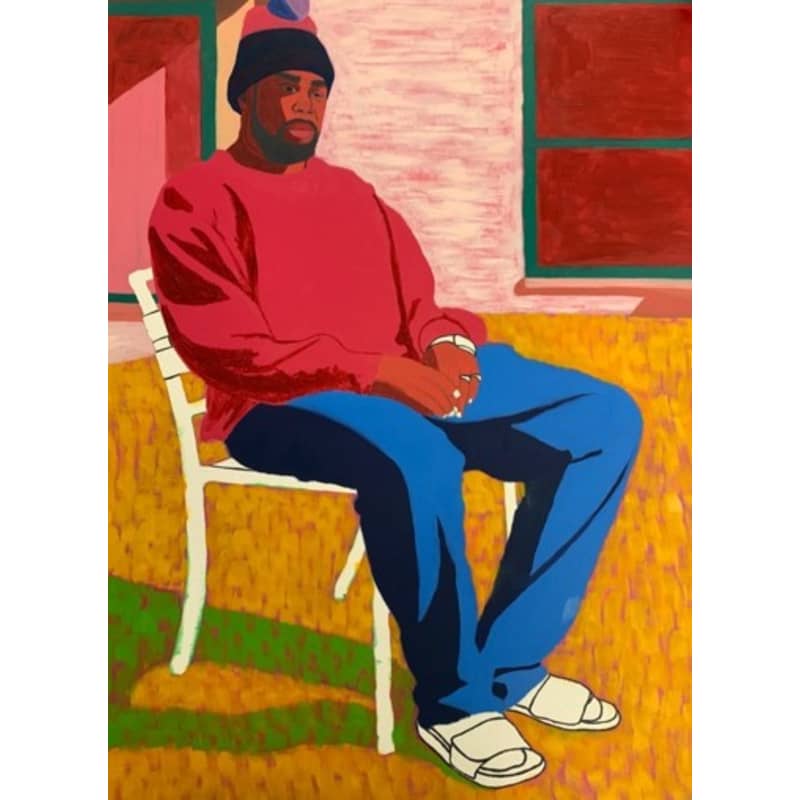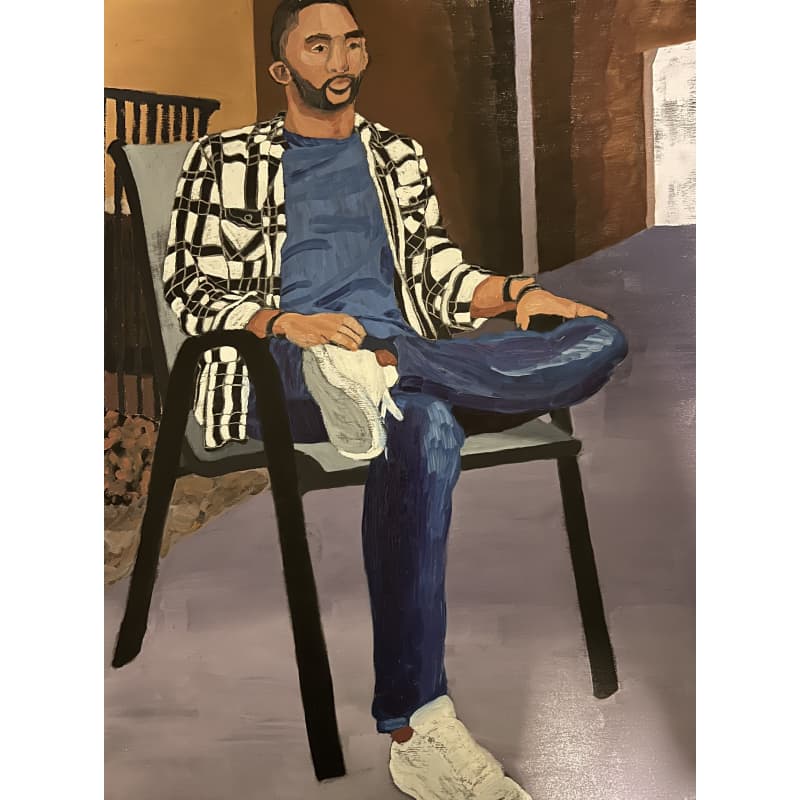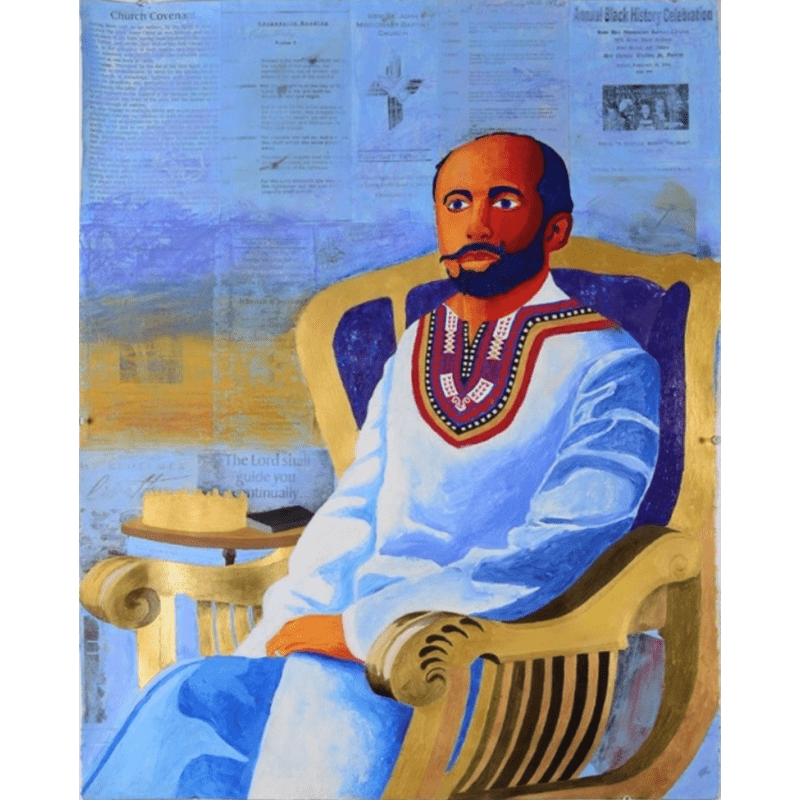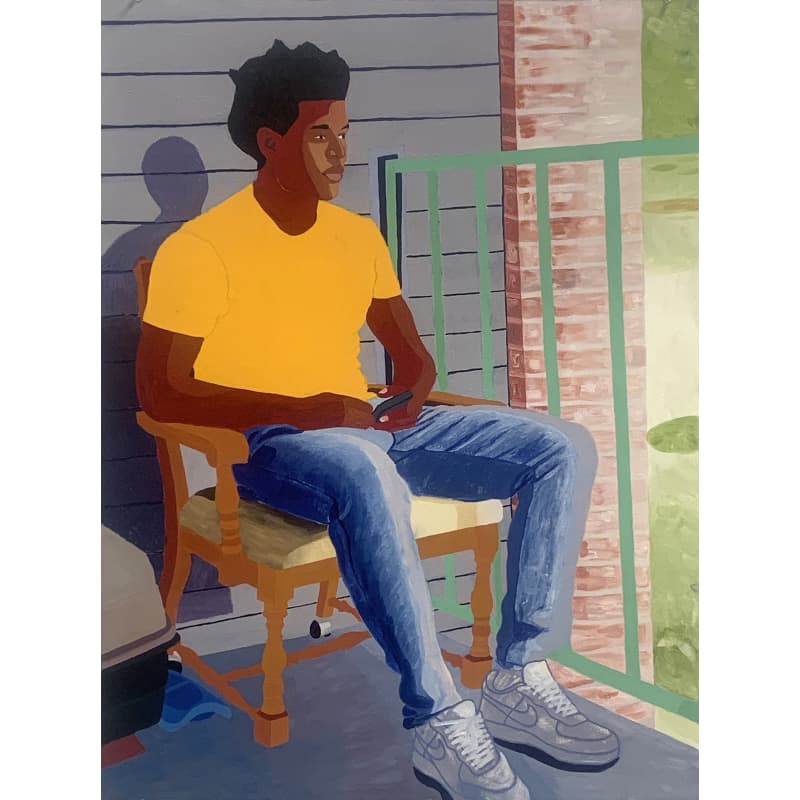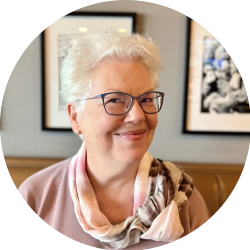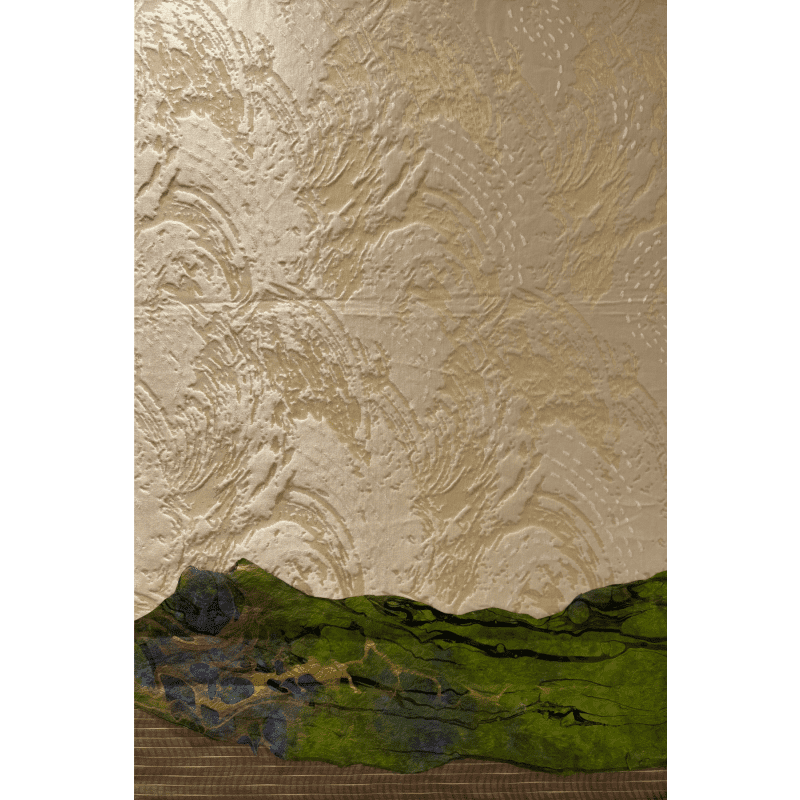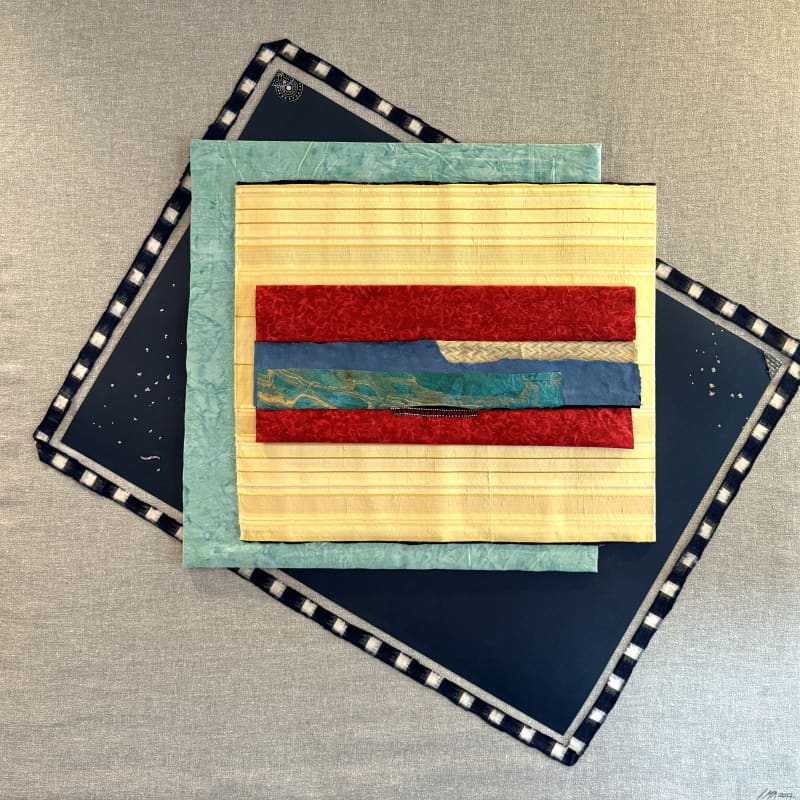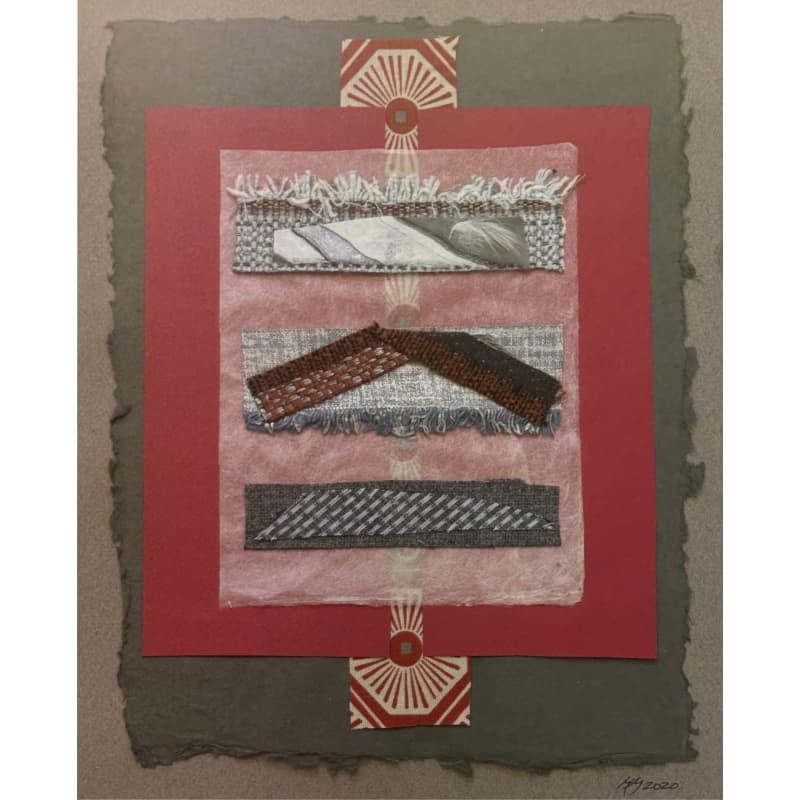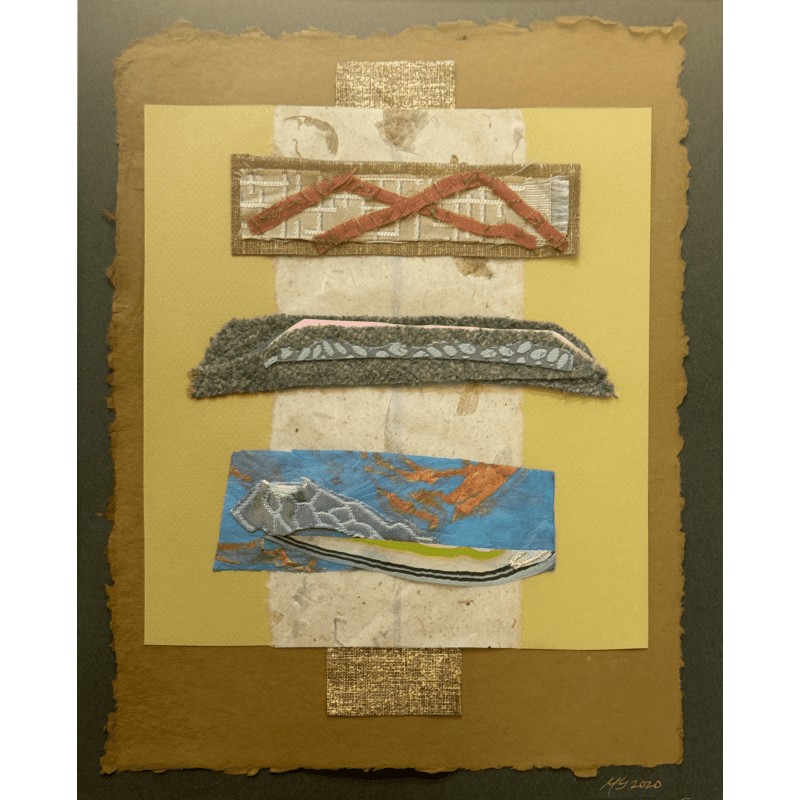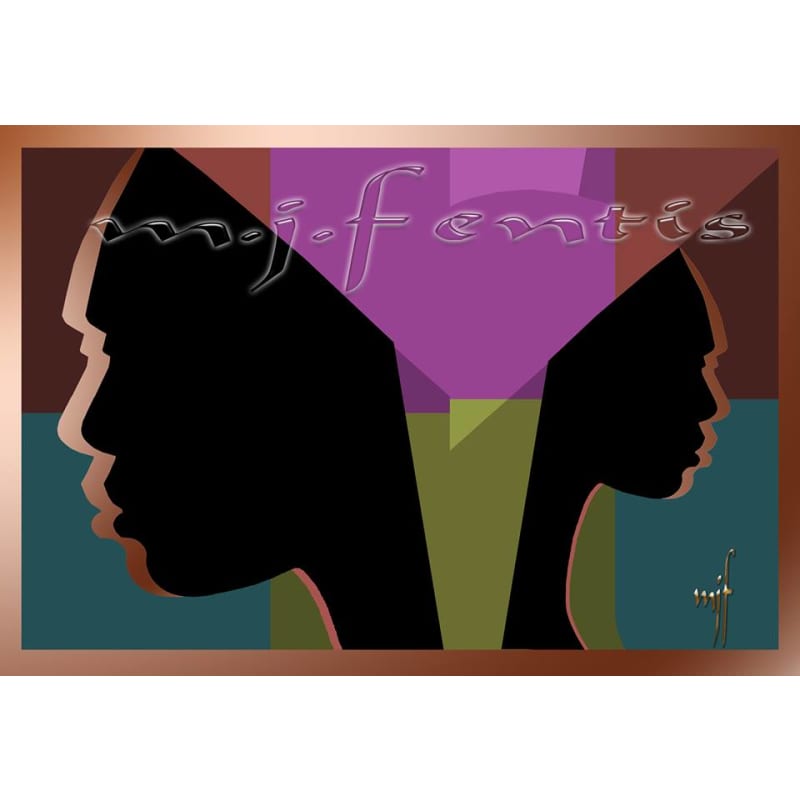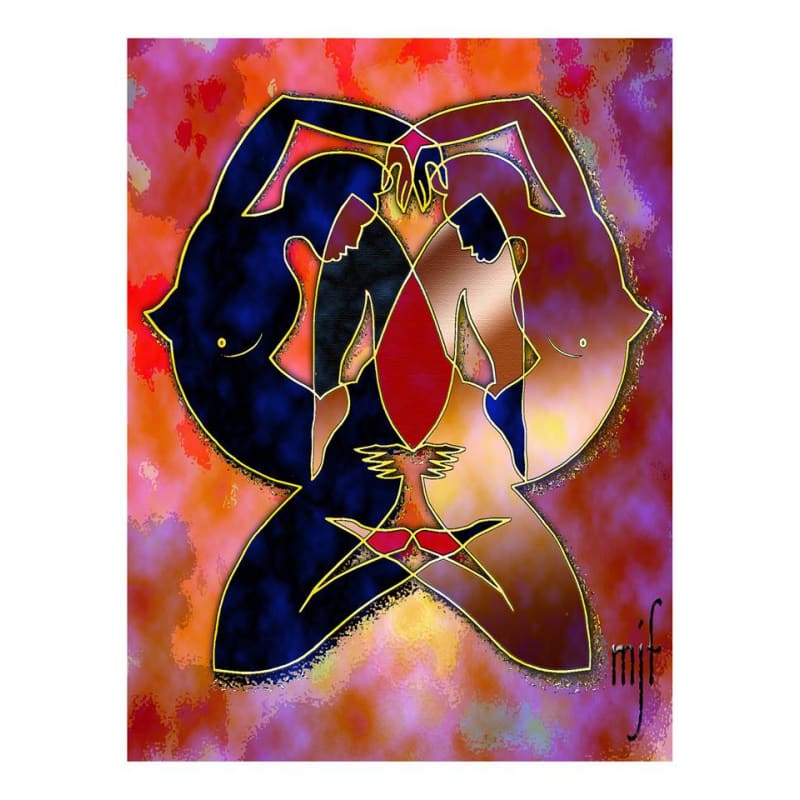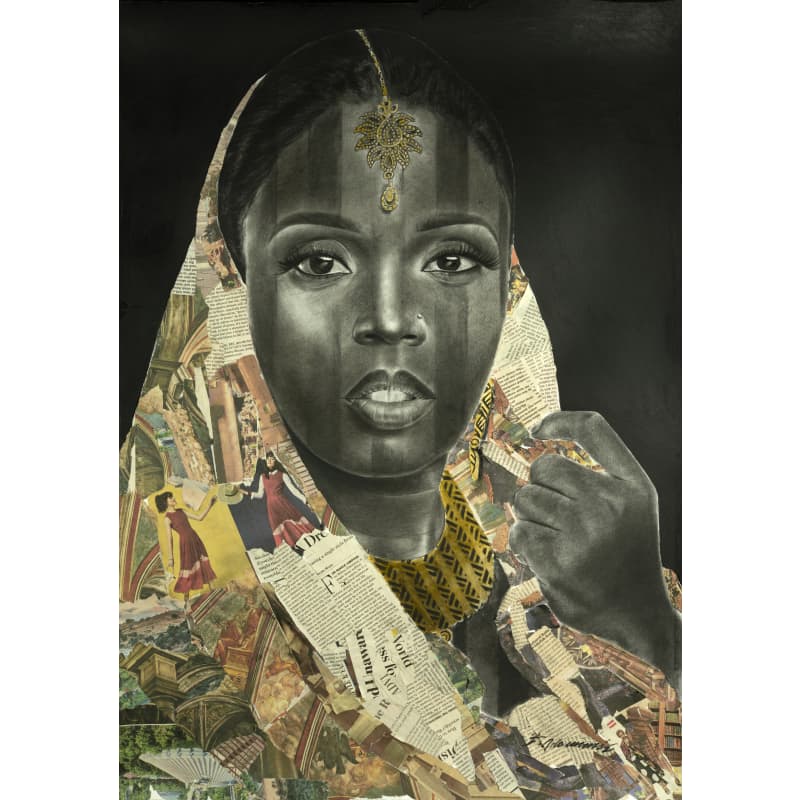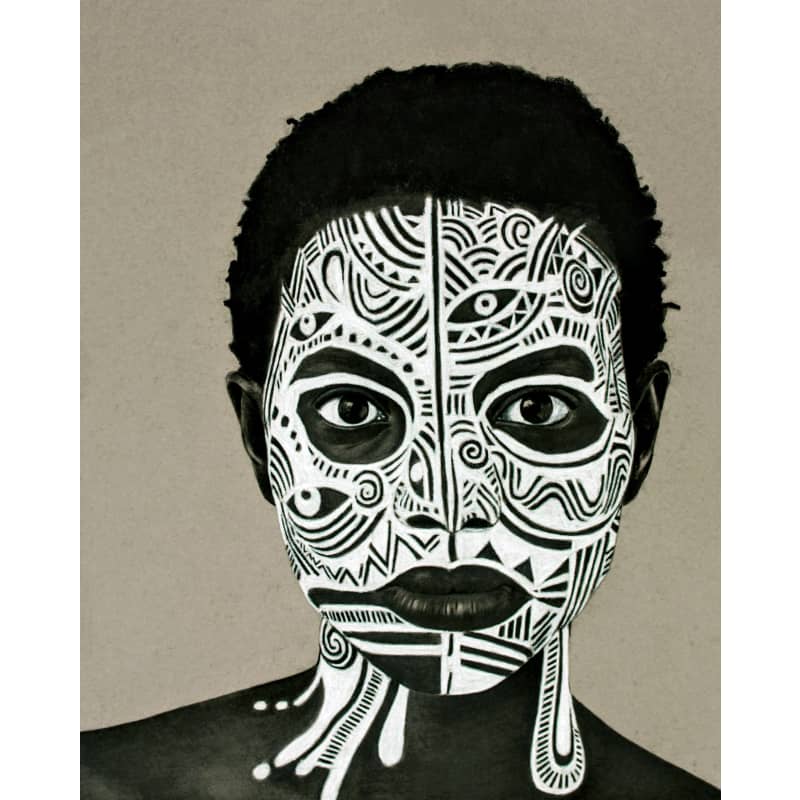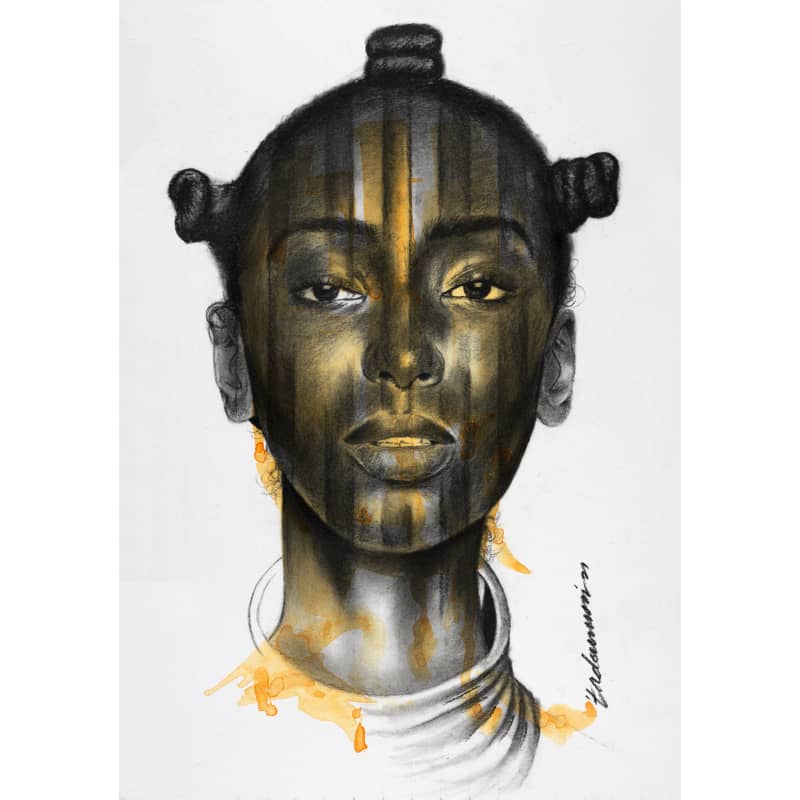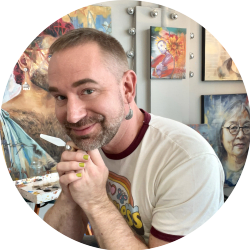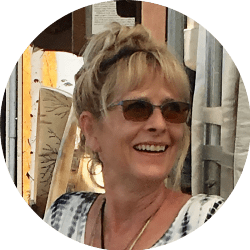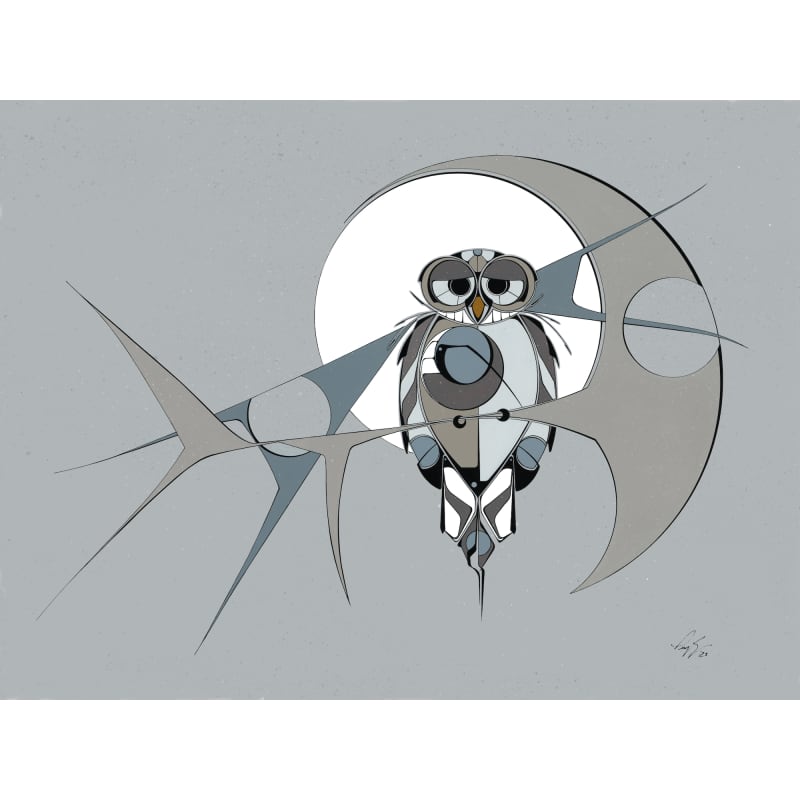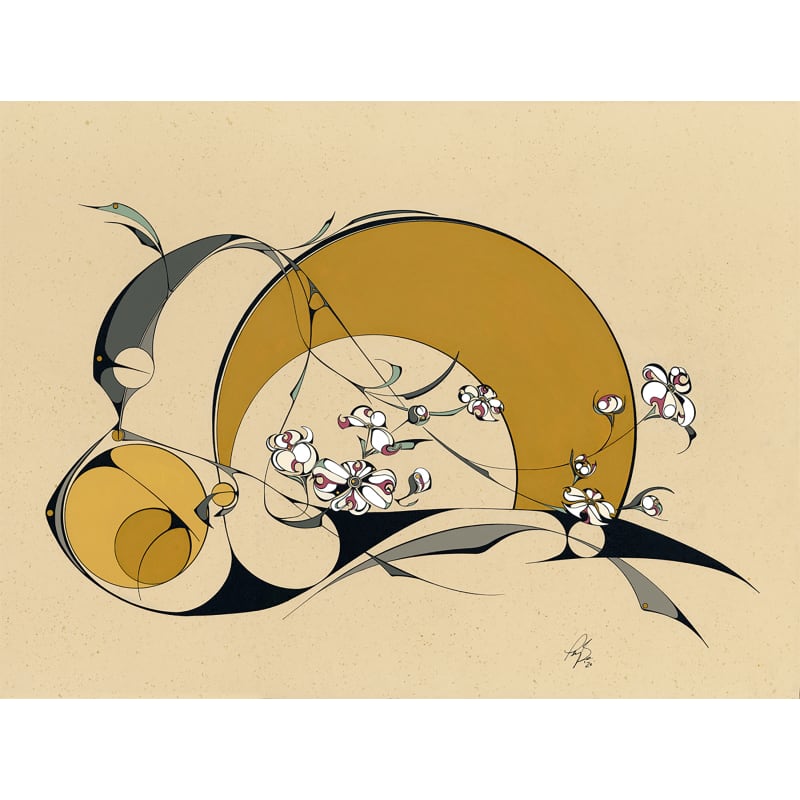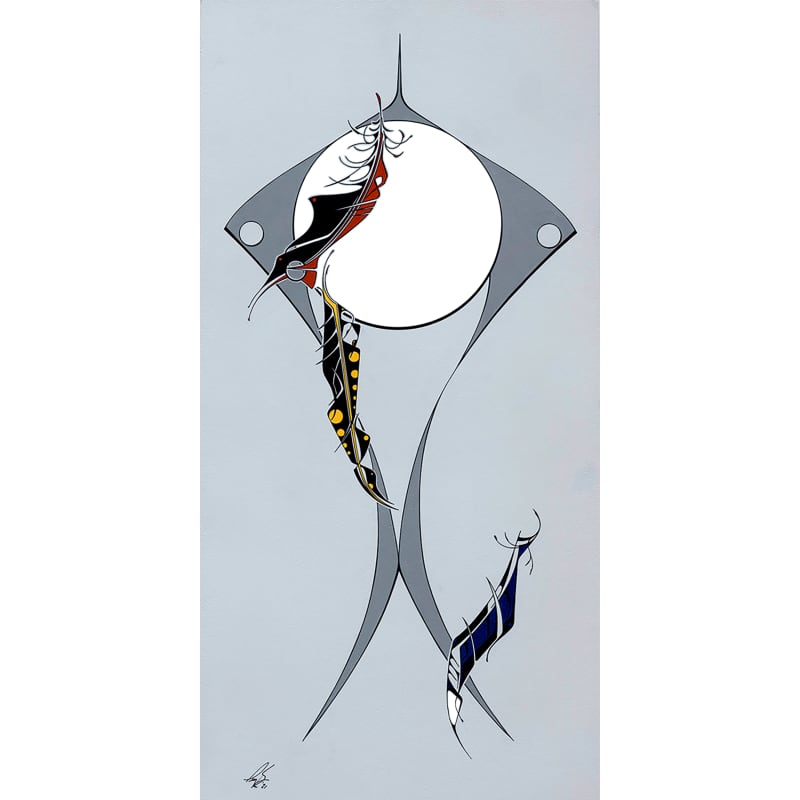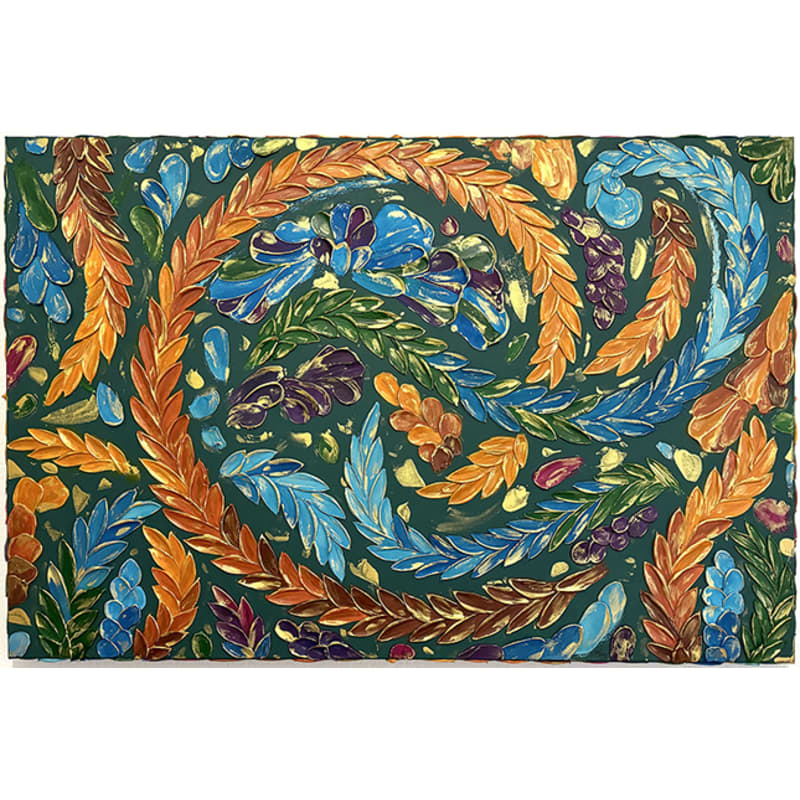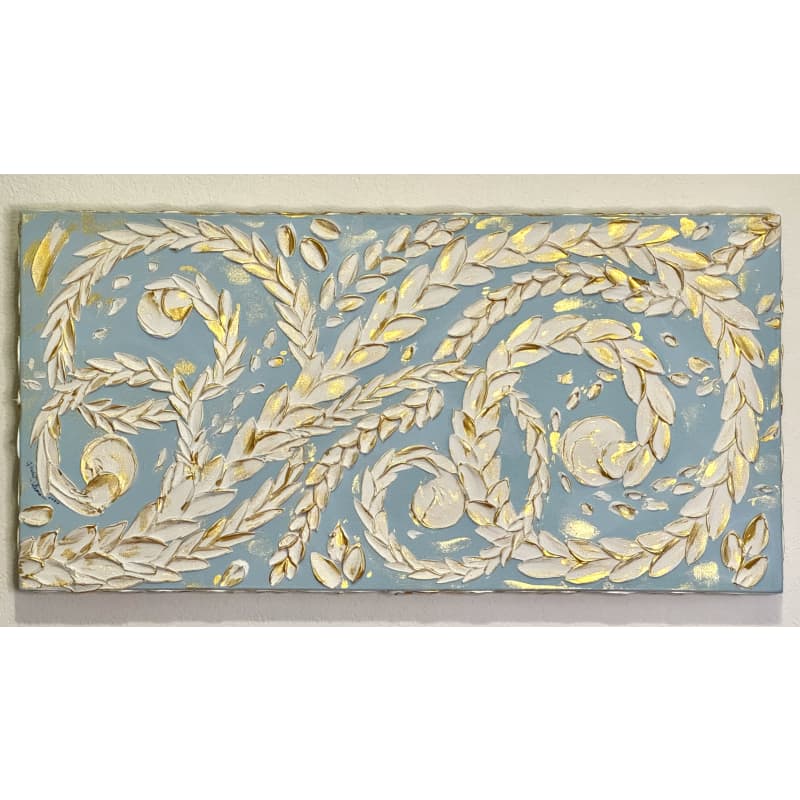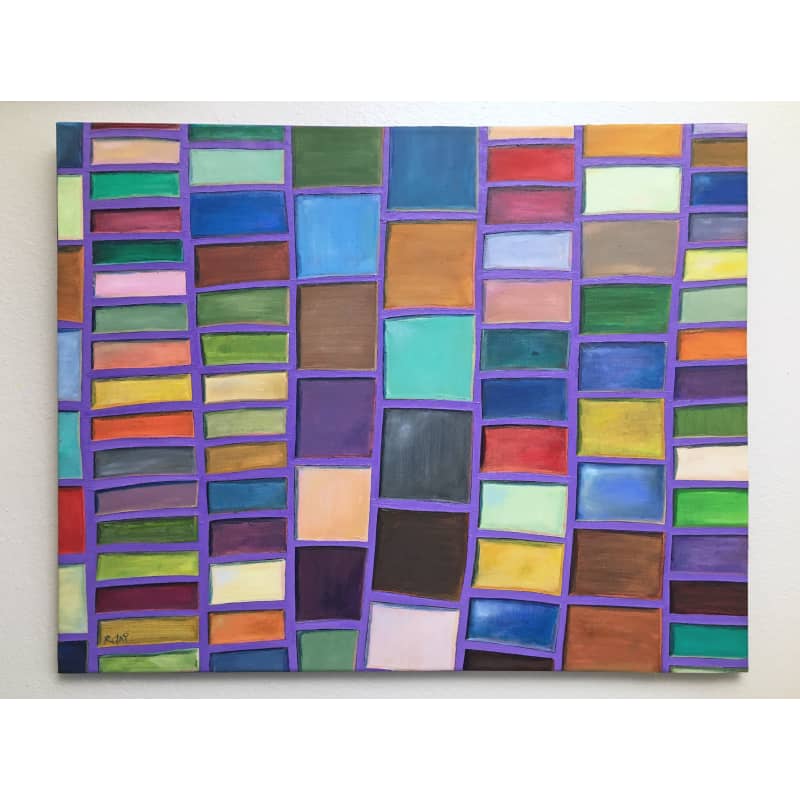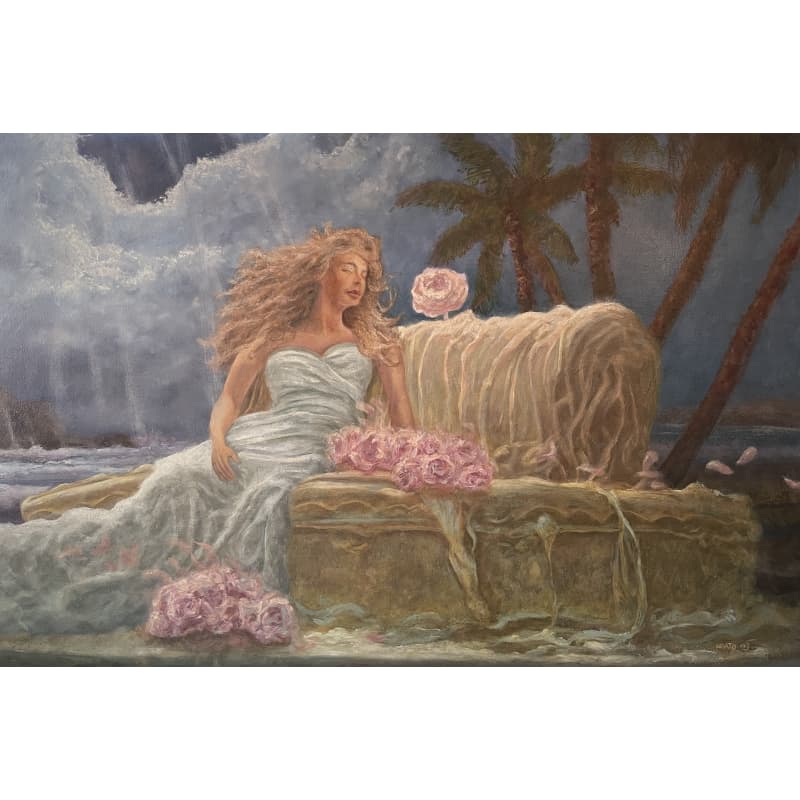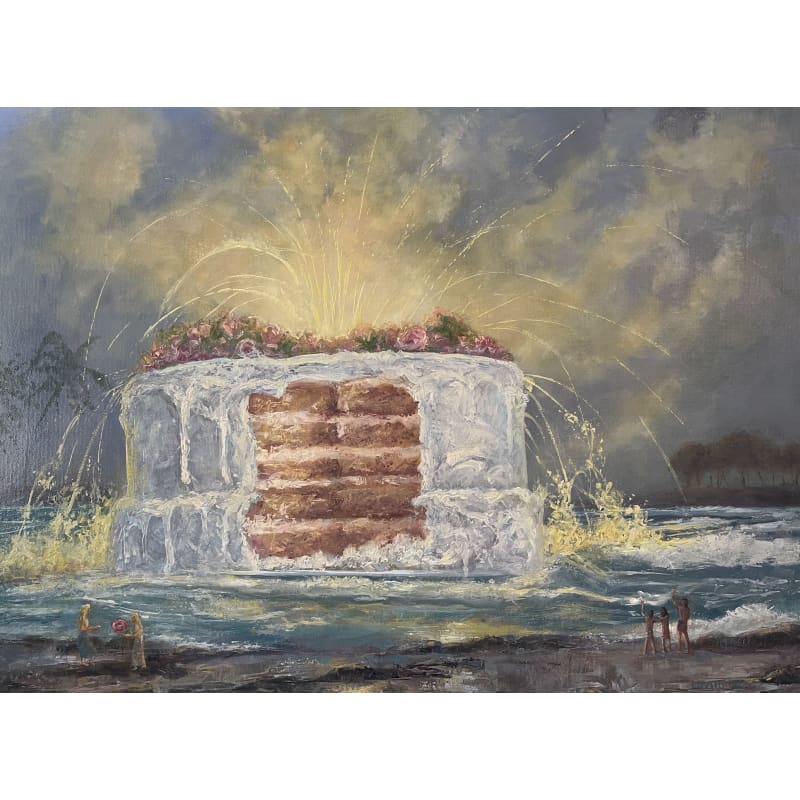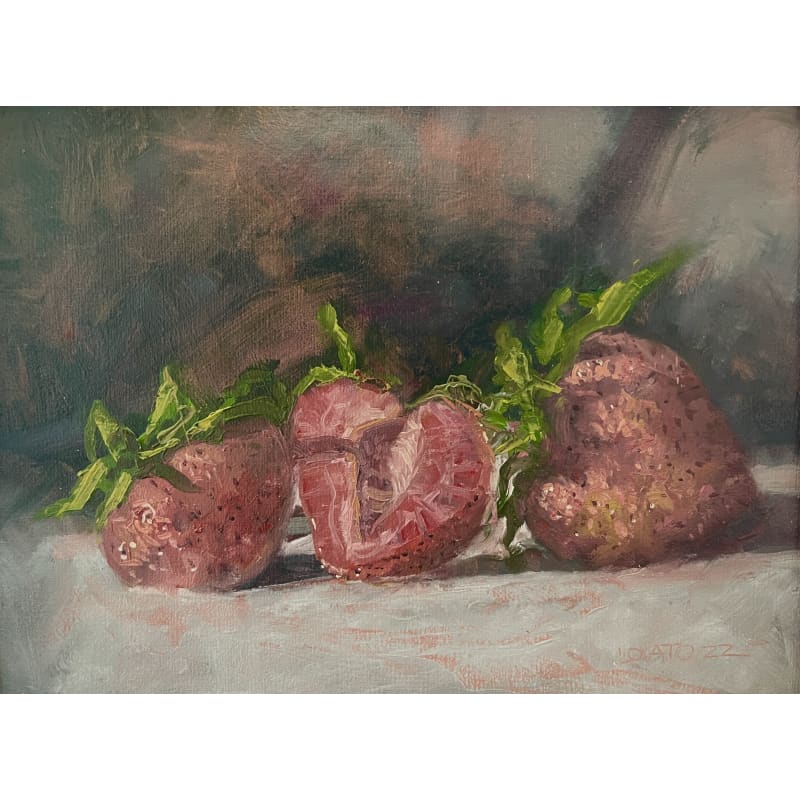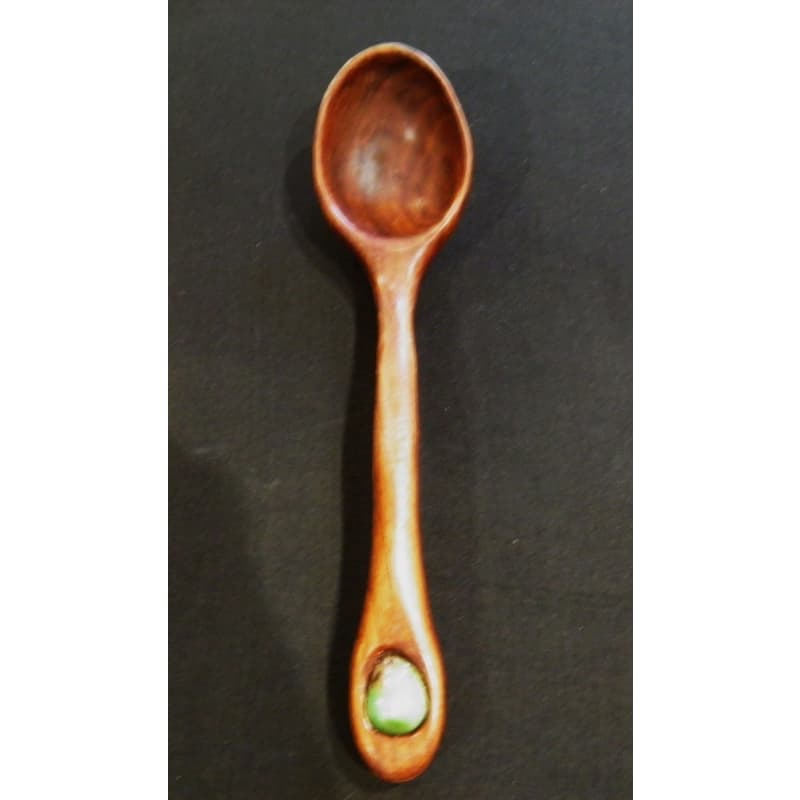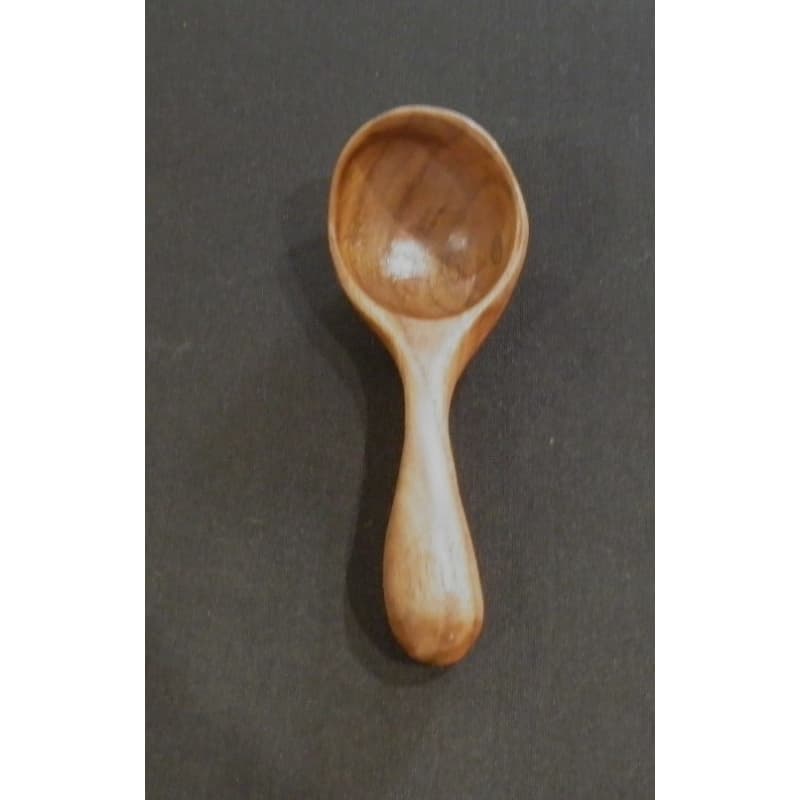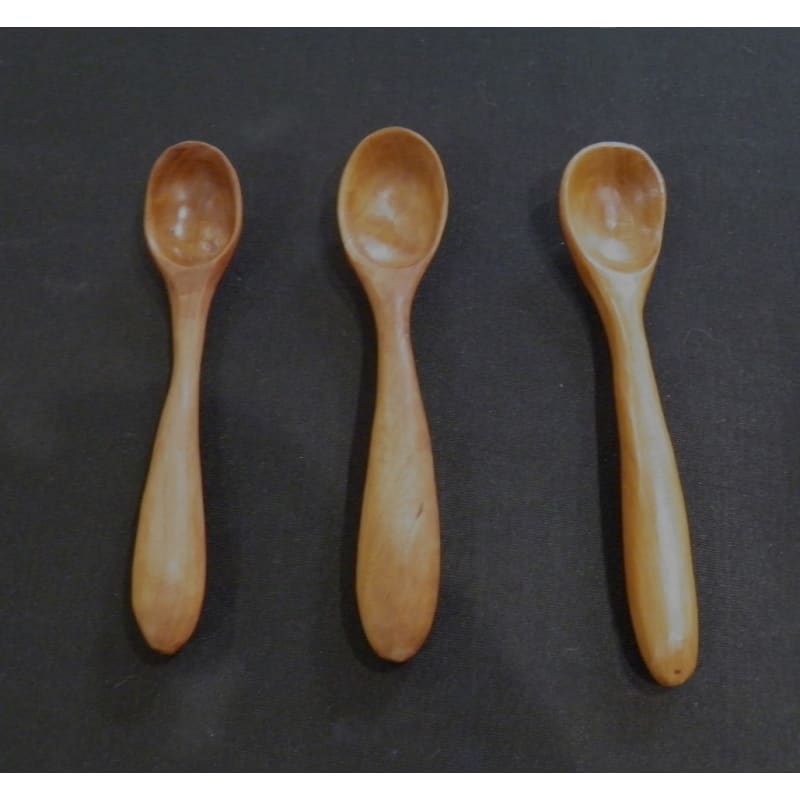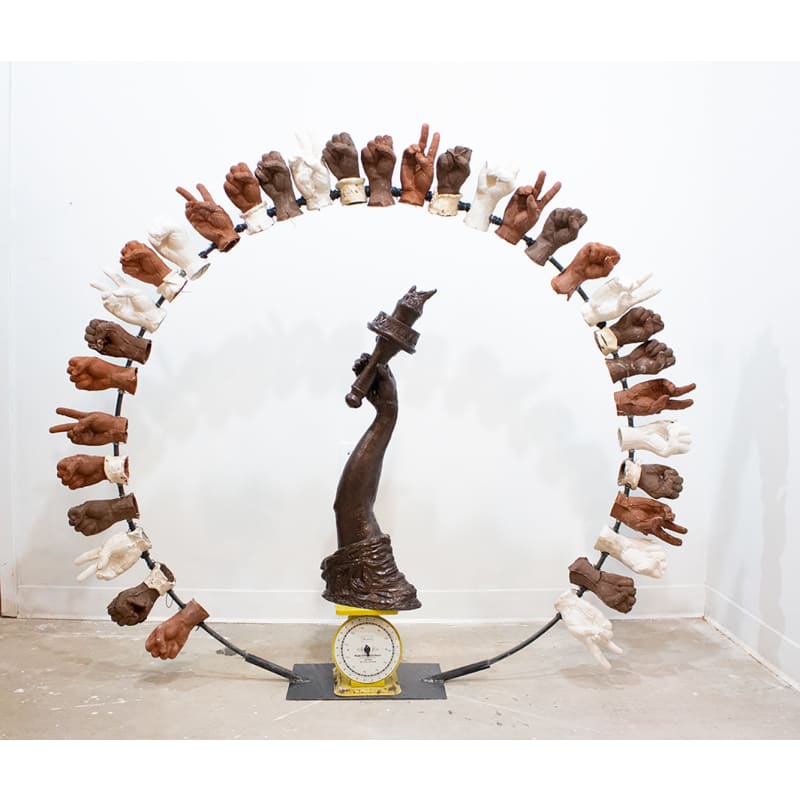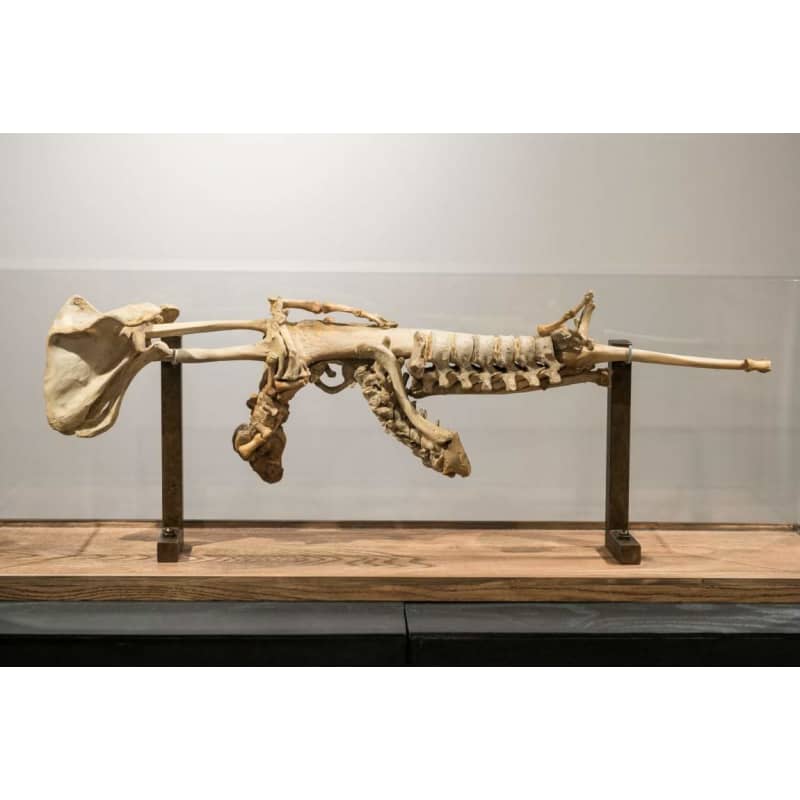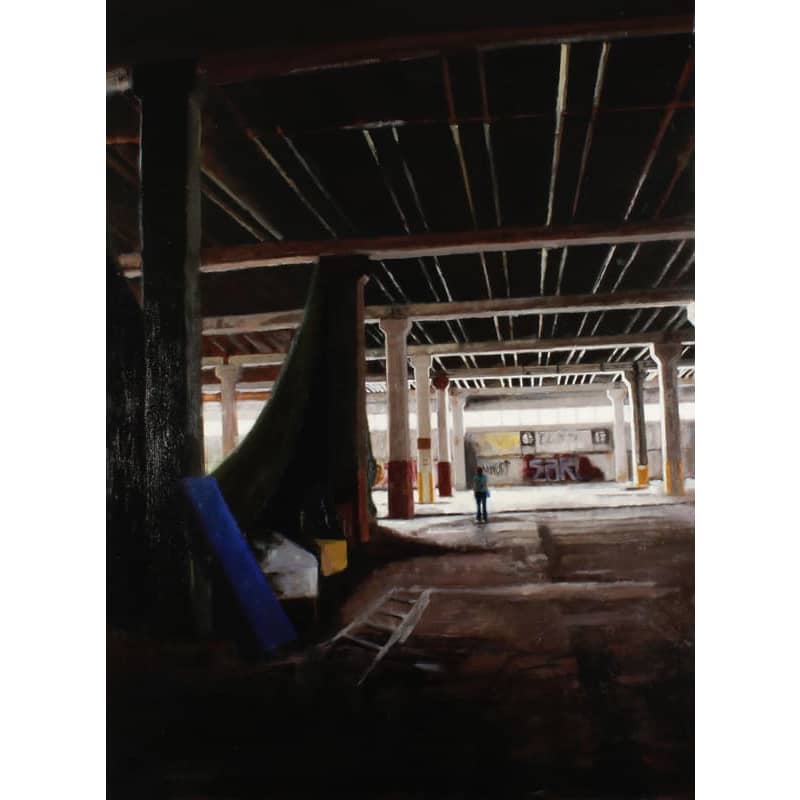Adriana Patrucco
Adriana Patrucco was born and raised in Perú. She is strongly influenced by the Peruvian indigenist painting from the first four decades of the 20th century, in particular, by the work of José Sabogal and Carlota Carvallo. Petrucco’s attraction to these artists is reflected in the innovative use of exaggerated features of her portraits and the use of particular colors reminiscent of those used in Andean folklore. Other crucial influences on her art are John Singer Sargent, Edward Hopper, Gustave Caillebotte, Tamara de Lempicka, and Paul Cézanne, from whom she learns the synthesis of light and the aesthetics of gestural elements in figurative painting. During her time at the School of Art in Lima, Perú, she also developed a strong career in children’s illustration. She paints at her home in Fayetteville, Arkansas.
As an artist, I am seduced by the role of light and shadows on what I paint. For me, they are the main characters of my painting and also its main expressive device. Therefore, I think the most relevant feature of a painting is not necessarily the formal resemblance to the actual subject, but the expression, the light, and even the breathing the painter attempts to convey.
My latest series is inspired by images of lost and found dogs seeking new homes, an uncommon yet familiar sight most average people are not accustomed to. My objective, as an artist, is to compliment these unfortunate circumstances of rejection and turn them into more desirable and hopeful experiences using soft brush strokes and a hint of color, emphasizing even the smallest wrinkle to describe its melancholy. The dogs have physically exhausted themselves, to the point where they are solely relying on eye-to-eye contact in order to successfully communicate in desperation.
Alice Andrews
Alice Andrews (8/25/1946-12/5/2021) was a native Arkansas artist who lived among nature, both at her family home in El Dorado, and at her 1800's farmhouse in Boxley Valley on the Buffalo National River. She discovered her love and affinity for visual arts as a student at Henderson College in Arkadelphia then worked as a graphic artist at advertising agencies, art studios and an architectural and engineering design firm. Andrews also attended graduate school at Maryland Institute College of Art (MICA) in Baltimore where she was a student of Grace Hartigan, a member of the second wave of abstract expressionist painters in New York City. Andrews’ art can be found in numerous private and corporate collections in Arkansas and throughout the country, and inquiries can be made to Art Ventures NW Arkansas.
Alice wrote, "My paintings come from the need to make a mark, like drawing in the dirt, or like scratches made on cave walls, a primal drive to create something out of emotions, to make the spirit visible. Cave drawings, rock art, marks made in the ground, old sidewalks, floors and walls that reflect the history of time, all inspire me. I work from my dreams, surroundings, and family life, or just from the pleasure of using color, line, and form. The response that you as the viewer make to any of these artworks expresses your connection to them. Creation is all around."
Amy Eichler
Amy Eichler is a Fayetteville native and full-time acrylic and oil painter who focuses on colorful figures, animals, and anything with eyes and a personality. Her background in dance performance, teaching, and choreography has influenced her work to emphasize expressive color, movement, and character and to appreciate the performance aspect of visual art. Most often incorporating an alla prima approach with a limited color palette of 3-5 paints, Amy pushes color in nature to their most saturated, richest hues and uses contrast and negative space to highlight the subject of her paintings. Amy’s love of teaching has brought her to instruct at multiple locations including Eureka Springs School of the Arts, Crystal Bridges Museum, and virtual and in-person workshops reaching students around the globe. You can find her artwork online at www.amyeichlerart.com and across the region in galleries, shops, and local exhibits. Amy holds a degree in Art from the University of Arkansas and is represented by Art Ventures Gallery in Fayetteville, AR.
Eicher feels that painting, much like dancing, is a physical self-expression to capture the mood, emotion, or personality of the setting or model. Both disciplines focus on texture in movement, allowing bold and graceful gestures to work together to create visually pleasing pictures. Eichler’s background in dance has influenced her painting to emphasize color, rhythm, technique, character, and the living form. She approaches her paintings like a dance routine, performing the creation of art from start to finish in one session. Eichler often revisits pieces to make adjustments, but credits the first explosion of enthusiasm for setting the tone of the painting. Over time, Eichler’s art has grown to be more about the subject of the work and less about the setting, and she often abandons the background to make more room for contrast and negative space. This transition has narrowed her focus to the portrait itself and the abstraction of the figure. She often paints with a limited color palette, but instead layers the colors directly on the canvas to create a variety of vibrant hues. The backgrounds remain flat, allowing the figure to expand off of the edge of the canvas to create a high-contrast, close-up view of the subject.
Andrea Carrillo
Andrea Carrillo was born in Nuevo León, Mexico in 2001 and is currently a junior at the Kansas City Art Institute. During the off-season she resides in Bentonville, Arkansas with her parents. Her works are recognized as rich and inspirational, while her linework has been noted by her instructors for its expressiveness.
Her raw talent underlies an incredibly promising future in the art world. Andrea enjoys experimenting with various mediums such as acrylic, oil, printmaking, and mixed media. She has won several awards in both 2-dimensional and 3-dimensional work from the Arkansas Young Artist Association while in High School. Carrillo is the youngest artist exhibited professionally by Art Ventures Gallery.
This body of work, Cabeza y Corazón, began as a series of 10 works made in 10 days, part of an assignment I was required to complete for class. Even though they were homework, I thoroughly enjoyed making them all. Given our peculiar global predicament, the people portrayed in my canvases are simply familiar faces, people around me that I was able to use as models and compare their resemblance with my paintings in real-time. There was a gradual, noticeable improvement in each painting I completed, slowly solidifying my style, and allowing me to be more confident with each of my artistic choices. I continue this personal art practice along with my studies.
Art Meripol
Art Meripol developed a deep interest in live concert photography while attending college in the early 70's. After college Art worked days as a photojournalist and nights pursuing his love of live music shooting at venues from small clubs to arenas. Art's photos reflect a fan's viewpoint, albeit one with better access, with the goal of creating an iconic image of each artist. Since the late 80's he has worked as a travel photographer, averaging 140 nights a year on the road. His work, from music to travel to politics, has been published in books, newspapers and magazines worldwide.
“I visited the market several weekends that fall of 1974...The whole shoot was for Andrew's (Kilgore) class. I do remember being a bit intimidated in approaching strangers to shoot. I think the ability to approach people you don't know with a camera is a learned skill, and this was a great early lesson for me... Looking back I think my instincts were pretty good in what I chose. They really do capture a place in time." (Fayetteville Flyer, 2015)
Art has donated signed copies of limited edition prints of the Fayetteville Farmers Market series to support Art Ventures NW Arkansas. Please buy yours today.
Behnaz Sohrabian
Born and educated in Tehran, Iran, Behnaz Sohrabian discovered her love of art, freedom and creative expression as a small child, developed a passion for painting and began her professional art career at the age of 10.
Behnaz earned a B.S. in Applied Chemistry from Azad University - Tehran, a B.A. in Painting from Alzahra University - Tehran, and a Master of Arts in Art Studies from Art University -Tehran. After completing her Master’s degree she immigrated to the United States in 2010 and became a naturalized U.S. citizen in 2017. Sohrabian’s work has been recognized and featured in art shows around the globe including most recently - Best of Show, 63rd Annual IAA Dallas Exhibition (June 2018), Honorable Mention, 88th Annual Exhibition, National Art League (2018), Love Show, JRB Gallery, USA (2018), Merit Award, PAA Member’s Show (2018), National Art League 87th Annual Juried, 2nd Place Award (May 2017), and Batesville, Arkansas BAAC Gallery (April 2017).
My work is about me, about being a woman and giving voice to the many challenges that women face in this era. I paint women as strong individuals free to express their feminine power and vision for a better world. I paint women as delicate and sensitive, but never weak. The people and natural world that I paint are manifestations of love, the highest expression we know in this life.
My aim is to paint simply. I apply easy brush strokes, emphasizing light and shadow as well as the dynamics between the subject and background. I choose varied subject matter to convey the concept of femininity with simplicity, natural beauty, and inspiration. Women, our beloved animals, flowers, and mother earth symbolize the essential power of creation in our world. They interact with an intentionally sensuous dance that expresses the process of fertility and reproduction, strength and compassion. My art explores the drama, texture and wonder of this creative process.
Beth Owen
Beth Owen grew up in El Dorado, AR, where art and humanities played a central role in her upbringing. Her mother and maternal grandfather, both artists, instilled a love for the creative process in her from a young age. Beth fondly remembers spending time with her grandfather, using finger paints to create works of art. Her exposure to classical music and ballet lessons also influenced her abstract painting style.
Beth pursued her passion for art by earning a Bachelor of Arts in Art History from the University of Arkansas in Fayetteville, specializing in the art and archaeology of Pre-Columbian Mesoamerica. She was particularly drawn to the vibrant colors and bright pigments seen in ancient codices of the Aztec, Mixtec, and Maya cultures.
Following her mother's passing in 2019, Beth embarked on a journey of self-healing through full-time painting. As an abstract expressionist, she employs acrylic, watercolor, and oil painting techniques, with a preference for oil due to its glossy finish. Her work is characterized by its highly textured quality, achieved by applying a thick primer of heavy gesso before creating an underpainting, resulting in a 2D fresco or pilaster effect.
In 1973, a significant event happened in my life. I was working with my teacher in our private reading group when a group of older students interrupted to announce the winners of the school-wide art contest. "The winner for the 3rd-grade art contest is...Beth Young," they declared. I vividly remember the excitement that coursed through me at that moment. Winning for the entire third grade with my prized work of yellow, white, and green flowers on top of blue poster board proved to be a defining moment in my life. It meant free art lessons for the remainder of the school year at the South Arkansas Art Center.
Those art lessons were transformative for me. I learned painting techniques such as layering, which allowed me to achieve certain desired effects and opened doors to better communicate, connect, and build relationships. As the death of my beloved grandmother the summer before had left me feeling incredibly shy, anxious, and uncertain, art became a powerful tool for self-expression.
As an artist today, my work is a reflection of my past and present. It provides me with a visual voice and invites the viewer to experience courage and vulnerability as I share my perception of places, people, and the human experience. In my contemporary works, I utilize layers to explore themes such as spirituality, memory, and movement. Some pieces feature words from literature, film, dance, or other sources that are personally meaningful as its base layer. In some paintings, the printed layers are clearly visible, and in others, they are obscured. Through this, I explore the meaningful selectivity we use in deciding which layers of our personal stories we will share with others and which we will withhold.
Color is a tool, a technique, and a language that I use to emphasize the overall mood of my art. Abstracting the subject matter, manipulating shapes, and incorporating texture that evokes an emotional response unify my paintings, however diverse they may be.
Bobby C. Martin
Bobby C. Martin is an artist, educator and facilitator who works out of his 7 Springs Studio near West Siloam Springs, Oklahoma. Martin is active in the contemporary Native American art world and his work has been featured in numerous group and solo exhibitions. As an independent curator, he launched the national touring exhibition, Return from Exile: Contemporary Southeastern Indian Art, in 2015-2018. Martin’s work is exhibited in numerous museum collections including the Philbrook Museum and Gilcrease Museum in Tulsa, Oklahoma, the Hood Museum of Art at Dartmouth College, the Museum of the Great Plains in Lincoln, Nebraska, and the Sam Noble Museum in Norman, Oklahoma. An enrolled citizen of the Muscogee (Creek) tribe, Martin currently holds a Professor of Visual Arts position at John Brown University in Siloam Springs, Arkansas, and is Director of the Windgate Gallery. He frequently leads printmaking workshops and artist retreats at his studio at various museums and art centers in the Midwest.
Old family photographs passed down from my fullblood Muscogee (Creek) grandmother, my mother, and my aunts and cousins provide a nearly endless supply of resources for my artwork. These images of close kinfolk and distant relatives have become icons for me, symbols of a Native American identity that is not seen as “traditional,” but is just as valid and vital to me – a tradition of Indian Christianity and mission schools that has been part of my family history for generations. The images provide a connection with my past, a way to remember and honor the generations that have come before – a way to commemorate our unique family heritage. Like the complicated layers of my heritage and identity, the use of layers of glaze, of encaustic wax, is an act that builds up layer by layer to create both a physical and metaphorical representation of the effect of time and memory.
Candace Dolls
Candace Dolls spent her childhood in Star City, Arkansas, Arlington, Texas and Helena-West Helena, Arkansas as the eldest of three children (two brothers and herself). Her father was the very first artist she ever admired. Although it wasn’t a life passion for him, she discovered early on that it would be for her and she began drawing around the age of 4. Her interest in art was followed soon after by her brothers’. Throughout their lives, art was ever-present as a favorite pastime. During her adolescent years, art became an outlet and a source of healing. Her art teacher and mentor, Brent Harris, molded her talent and urged her to pursue art as a major in college. After graduating from Central High School in Helena-West Helena, Arkansas, she pursued a degree in fashion design at the Art Institute of Dallas. Back in Helena, Candace has used her incredible talent and heart to work as a seamstress at a local children’s boutique (Haute Pare) and as a mentor to students at Central High School and Miller Junior High School. She is now pursuing a degree in education while conquering her first year of teaching art at Forrest City Junior High School in Forrest City, Arkansas. In the midst of overcoming difficulty and welcoming victories, she has her daughter Brennan and her son Canaan to keep her motivated.
As an artist I try to convey my history as well as tell a story that leaves an essential question lingering inside the viewer’s mind. I don’t like to describe my artwork as aimless or random. But I will say, I seldom have a vision of how the painting will turn out before it is done. I start with prayer and a concept or a very short description of what a client may want. I find that too many words cramp my creative flow. While creating the pieces for the Scipio Jones biography, the process was mostly the same. My favorite forms of art are illustration and painting using a subtle mix of styles reminiscent of realism, expressionism and African art. My favorite medium is graphite, charcoal, watercolor and acrylic. I love using bold, vivid colors to make a lasting impression.
Carol Hart
Carol Hart was born in Shreveport, Louisiana and earned her BA in Fine Arts with an emphasis in painting at Stephen F. Austin State University in Texas. She currently lives in Fayetteville, AR with her husband Bill and their two cats. After moving to Arkansas Carol worked with children with disabilities for a number of years and later founded Life Styles, a non-profit providing critically needed services for adults with disabilities. Understanding the importance and power of art, Carol established the Blair Art Center for individuals to find their voice and express themselves through a variety of mediums. Today, these accomplished Life Styles artists enthusiastically show their work throughout the region. Carol is an acrylic and mixed media artist. Her work includes landscapes, figures and abstracts. She likes to work in series as it gives her the opportunity to fully explore her subjects like her Sew What Series, her vintage women in sports paintings, or her current series focusing on memories, reflections and feelings of home.
I am an acrylic and mixed media artist. I love the painting process from that first kernel of an idea to the finished piece. I use bold bright colors, loose brush strokes, and vivid patterns to bring attention to the interplay of shapes, color, and texture. I frequently add collage elements, mark making, drawing on the canvas, and sewing on the paintings as exemplified in my Sew What series. I paint figures, landscapes and abstracts. While my subject matter varies, my methods are consistent emphasizing an abstract approach striving to capture a feeling or emotion, or create a story. I enjoy exploring the push and pull of paint and collage in my abstract works. I will create layers upon layers of paint and collage until the balance, movement and complexity of the painting is achieved. I have always been involved in the pursuit of creative expression. My love affair with painting began in high school. I view the world through an artist’s eyes, seeing possibilities in the ordinary and the extraordinary. The process of painting is personal for me. It is not only my opportunity to create, but to problem solve, experiment, and share a part of myself with the viewer.
Celestine Eichler
Celestine Eichler is a local artist who graduated from the University of Arkansas with a BA Degree in Marketing with a Minor in Advertising and Public Relations. She is from a large family of artists. Her dad worked in woodworking, and five of her eleven siblings are practicing artists. In addition, her daughter Amy is currently a painter at Art Ventures. Celestine was co-owner of The Gallery on Dickson during the 1990’s, alongside fellow local artists Wilnita Holland, Ellen Lewis, and Jane Weir (Garrison) Davidian. Her work is held in private collections throughout the country has been exhibited in Dallas, Little Rock and Fayetteville. She has traveled to Honduras many times since 1997, teaching drawing and painting to young people and has maintained lifelong friendships with many of her students and their families. Celestine’s usual medium is oil, although she sometimes will begin large paintings in acrylic and finish with oils. She has studied with Daniel Gerhartz, Scott Burdick, Kevin Beilfuss, Juan Ramirez, and Guido Frick among others. Celestine has also hosted numerous Oil Painting workshops. Celestine is a member of Portrait Society of America, Artists of Northwest Arkansas, and Plein Aire Painters of the Ozarks. Celestine currently resides in Fayetteville with her husband, John.
I feel compelled to paint. I grew up around it, with art always being part of my life. I paint from my heart, subjects that I love, preferably from life. I enjoy the process and the journey. I paint in oils, sometimes with an acrylic start, with as much impressionistic color and expression as possible. I am interested in learning from past and contemporary painters and will challenge myself to try new ideas. I have recently begun a series of large figure paintings that allow me expressive creativity, while challenging the viewer to apply their own interpretations.
Cheri Bohn
Cheri Bohn became interested in art during first grade when she heard about Van Gogh's ear. In high school she was moved into advanced art classes, and her passion for art blossomed. After taking a sculpture class at the University of North Texas, she began to focus more on the 3D form. She graduated with a BFA in 2003. Now, she has been working with stained glass for over 20 years. After she moved with her family to the Ozarks in Northwest Arkansas, she was inspired by roots of trees to create a new type of art. The first one was created around 2002. Cheri Bohn has displayed her work in Arkansas, California, Texas, Nevada, New York, Chicago, and Las Vegas. She was one of five people profiled in the 2013 Fayetteville Insiders Guide, and won best in sculpture at the 27th Annual ANA awards. She has a permanent exhibit at the Eurekan Art Gallery in Eureka Springs, and also exhibits at Terra Studios in Durham, CALS in Little Rock, and Art Ventures in Fayetteville, AR.
My interest in art started in 1st grade with Van Gogh’s ear. I stood out in High School as a good artist. In college I fell in love with the 3D form. I learned stained glass from a fellow classmate in the early 90’s. Knowing it was a dying art form, I was attracted to it. After my family and I moved to NW Arkansas the roots inspired my current body of work. Balancing with nature is my message.
Cheryl Buell
Cheryl Buell studied art at UCA and has participated in numerous workshops, including 2 weeks at La Meridiana International Center for the Ceramic Arts in Tuscany, Italy and several workshops at the Santa Fe Clay Center in Santa Fe, New Mexico. She has lived in Arkansas her whole life and currently resides in the woods of Winslow. Her current focus in her work is finding a way to successfully depict the subconscious and the events occurring around her. She has been working in clay for 40 years.
My work is a direct reflection of the people, places, events, and nature around me. It is a reminder that, even though I am participating in a tradition that has been performed for thousands of years, time is fleeting. It encourages me to take a moment to extract the essence of my surroundings and give them new color, shape, and form. Ideas dwell inside me, pestering the creative aspects of my mind until they are free to speak through my art. I’ve learned that retaining an idea only results in a blocked mind and creates a sense of immobility; so, for me, making art is a form of release and freedom. I make art by allowing inspiration to constantly come to me by keeping my eyes and mind open and always, always asking questions. I have been attempting to depict the subconscious through clay and am fascinated by the challenge of this endeavor.
Crystal Johnson
Crystal Johnson is a rising artist from Little Rock, Arkansas. Her love for the arts began when she attended Parkview Arts Magnet High School. Faced with numerous serious health issues since elementary school, she needed something constructive to occupy her time. Her illnesses often kept her out of school for extended periods of time. Health issues have prevented her from working or attending college. She began by singing and teaching herself how to play the piano by ear. She has composed over 200 songs and has ventured out to begin playing additional instruments. One day in August 2018, she woke up inspired to paint. Those who saw Crystal’s artwork encouraged her to use art as therapy to help her cope with being ill nearly every day, and since then, she has not stopped painting since.
Crystal has branched out and begun using mixed media in most of my art pieces. She is most known for her unique use of 3D art, using natural hair, jewelry, and fabric in most of her pieces. She also loves to use vibrant colors to draw in viewers’ eyes. Her choice of medium is acrylic because she finds it to go on more smoothly. Her inspiration comes from God-given visions that she often receives in her dreams. She crafts each piece to be unique, having its own personality. Crystal loves challenging her creativity to make her next piece more unique than her last.
David Gomez
David is a Mexican American artist working from his studio in Rogers, Arkansas. He explores the place of humanity in the cosmos and the delineation of meaning and context through lines and shapes. The latter is a recurring theme of his work as he contends with the results of the aggregate of lines, type fonts, and biomechanics into language or symbols. His fascination with symbols and meaning derives from a longing to understand and be understood. As the child of Evangelical ministers in mostly Catholic Mexico, his customs and cultural association made him feel lost and an outsider in his own homeland. Exacerbating these feelings of peerlessness, his world view developed through a lens of undiagnosed ADHD, dyslexia, and stammering. At the age of fourteen, his family relocated to the US and again language became a new invisible border and the lack of historical context within the new culture rekindled the old feelings. His work presents these obstacles with insidious cypher-like markings ubiquitous of his work. Strands and series of symbols and code merge together as if orchestrated musically in a way that only those who have seen or worked with those symbols and context can fully recognize. However, his work is not exclusionary. Instead, he collects symbols and imagery that are prevalent in popular culture and slowly draws out their insidious nature.
David G0mez has explored acrylics, spray paint, graffiti markers, pastels, and different styles of painting. As his creative inspiration emerged overnight, his career has thrived almost at a similar pace. His work has been shown in New York, Milan, and Paris. He collaborates with art institutions in Northwest Arkansas and recently was Program Manager for visual arts and Arts One Presents. Currently, David works independently painting and curating shows as well as participating in group exhibitions. Immediate plans for his career are his first international show in Madrid, returning to Paris, and several juried art shows in the US.
Deb Manley
Deb Manley was born in Little Rock and raised in California. She moved to Fayetteville in 1984 and considers it home. She primarily uses graphite and ink in her artwork but also enjoys charcoal, watercolor, pastels, acrylics, freehand embroidered portraits, and digital art. Deb studied art courses at LR Central High where she first connected with a teacher and was introduced to the formal elements of the visual arts. She took a drawing course at UALR in the early ‘70s, and then took a full load of studio art courses at the UA. She then took a painting course at Hot Springs Community College after marrying and having a son. Deb divorced and moved to Fayetteville to raise her son alone. She returned to the UA in 1990 and graduated Phi Beta Kappa in 1993- a first generation college graduate - with a degree in Creative Writing. While she continued to sketch throughout the years, she only recently returned to more traditional materials in 2017 focusing primarily on portraiture and figure study after learning how to do digital painting in 2013.
Portraiture and figure drawing wake me up, shake me into action. I would rather draw or paint someone with unusual physical qualities, interesting body language, or someone who can contort their body rather than the normally accepted concept of beauty. I’m attracted to an averted gaze, a defiant stance, slumped shoulders, a tilt of the head - faces and body language that reveal a truth, sexuality, or emotions either dark or light. I am drawn to muses who evoke a sense of connection to my own, and others’, experiences, feelings. Most importantly I look for heart. I try to convey something more than what is reflected in my eye. I want a resemblance to my subject matter, but also something deeper, something that evokes a relatable feeling in me and the viewer.
Dolores Justus
Justus earned a B.F.A. from the University of Arkansas at Little Rock in 1988. Her work has been exhibited in solo and group shows throughout the nation and abroad for more than 30 years. A few highlights include: Distillation: Robyn Horn, Dolores Justus, & Sammy Peters, curated by Kellie Lehr, 211 South Gallery, Bentonville, AR. (2021-2022); Resilient Together: The Artist’s Journey Through Liminal Space, Fenix Arts, Fayetteville, AR (2021); Natural Ground: Dolores Justus and Gene Sparling at the LRoss Gallery in Memphis, TN (2021); Natural Light (solo exhibit) at the Degas Gallery in New Orleans, LA (2019); Natural Selection (solo exhibit) at the Boger Gallery, College of the Ozarks, in Point Lookout, MO (2019); Where Light and Landscape Meet / Where the Petals All Unfold - Alan Duckworth & Dolores Justus at the L. Ross Gallery in Memphis, TN (2019); Sight Lines (solo exhibit) at the Degas Gallery in New Orleans, LA (2017); Finding Center (solo exhibit) at the Annesdale Park Gallery in Memphis, TN (2015); Migration Patterns (solo exhibit) at the Roger D. Malkin Gallery - E. E. Bass Cultural Arts Center in Greenville, MS (2015); Coming Up for Air (solo exhibit) at the Catherine Kelleghan’s Gallery in Atlanta (2009); Horizon Lines (solo exhibit) at the University of Arkansas Mullins Library (2005); Interwoven, a joint exhibition with sculptor Robyn Horn, at Greg Thompson Fine Art (2011-12); Best of the South at Greg Thompson Fine Art (2015, 2016, 2017, 2018); the 43, 44, & 55 Delta Exhibitions at the Arkansas Museum of Fine Art (2000, 2001, 2013); Perspectives on Painting at Ouachita Baptist University (2009); and many others. Justus’ work was also featured on the cover of Elegant Homes Magazine (Spring/Summer 2021, January 2019, Fall/Winter 2017) and on the HBO series True Detective (2019).
Collections include: the Arkansas Museum of Fine Art, Little Rock, AR; the University of Arkansas, Health and Sciences Center, Fort Smith, AR; the Arts and Science Center for Southeast Arkansas, Pine Bluff, AR; Iberia Bank, Little Rock, AR; the Alluvian Hotel, Greenwood, MS; Delta Trust Bank, Little Rock, AR; CASA Women’s Shelter, Pine Bluff, AR; Donald W. Reynolds Institute on Aging at the University of Arkansas Medical Sciences, Little Rock, AR; UAMS Hospital, Little Rock, AR; CARTI Foundation, Little Rock, AR; Arkansas Children’s Hospital, Little Rock, AR; Arkansas College of Health Education, Fort Smith, AR; the Country Club of Little Rock, AR; ArcBest, Corporate Headquarters, Fort Smith, AR; Sterling Bank, Fayetteville, AR; and many additional private and corporate collections.
Justus is currently represented by L Ross (Sylvan) Gallery in Memphis, Tennessee; Art Ventures in Fayetteville, Arkansas; Greg Thompson Fine Art in North Little Rock, Arkansas; and at Justus Fine Art Gallery in Hot Springs, Arkansas. In addition to painting, Justus is also an accomplished art director operating the Justus Design & Marketing firm. Her strong visual design and literary skills have been employed in a variety of advertising and commercial mediums.
Inspired by the natural world, Dolores Justus’ paintings reflect a sensitive and intuitive view that distills patterns of light and form into compositions that engage and inspire. Blurring the line between abstraction and representation, her painterly style also contributes to the interactive quality of her art. In her exploration of the confluence of optics and painterly abstraction, her work belongs to the “new landscape” movement of contemporary American art.
“I’ve always had a strong identification with nature and am continually in awe of the depth of inspiration that it offers. Despite all its variety, there are essential elements in it and in us all, that we respond to. It is those universal, underlying truths that I seek to communicate in my own work.” - Dolores Justus
Don Byram
Don was raised in Arkansas and after spending most of his adult and professional years away, moved back in state in 2016. As he says, “probably for the duration”.
His art is centered around photography. It started in college with an old film Pentax and a passion for composition. His midlife was spent earning a living and helping raise a family. In 2005, he picked up his first digital camera and got back to the art side. As time progressed, he has added antique and vintage frames to a majority of his work. In quite a bit of his new work, he has added quirky, found, antique, physical pieces to add dimension and layered meaning to the core image. Frequently, the photography is covered either partially or completely by resin instead of the traditional glass.
He owned Don Byram Art, a Gallery and Frame Shop in Commerce, Georgia. He is a Past President of the Athens Photography Guild in Athens, Ga., as well as the Past President of the Conway League of Artists.
He has had solo shows in both Georgia, at The State Botanical Gardens of Georgia, and Arkansas, at galleries in Little Rock and Rogers. His art has been purchased by the Central Arkansas Library System for their permanent collection and pieces of his Galaxy Girl series are in many homes and businesses in the region. He is represented by several galleries in Central Arkansas, NWA, and St. Louis.
Why I want to be in this show. My cousin Jim died at the age of 50 from suicide.
As children, we went to school together, we spent most family holidays together, he was a year behind me in High School. After High School, he came out, to the surprise of his religiously conservative Arkansas family. To their credit, they did their best to adjust their world views, but some were more successful in doing so than others.
As adults we went our separate ways and lost all but occasional contact. He had a successful career and a full life until he ended it. Why did he commit suicide? No one knows. His partner still supports and works with Suicide Awareness programs in Dallas, after 10 years. His family still doesn't openly talk about it. Only Jim knew why and he took it to his grave. These portraits are of people across the spectrum of sexuality. All of them have taught me a little about what it means to be human.
Maybe, that's part of the answer I keep looking for.
Donavon Brutus
Donavon was born in Fort Smith, Arkansas. The cartoons of the 80’s and 90’s inspired him to start drawing at an early age. He was set on becoming an animator when he grew up. Throughout his time at Fayetteville High School, Donavon focused his art on sculpture and abstracts. After graduating he moved to Tampa to start a college education in animation. During this time, in addition to animation, he discovered the joy of digital art and graphic design. His career as a motion graphics animator took him to San Francisco, where he currently resides. Despite a passion for motion design, he still spends much of his spare time doing digital illustration stills.
I get peace from observing natural and unnatural lines in the world. I like everything from the soft curve of a hip to the sharp edge of a building. The precise straight lines cut your view, simplifying a scene into smaller shapes. Those gently sweeping natural curves that extend then return to where they started or the line from one shape continues into another. Two curves that glide close enough to kiss then shoot off in opposite directions.
These observations guide what I make. Love to simplify what I see in animals, the human form, and my experiences. Thematically I explore mindfulness, diversity, music, black excellence, and popular culture. Generally feel that POC and LGBT+ communities are still significantly under-represented in our culture, and the representations are often flat. As an ally I try to shift this. My work is a meditation of organizing shapes into something that feels aesthetic.
The Freedom series represents freedom in various forms. For me as a creative, it was a freedom in two other forms. Freedom from my usual color palette of blues, greens, and yellows. Also, it represents freedom to use reference and be inspired outside of my own experience.
Doug Randall
Doug Randall is a NW Arkansas artist. He was born in upstate New York in 1946, and as a child was introduced to art by watching the plein air artists painting the fall foliage in the Lake District. After being encouraged by his wife to take up painting, they decided to relocate to Charlottesville, VA so that Doug could attend the Holden School of Art in 1974. There he developed oil painting techniques that would come to influence his work.
Though he took a hiatus for almost twenty years to focus on building a house and raising two children, he returned to art again. In 1993 he entered a painting in the Sager Creek Arts Center Competitive Show in Siloam Springs, Arkansas, and won his first award. This further fueled his passion for painting. Over the years he has shown artwork in several galleries in the Midwest, and opened the Rocky Creek Art Gallery in Fayetteville, AR. In 2002 he had the once in a lifetime chance to show his art at the Off Broadway Gallery in London, England.
I call my art “Mindscapes”. I see what I want to see in my mind and paint it. It is a composite of places and experiences, which create illusion and emotion. My work could be abstract, impressionistic, or traditional. I love the play of colors and how they compliment each other. Many of my patrons have said, “It reminds me of someplace I’ve been before” and for me that is what my painting is all about.
Drew Gentle
Drew Gentle was born in 1947 and raised in Los Angeles. After high school, Drew worked as an Artist Assistant to his father, Robert Gentle, at Hanna-Barbera Studios. In 1969, Drew earned a BFA from the California Institute of the Arts. Over the next forty years, he worked as a conceptual designer and storyboard art director for multiple studios, including Hanna-Barbera, Disney, and Warner Brothers. While working in animation, Drew began to express his more personal work of abstracted figurative personas. He created hundreds of drawings that formed the basis for his long and large print series. He retired from animation in 2007 and began his second career creating fine art. His work has been internationally exhibited and referenced in numerous books. Drew now lives in Eureka Springs, where he continues to pursue his artistic vision.
My work veers toward representational works of real and imagined people. I am delving into the human psyche, creating abstracted figurative personas that portray the complexity of the human condition. The works are meant to shed light on the layers of human identity and reveal the hidden stories that exist behind our external veneers. Each work is an invitation for the viewer to reflect on inner worlds and their personal experiences of living within societal constraints. The works are meant to provoke a deeper exploration of the complexities inherent in personal identity.
Eloa Jane
The all-attractive prospects of comfort, money and convenience filled Eloa Jane’s little grey mailbox as she transitioned into a new life in America. Such pursuits, she began to realize, are at odds with the pursuit of happiness when they come at the expense of meaningfulness, resourcefulness and fulfillment. These were values Eloa Jane could not do without. In her search for a lifestyle where she can find fulfillment in creating meanings rather than owning disposables, she had only to look at her most immediate resource, namely, the overwhelming amount of paper that travels this country on a daily basis. “Be the change you want to see in the world,” as Gandhi famously said. And so she did - rather than preaching sustainability, she set out to be sustainable, and this quest began to shine through to her art. She began to incorporate unwanted paper from junk mail into her compositions, making the useless useful, the worthless desirable, transforming trash into beauty in a way that resonated with her personal journey. By reusing office paper, magazines, newspapers, phone books, and even coffee filters she has learned to take advantage of the inherent properties of junk paper - with its varied textures, patterns, text, and colors - as a means of self-expression. Some of her most meaningful work consists of paper mosaics and sculptures themed after personal events such as dreams, impressions, emotions, times of light, and times of darkness. Up-cycling is now not just her art but also her way of life.
I transform recycled paper waste into art. In this process I maintain the integrity of paper's textures and printings. I roll pages of recycled paper individually into small tubes and assemble them to create decorative vases, sculptures and wall art. I see my own journey in the disconnected words, fading colors and rough textures of the pieces I make. They reflect my life's transformation after I have seen it torn apart like a piece of paper and yet I hold to my values and redefine myself.
Eric Andre
Eric was born and raised in Ghana -West Africa. He completed his bachelor’s degree at the Kwame Nkrumah University of Science and Technology in Ceramics, 2010. He became a Ceramics Teaching Assistant and a Studio Technician in the Ceramics Department from 2010 to 2018. Currently, Eric has completed his MFA in Ceramics, the University of Arkansas, Fayetteville-Arkansas, USA.
Eric is an interdisciplinary artist whose research encapsulates abstract and perceptual-driven artworks to explore immigrants' experiences of displacement, vulnerability, and negotiation of place to challenge the ubiquitous and complex sociocultural, sociopolitical, and socioeconomic systems of control. The works deliberate on the politics of space, its complications, and how people negotiate these spaces.
Frank Goff
Frank Goff was born into a military family with roots in Arkansas. His family relocated to and from military bases in Europe and various parts of the United States.While his family was stationed in Europe, Goff was exposed to a rich variety of cultural experiences that influenced his desire to become an artist at an early age.
Goff attended The Memphis College of Art and received a B.A. in Art with teaching credentials at Arkansas Tech University and a M.S.E. from The University of Central Arkansas. He and his wife Patricia taught in public and private schools in the U.S., Costa Rica and The People’s Republic of China. Throughout his teaching career, Goff consistently worked in the studio, building a body of work and exhibiting whenever possible. Upon their retirement from teaching, he and his wife relocated to Hot Springs Village, Arkansas.Goff now works as a full time professional artist.
As a child, drawing was my source of entertainment and escape from boredom. In high school, I discovered the joy of carefully observing and drawing from life. Later on, in art school, I was encouraged to experiment with both traditional and non-traditional materials and methods, which was a liberating experience.
My artwork features both two-dimensional and three-dimensional pieces that are inspired by the
wonders of the natural world. Through my drawings and scratchboard engravings, I seek to capture the intricate details and stunning beauty of nature in all its forms.
My three-dimensional work focuses on creating sculptures that suggest organic forms found in nature, such as plants and animals. I use direct wood carving techniques to craft each sculpture with precision and care. Once complete, I arrange the sculptures into small-scale tableaus, which serve as inspiration for my two-dimensional works. By inviting viewers to enter the tableau and interpret the setting in their own way, I aim to create an interactive experience that encourages a deeper appreciation for the natural world.
My larger-scale sculptures are crafted using a variety of materials, such as stone, local minerals, and found objects. Through assemblage techniques, I create a unique blend of organic and synthetic elements that challenge the viewer's perception of the constructed and the natural.
Heather Chilson
Born and raised in northeastern South Dakota, Heather Chilson moved to Arkansas in 2005. Since childhood, photography had always played an important part in her life as a hobby, but it grew into a passion. Influenced by photographers such as Imogen Cunningham, Garry Winogrand, Todd Hido, Jane Rule Burdine and Geoff Winningham because their work evokes emotions and feelings about time and place within her, Heather finds inspiration to use her stark, matter-of-fact approach in compositions that she hopes will also speak to the viewer. She works in both film, using cameras that date back to the 1930’s, as well as digital.
When I photograph I spend time in front of a subject and think about how I want it ultimately portrayed: do I want to show the sense of place? The beauty of its age? Or just capture the typically mundane?
The more I can think about this narrative, the more I can edit through my viewfinder before I fire the shutter. Ultimately when I see the final photo, I want to be transported back to that place and I want the viewer to see it through my eyes, realistically.
I don't want to create an unrealistic illusion; I want you to feel that you were there with me when I took the shot.
Jason Davis
Jason Davis is a self-taught Sculptor from Van Buren, Arkansas. Jason excels at additive and subtractive sculpture, which ranges from wood carving and clay to bronze making. However, his true passion is stone work. Davis uses Oklahoma stone to create monumental sculptures reminiscent of ones from ancient societies including Mayan, Greek and African.
I like to portray fluidity and movement on hard surfaces which are deemed cold and hard in nature. My inspirations range from the depths of my twisted imagination to personal matters I have always kept close to my heart. I hope to inspire those who seek meaning in art to examine it from an outer perspective and join the rest of us.
Jay McDonald
Jay McDonald a lifelong resident of Fayetteville Arkansas. He practiced as a physician specialist in ophthalmology for 35 years. He is recognized as a researcher and published scientific expert on the process of how the human eye and brain receives and creates vision. He has traveled every continent photographing a wide range of subject matter. He has studied with Master’s of Photography including Jay Maisel, Duane Michals, Matt Suess and Tim Ernst. His next planned photographic excursion is this fall to the Four Corners area in the Southwest. He currently resides in Fayetteville with his wife and 3 dogs.
Form, value, and contrast continue to be what draws me to photographic subject matter. My first memories of being drawn to photography was a box 4x6 negatives I found in the basement of our house at the age of six or seven. There was something magic about those large negatives and their bold contrasting areas that captured my curiosity. Later, I was struck by the work of Man Ray. It is perhaps ironic that my first entry and award in a juried event was in fact an abstract photogram. I rapidly abandoned film and the dark room and embraced the digital camera and digital processing software. Developing a facility with Adobe Photoshop was a game changer in my being able to complete the photographic image. I enjoy using metallic, acrylic, as well as paper media as my final substrate to achieve the final visual outcome.
Jeff Edwards
Jeff Edwards is a Cherokee graphic artist who has worked for the Cherokee Nation as a language technologist for over a decade to help advance the preservation and use of the Cherokee syllabary broadly. He received his BA in Design and Visual Communications at Northeastern State University and studied at Haskell Indian Nations University in Lawrence Kansas. Edwards creates Cherokee themed artwork with syllabary graphics as design and cultural elements.
The Cherokee Clan Mask Series
The Seven Clans is an ancient structural organization of Cherokee society. “I have greatly appreciated everyone’s comments and approval. The Cherokee Clans have been around since the beginning of time so doing something this sacred was no easy task for me. It literally took me 3 years from the time it entered my brain until I made the first mask. And even while making that mask, I doubted myself on representing that clan well and of course doing the best job I could possibly do. A lot of thought, care and brain picking of Cherokees with clans have gone into this project. My imagery was always approved by clan members before I even considered it complete. If they wanted something changed, it was instantly changed, no questions asked. I knew tons about the clans, but I read more. Then some more. The last thing I want to do is take something of this magnitude and not do it justice. Typically, I jump in headfirst and never even look to see what’s at the bottom of the cliff beforehand. But there are always exceptions and this one is right there at the very top.”
Jeffry Cantu
Jeffry Cantu is a United States Navy Veteran. He was stationed in Japan and traveled throughout Asia and the Pacific from 2000-2004. Upon his return to the States, he became a member of the USN Reserve in Little Rock, Arkansas. Cantu’s art is deeply influenced by his Mexican culture and his travels in Asia. He met his husband in 2012, having the effect of heightening his ambitions to become a professional artist. He studied at the University of Arkansas Fort Smith Wingate Art & Design Center and volunteered as a scene artist for the UAFS Theater. Jeffry's artwork bloomed into large-scale, three-dimensional, and mixed-media abstract works focused on malleable lines that create form, and the use of light to enhance the illusion of enclosed space. Since then, Cantu has participated in exhibitions in Fort Smith and several Northwest Arkansas locations. He has garnered awards from Fort Smith Regional Art Museum Invitational exhibitions, and in 2020 Crystal Bridges Museum of American Art engaged him to bring art to communities in collaboration with the Fayetteville Housing Authority. Cantu has done several live installations throughout Northwest Arkansas in Springdale, Bentonville, and at the Center Square and The Ramble Arts District in Fayetteville. Cantu’s artworks are collectible and accessible to a range of buyers. His art is in the collections of many local individuals and regional businesses, including Bank Street House in Bentonville.
I use repetition, movement, and form, to create unity with select media, organic shapes, and abstraction. My woven relief works are made with corn husk at its basis with other media to transform it into a new, different object. From a technical standpoint, the reliefs are created by hand-manipulating cornhusk to stretch its expressive capabilities combined with other non-traditional sculptural materials such as bamboo, twine, rope, and sometimes clay. These works (as are my paintings) represent my contemporary, cultural search for self, using materials that are mainstays of my ancestry.
Jocelyn Knight
Born in Oklahoma, raised in Saudi Arabia, Jocelyn Knight has lived in multiple places in her life. She received her MFA in 2004 but credits both her artist mother and her travels overseas more so for her skills as an artist. Jocelyn has taught art for over a decade at Arkansas Tech University, the University of Arkansas at Fort Smith and currently teaches for Crowder. She teaches art history and notes that she has seen first hand nearly every artwork used as teaching material in those courses. The artist also teaches studio courses. Jocelyn currently lives and works in a berm house in the Ozarks.
Juliana Duque
Juliana Duque is a painter and graphic designer originally from Bogotà, Colombia. In 2008, she established herself in the visual arts community by working with several studios and art galleries in Miami, showcasing her work throughout South Florida. Duque is the recipient of two BCC Art Gallery awards, and the Kyra Belàn Endowed Scholarship for artists.
Using portraits and a diverse range of painterly methods, my work studies the aesthetics and materiality of the human body, perception and transience. The characteristics of my paintings lie in creating static portraits and deconstructing them by adding scribbles or numbers and subtracting sections through resolute brushstrokes. Subjects are imbued with a contrast between reality and fiction that merges on the abstract. In my recent paintings I use overlapping numbers ranging from 1 to 60, adamant strokes and Tairona symbology as a means of destruction, preservation and reconstruction through time.
Karolyn Farrell
Karolyn has enjoyed painting, winning awards and selling her art since an early age. Her first formal art teacher was Frederick Kiefendorf, prof of art at MO State University, who urged her to go to Art School after seeing her work in his classes. However, family members encouraged her to get a more traditional education but to study art as an avocation. Therefore, she stayed in MO and completed an undergraduate degree in Education with emphasis in art and science (cum laude graduate). She continued to paint part time during her career as a teacher and administrator in Maryland, in the greater Kansas City area, and in Arkansas. She holds a Masters and an Educational Specialist degree from the U of AR, with work towards a doctorate in Fabric design from MO U, Columbia. She has studied with internationally known artists throughout parts of Europe and the USA. Traveling, visiting and volunteering in great art museums has enriched her life. She appreciates the artists she has been able to hire when directing the Fayetteville Schools adult and community ed program. She is a charter member of Artists of NWAR, (signature member), signature member of National Oil and Acrylic Painting Society and board member, Portrait Society of America, Plein Air Painters of the Ozarks, the Pastel Society and others. She has enjoyed sharing her art with nonprofits of whom she has worked with. She has won numerous awards and has collectors of her art across the USA. She appreciates Mr. Kiefendorf for his gifted instruction and encouragement to follow her passion. She continues to appreciate other instructors, such as A. Handell, D. Lefel, S. McGraw, etc. She enjoys painting the beautiful areas with other artists.
I hope my brush creates a bit of visual earth that invites you to connect to the land. My art is more about appreciating what we have, clean water and open spaces. I hope it helps inspire us to be good stewards of the environment.
Kathleen Siegfried
Kathleen Siegfried is a retired teacher and painter, who thinks of herself as an experimental artist, specifically drawn to the abstract. She often begins with color rather than subject matter, using it as a guide for composition inspired by childhood memories, imagination, and suggestion. Whether she paints with watercolor or acrylic on paper, canvas, or wood panels, her most successful paintings are created from a combination of memory, imagination, and suggestion. “I have been inspired by memories of life on the water – the creek on the farm where I grew up in Ohio, the ocean landscape of my years in New Jersey, and now the rivers and lakes in beautiful Northwest Arkansas.” Siegfried’s recent mixed media paintings explore land and seascapes inspired by technology. During her years as a language arts/English educator and supervisor, Siegfried enjoyed blending the expressive power of literature and art. In 1992 she could no longer resist the impulse to paint and since then she has studied with many inspiring and gifted water media artists. When she retired in 2012 and moved to Northwest Arkansas from New Jersey, she discovered a vibrant and inspiring art community there.
I like to think of myself as an intuitive painter. So, I often begin with color rather than subject matter and let the colors show me where the painting will go, whether on paper, canvas, or board. My most successful paintings come from a combination of memory, imagination, and suggestion. Especially drawn to the challenges of abstraction, I am intrigued by the possibilities of mixed media and the integration of a range of materials into my acrylic paintings. During over forty years as a language arts/English educator and supervisor In Ohio and New Jersey, I enjoyed blending the expressive power of literature and art. Painting allows me to continue to do that in new ways and to be inspired by the dynamic art community in Northwest Arkansas.
Lourdes Valverde
María de Lourdes Valverde Galindo was born and raised in México. She moved to Bentonville, AR. in 2015. She got a Bachelor’s degree in Science of Industrial Engineering at Durango Technologic Institute in Mexico. She is a self-taught artist, a fellow of Artists INC. She is represented artist by Art Ventures Gallery in Fayetteville, AR. and director of “Raíces de México”, an organization that promotes Mexican traditions.
She has participated in many community art exhibitions in Mexico (Durango, Aguascalientes, Nuevo Leon, México City) and now in Arkansas (Bentonville, Rogers, Springdale, Fayetteville, Little Rock, Helena, Conway, Pine Bluff, Russellville, and Hot Springs). She is the principal organizer of the Day of the Dead Festival in Bentonville, including an art juried exhibition from 2017 to 2021 at The Museum of Native American History amongst other venues. In December 2021 she was invited by the Mexican Consulate in Little Rock to represent Arkansas, Oklahoma, and the Missouri States in a meeting at México City where she joined with cultural authorities to discuss collaboration with both governments about cultural projects between the two countries.
Her work explores her experiences in life, looking always to provoke feelings in the spectator. Nature and family are present in most of her works. She uses oil and acrylic technique, but she likes exploring new methods to express herself.
I paint what amazes me. Painting for me is like speaking without words. When I was a kid I loved to draw all the time, now I am painting what is in front of me. I love to interact with the people for they are a source of inspiration. I want to share the wonderful things life has offered me.
Markeith Woods
Markeith was in the third grade at Gundry Elementary School in Flint, Michigan, when his dad was sentenced to five years in prison. His teacher did not take the time to build rapport with him or meet his learning needs, and his mother did not get him a tutor after progress reports showed he struggled in reading. That year his mother moved the children back to Pine Bluff, AR, where he "was forced to develop independently." A diagnosis of dyslexia after living 32 years without knowing has brought Woods a greater understanding of himself. He understands better some of the effects of systemic structures - inadequate educational opportunity, leaded drinking water in Flint, the school to prison pipeline - and how they have generational impact.
Markeith Woods received the MFA in painting from the School of Art, University of Arkansas, Fayetteville, in 2021. His work has been exhibited at Art Ventures NW Arkansas, the award-winning Fayetteville Public Library, AR, Batesville Area Arts Council, Batesville, AR, Agora Gallery, NYC, and Texarkana Regional Arts & Humanities Council, AR. Woods is also a recipient of the Artists 3 60 awards for 2021 and engaged by Crystal Bridges Museum of American Art's Mobile Art Lab.
In my work, I explore the psychological state of living as a Black male in the United States, always in survival mode in a culture meant to create division and separation. I aim to re-create my personal experiences by using symbols, words, images, emotions, and environments through observation. I identify with the characters in my work, as their experiences and goals reflect a normal state of mind. I am interested in my subjects' subjectivity and think about creating a composition that captures their experience from their perspective. Part of the process is going into the community and taking pictures of individuals in their natural habitat. I aim to show the sitter looking off in a daze and not at the viewer to develop new authorship of existentialism.
Martin Morales
He was born in Canaguá, Merida State - Venezuela on July 1, 1951. In 1955 he lived in the city of Tovar. 1969-70 He studies at the Regional Plastic Arts Workshop, INCIBA Tovar, Merida State with the Master Elbano Méndez Osuna. 1971-74 Graphic Design and Pure Art at the Experimental Art Center directed by Carlos Contramaestre, Universidad de los Andes, Mérida-Venezuela. Subsequently in 1979 Screen Printing Workshop, Regional Center for Graphic Arts, at the University of San José, Costa Rica, agreement with the O.E.A. 1981 CEGRA Caracas Manufacture of Paper by Hand. 1983-84 he studies at of Photo Mechanics, Cívica Scuola from Milan, Italy. With the presence of Martín Morales from 1975, as a teacher of Drawing, Painting, Screen Printing, Color and Graphic Design in the workshops of INCIBA and the Cultural Extension of the Universidad de los Andes, Tovar. Merida-Venezuela. A new stage begins in the training of young people in the Plastic Arts in Tovar. At the end of the seventies, groups formed in different spaces; With the artist Martín Morales and young students they add new proposals; and today recognized as an artistic movement, of importance that allows the projection and confrontation of his works in salons, biennials and art fairs nationally and internationally. He has participated in different individual and group exhibitions, biennials, fairs, galleries and museums, nationally and internationally in countries such as: France, Spain, Austria, United States, Italy, China, Puerto Rico, Cuba, Yugoslavia, Bulgaria, Egypt , Portugal, Costa Rica, Nicaragua, Guatemala, Libya, Denmark, Colombia and, of course, Venezuela.
My work is characterized by appropriating nature, so that through it transparency and movement take spaces from the natural and urban landscape. With sculpture, painting and installations; they allow me this connection. The movement that is generated in the environment, I manage to find my affinity with Op Art and Kinetic Art, to present it in a series of codes of approach to the new landscape: they are spheres, the drizzle, the nest, sun needles, rings and interventions urban, which are always in communion with my creative visual. The objective is for the viewer to interact with my work "Nature" and thus, in this way, the sculpture is a form that represents the force of the sun, the moon, the wind, the drizzle. To create a work full of freedom in its meeting space, internal or external and thus give the impression of the movement that is generated in nature itself.
Mary Griffith
I know there’s a lot of lingo in the art world today that can make a non-art-world person feel they don’t understand what they’re looking at. My hope is that my very humble background and the artwork that derives from it doesn’t require learned interpretation. Each piece has a story, as we all do, and once you know the story you can enter into the work from your own place in life - your own story. If you allow yourself to enter into the piece, I hope you find the love that created it and the joy that came from choosing the colors. It’s that simple.
Born in St Joseph, Missouri, in 1948, Mary Griffith reflects on a life shaped by the warmth of an extended family in Iowa and Minnesota. The pivotal moment came when her family relocated to South Florida during Mary's junior year in high school, initiating a journey marked by relocations from Miami to San Francisco, Atlanta to Denver. Despite these travels, Mary has always found herself returning to Northwest Arkansas, a place that feels like a spiritual anchor.
From early childhood, art and color held a special place in Mary's heart. A new box of crayons was a cherished pre-school treat, and the praise from a kindergarten teacher for skillfully outlining a drawing of a house remains a vivid memory. At 16, an encounter with Architectural Digest at Miami International Airport sparked a lifelong passion for interior design—a path initially intended for college but redirected by early marriage and the support of a husband through his first degree. This journey involved learning on the fly, gaining proficiency in home design, and fostering a love for gardening.
Upon settling in Arkansas as a young woman, Mary initially expressed her artistic spirit through quilting. The focus was on patchwork pillows featuring time-tested patterns in unexpected colors, a technique that seamlessly transitioned into Mary's current collage work.
MJ Fentis
M.J. Fentis is a graphic designer based in Fort Smith, Arkansas. His style is heavily influenced by the African American Civil Rights movement of the 1970’s that he experienced, and the contemporary pop culture of Black entertainment in the late 2010’s.
I consider myself an old school revolutionary still trying to stay relevant and contemporary through my artwork. I was a political activist and radical in my younger years. And still believe that the struggle continues, and the agenda remains the same: Peace, Love and positive change. As a revolutionary artist, I seek to create positive, meaningful art and use that as a vehicle to give back and promote personal enlightenment. I feel that through art and love I have been given a second chance at life. Some of us have a harder and much more complicated journey in life, but I am very appreciative to be where I am right now in my journey. Still, at the same time I feel somewhat unfulfilled in that I have not yet been able to share and give back more.
There is art for art's sake. There is art for monetary gain. And there has always been art for positive and revolutionary change. Black and Universal love is the radical concept I am trying to promote now through my art. My true vision is not just about art. It is about the ways of reciprocity in life and art; that essential connection between humanity and beauty, the need to see beyond lines of conflict and into lines of universal connection.
Oluwatobi Adewumi
Oluwatobi Adewumi is a Contemporary Artist who focuses on the sociocultural aspects of the subject through his multimedia drawings. His work explores his personal journey of having been born in Nigeria then moving and assimilating into American Culture in conservative Arkansas. His figures and portraits have clues embedded in facial features, garb, and countenance to express their relationships and positions within the diaspora. His primary tools are charcoal, and acrylic paint which he expertly manipulates to create depth and detail as he tackles the story behind each artwork.
My practice engages in a critical commentary of the past to learn and unlearn how history shapes our understanding of the present and, in turn, impacts our perception of the future. I represent in my work the expressions of the often-overlooked faces of Black African immigrants across the diaspora. Nigerian newspapers shaped my early knowledge about history and race, as well as stories from my great-grandparents. Those images were rich, powerful, and heroic and influenced how I see the loss of our stories, and how we are seen by the world today. I reconstruct the lost story, document the ideals of our history, and challenge myths and stereotypes. I create a dialogue between the ideas of inclusion, culture, dignity, and consumption.
I am interested in giving space to marginalized voices and how the world sees race, shows passion, asks questions, hopes, and shows weakness. The men and women who populate my works have been pushed to the second class, and saddled with negative images, however, they have stories, and a history society must acknowledge.
Paul Richmond
Paul Richmond is an internationally recognized visual artist and activist whose career has included exhibitions in galleries and museums throughout the United States as well as publication in numerous art journals and anthologies. His work is collected by individuals around the globe. In his role as the Associate Art Director for Dreamspinner Press and their young adult imprint, Harmony Ink Press, he has created over four hundred novel cover illustrations. He is a co-founder of the You Will Rise Project, an organization that empowers those who have experienced bullying to speak out creatively through art. He lives with his husband Dennis in Monterey, California. He works and teaches at Open Ground Studios in Seaside, California and is represented by Not Sheep Gallery in Columbus, Ohio.
Paul’s paintings are an investigation of identity, vulnerability, and human nature. Reality and abstraction compete within the figurative foundation of each piece to make the subjects’ inner struggles more tangible. He often draws upon personal history to approach universal themes. The expressive application of pigment reduces the literalness of the depiction, engaging with an exploration of color, form, shape, and pattern as windows into the psyche. By deconstructing and rebuilding the figure, his paintings invite understandings that reach beyond the immediate surface and reveal the complexity of the individual.
Pen Brady
Pen Brady was born in Higginsville, Missouri to parents who had a great love for the outdoors and took the family on frequent vacations and camping trips. Through these travels, she gained a deep respect for the land, animals, and fauna of the earth. Pen studied art at Missouri Western State University in St. Joseph, Missouri, married Padraic Brady, and together they worked in graphic design while raising their two daughters. At Chase Studios they built natural history exhibits for museums around the world. Pen honed her attention to detail creating botanical and vertebrate models for dioramas. It was during this time that she took interest in native art of the Pacific Northwest Coast. Her own art began to reflect this influence--linear and spatial components along with the meanings of each. While these elements are still present, a distinctive style of her own began to emerge and continues to evolve.
Pen’s paintings are created with India Ink and acrylic paint. The goal of each image is to convey the uniqueness and beauty of her subject. To take the viewer into the animal’s life, if only for a moment, and have them come away with a little more understanding and respect--that same experience Pen has with each painting. Pen’s vision of the natural world comes to fruition in an assemblage of intricate lines, color, and form. Though she has no claim to native heritage, she maintains a deep respect for the First Nations, their beliefs, and their art. We are all part of the earth--humans, animals, and plants--connected to our very core.
One of the hardest things for me to do is talk about myself. So I’ll start with some of the things I like: I love the rain, being snowed in, cats, campfires, sleeping in sleeping bags, taking care of those I love, getting up before the sun so I can work on my art, and the feeling of working and reworking a section of a painting over and over, then making the right stroke and seeing it all come together. With my art, I want to capture the spirit and personality of my subjects. I enjoy going beyond realism in trying to bring out characteristics of that particular plant or animal with line, form, and color. I love the challenge of finding that particular “something” in the subject that I can portray in my own way. This is who I am through ink and paint.
Princess Justice Janêe Henderson
Justice Henderson (she/her) is an arts administrator, art historian, and artist interested in observational painting, curatorial work, and community engagement. Henderson earned her BFA in Studio Art with an emphasis in painting and a BA in Journalism with a focus in public relations at the University of Arkansas in Fayetteville. With experience in museum interpretations and data collection, she continues her artistic practice independently as she pursues a dual MA degree in Arts Administration and Policy and Modern and Contemporary Art History, Theory and Criticism at the School of the Art Institute of Chicago, focusing on creating equitable spaces centered around providing resources and making opportunities accessible to artists and local communities.
I am in love with the act of looking. By redefining and expanding on what the artist's self-portrait should appear. My practice plays with the traditional mode of oil painting while emphasizing the relationship between the spaces that make up our daily lives and the human body as key factors to portraying identity. I intend for my work to slow us down to observe and understand the connection we have to the objects and spaces that constitute who we are. My exploration is about capturing fleeting moments in which temperature, color, and light change and recording the geometry and light shapes that form throughout the day. While utilizing a limited palette to explore the nuances of color, my goal is to play with perception by recreating the moments that mystify me in the world and portraying these moments through the act of painting. Engaged with the abstraction of perceptual experience, my body of work focuses on the figure and plays with colors and shapes to facilitate personal introspection.
Rachel Williams
Rachel Williams is a scenic artist based in Fayetteville, Arkansas renowned for her ability to blend traditional techniques with modern creativity. As the Scenic Charge Artist for TheatreSquared, she specializes in transforming theatrical designs into immersive experiences using faux finishes, trompe l’oeil (trȯmp-ˈlȯi), and three-dimensional texture.
A graduate of the University of North Carolina School of the Arts with a BFA in Scenic Art, Rachel has perfected her craft, bringing designers’ visions to life with exceptional precision. Her work is deeply rooted in storytelling, with every brushstroke designed to captivate and transport audiences.
In addition to her work in theatre, Rachel’s artistic practice extends to commissioned pieces and her studio artwork. She specializes in color mixing, composition layout, and attention to detail earning industry recognition for her backdrop paintings in theatrical productions.
Rachel’s artistic reach continues to grow. She has been represented by The Art Collective, held a full exhibition of her series, "Moments of Splendor” at SixTwelve’s gallery in Fayetteville, and is represented by Art Ventures NWA further solidifying her position in the national and Northwest Arkansas art communities.
Whether through commissioned works, professional scenic art, or studio pieces, Rachel brings a distinctive voice to everything she creates.
Each piece in the series, Moments of Splendor, is a process of creation that embodies joy, beauty, and tranquility. Born from a space of reflection, the act of making becomes a meditative experience. The forms that emerge are inspired by the flowing, curvilinear shapes found in 14th-century Rococo ornamentation. These abstracted natural forms dance across the surface, creating a harmonious composition that feels alive.
I allow the materials and the canvas itself to guide how the piece is created. Each piece has its own voice, calling for the palette and the shapes that will best adorn its surface. The paint and texture naturally flow together, giving the work a life of its own. The art reveals itself through my hand and onto the surface, allowing the creative energy to move freely and organically.
This collection explores the balance between movement and stillness, with vibrant colors and dynamic forms that invite the viewer to experience the peace and joy that the art embodies. The pieces aim to create a space where the viewer can connect with the splendor of creation and be transported into a moment of reflection.
Rani Leia Bondhus
In 1982, a 4-year-old Rani got to use chocolate pudding as finger paint, and found her calling. Growing up, she excelled in many art forms, including singing and dancing. After graduating from graphic design school, she moved to LA to pursue acting while working as a graphic designer. Then everything changed. While choreographing a dance one day, her heart stopped. Unbeknownst to her, there was a huge hole in it. After surgery, she was a whole different person, struggling to cope with mental health disorders. She started using oil paints, and since 2003, has found them to be the most soothing medium. She paints for the healing effects of the process. She loves how the transparency of oils can create powerful color depths with layers. Its ability to keep shape is also one of her favorite fascinating elements. Hesitant in the past to share her work, she managed to hang a piece in MIA for “Foot in the Door 4”, and has hung her work at multiple Minneapolis locations. In 2017, she had 48 paintings hanging in SIBA, in St. Louis, for a solo show. Now, her dream is to share the healing effects of her work with others, to be a more positive part of society.
Through art I seek to normalize mental health issues and spread the word about the DBT (Dialectical Behavioral Therapy) skill of non-judgmental thinking. Mental health used to be so taboo, but maintaining mental health is for anyone with a brain (which is everyone). After waking up from unexpected heart surgery, to repair a silver-dollar sized hole in my heart, my brain was in a traumatized state of panic for years and felt disconnected from my body. But by incorporating DBT skills into my painting styles, learning to approach the canvas and my process with non-judgmental thinking, I found a certain kind of peace. I continue to practice those skills while painting and hope the effects of that skill set are reflected in my work and in the minds of my audience.
Rather than creating from inspiration, I first and foremost create from therapeutic necessity. I seek to make peace with my own mind and reconnect with my body. I hope my artwork helps create a safe space for dialogue about mental health issues. I do believe these works can help soothe your brain, if you stare at any one of them long enough.
Rich Lovato
Rich Lovato's artistic journey spans a lifetime, driven by an unwavering passion for exploration and continuous learning. Self-taught for the most part, he has dedicated himself to experimenting with various media and techniques, always pushing the boundaries of his artistic abilities. Yet, it is within the realm of oil painting that Rich has discovered his true artistic calling, considering it the "Queen of All Media."
As an associate member of the Oil Painters of America (OPA), he has had the privilege of exchanging ideas and immersing himself in the rich traditions of oil painting. Rich's dedication to his craft has also earned him recognition in esteemed art societies such as the Pastel Society of the West Coast and Sierra Pastel Society. His pastel works have received numerous awards, including one Best of Show at a Sierra Pastel Society members' exhibition.
Seeking inspiration and guidance from accomplished artists has been an essential aspect of Rich's artistic journey. He eagerly participates in workshops led by respected figures like Desmond O'Hagan, a master pastelist, and engages with Duane Kaiser's renowned pre-recorded lessons known as Premier Coupe. These experiences have expanded Rich's artistic horizons, refined his techniques, and fueled his commitment to constant growth and self-improvement.
Beyond personal expression, Rich's artistic pursuit seeks to forge meaningful connections with viewers. He aspires to evoke emotions and transport viewers to a place of familiarity, stirring memories, and deepening their appreciation for his work. His dedication to his craft is an ongoing story of self-discovery.
My art is a window into my perception of the world. Over the years, I've dived into various painting techniques and styles, but oil painting has become my true artistic voice, offering depth and richness to convey my vision vividly. When I create, I aim for strong compositions and vibrant colors. Well-executed compositions engage viewers, guiding their gaze to the painting's essence. Colors are my emotional palette, connecting viewers to familiar memories or places they've encountered.
While subject matter does in fact matter, my art strives for universal appeal, transcending themes. I want my art to impact viewers, leaving them drawn to it, even if they can't pinpoint why. The highest compliment is when someone genuinely admires my work's intangible connection.
In my artistic journey, growth is paramount. I'm committed to honing my skills, pushing creative boundaries, and exploring new possibilities. Each brushstroke brings me closer to self-expression and a deeper understanding of the fleeting moments in life. Ultimately, my art reflects my passion and dedication—a visual conversation between me and viewers, going beyond words. I am grateful for the opportunity to share my artistic journey and to evoke emotions and connections through my paintings.
Steven Holst
...view more.Tasleem Mirza
Tasleem Mirza (Austin, TX) is a preschool director with a degree in business law with a minor in fine arts. As a self-taught Islamic art artist, Mirza artwork has exhibited in Al Nisa Arts Center, Northampton Museum and Art Gallery, Leicester Islamic Center, Rugby Mosque, and Milton Keynes Islamic Center. Mirza currently teaches Islamic art classes to youth at a local Islamic center in Austin. She is currently working on two new artworks depicting Lahore, Pakistan.
Growing up in the United Kingdom, I developed a close kinship with Islamic art when I was 16 and started to produce Islamic Calligraphy paintings to hang in my grandparents’ home. My art represents the essence of inner peace which every human thrives for. The spiritual power of Allah what is manifested in His creation is the core of my artwork, I try to incorporate various materials for texture and sometimes for a dramatic impact. I also develop a clean effect by layering paint with textures. The artistic concept is mainly Sufi-driven and for the viewer, it can hold a depth of meaning. The range of art that I do not only consists of Islamic context, but also classical and modern paintings from the Mughal era and Persian art to contemporary art consisting of Arabic and Urdu languages.
Vincent Frimpong
Vincent is a contemporary ceramist who was born in Accra but raised in Kumasi. He became part of the art world in Kumasi Academy Senior High in 2011. He pursued a BA degree program in industrial art (ceramics) and served as a teaching assistant in Kwame Nkrumah University of Science and Technology (KNUST). Vincent’s work is represented in multiple exhibitions and was recently named the best ceramics student 2018/2019 academic year. He is currently offering his MFA at the University of Arkansas.
Over the course of my life I’ve been exploring the question ‘What does it mean to be an African?’ Affirming the core of African power within myself and others, permeates everything I do and all that I represent. My objects and installations at once draw upon history and simultaneously comment on the present. I have embraced mixed media processes to express and explore ideas regarding the richness of African history and pressing contemporary concerns addressing where we come from, where we are and where we are going.
I use mix media installation to create a space that allows for open dialogue between the audience and the space utilizing some elements of Ghanaian culture and human hand as a tool to explore the idea of what it means to be an African. As a concerned artist, I see, feel, analyze and make work to examine these realities. I am influenced as an artist by what I have been through since childhood, recollecting back the memories and experiences throughout my life while I elaborate on why they are significant to me specifically. I make installations that link the past,present and the future for Ghanaians.
I want my work to draw audiences to experience the richness of some aspects of African culture and their relevance to our contemporary world. It is my desire to make sculptural installations that communicate ideas to make viewers recognize that what people think they know is not always the whole truth.
VL Cox
V.L. Cox is a Little Rock based artist who uses authentic historical objects and artifacts throughout her work. After gaining nationwide acclaim in featuring her “End Hate” exhibition at the Capitol in Washington, D.C., her goal in this series became to engage and enlighten viewers by challenging and exposing elements of their individual aesthetics and worldview. This powerful body of work evokes a visceral message that resonates beyond today’s digitally-focused yet physically attached world. “End hate” challenges the divisiveness of the day by emphasizing reminders of the power and enlightenment brought about by the turn of the 20th century through the Civil Rights Movement.
"For a quarter of a century I have been telling the story of the South through my work; but when House Bill 1228, a cruel and very poorly written Religious Freedom Restoration Act was presented early 2015 by the Arkansas 90th General Assembly, I realized that I wasn't telling all of it.
"This reckless bill would have taken our state back to Jim Crow days when honest, tax paying Americans were separated for no reason other than the color of their skin. This time however, it would have expanded to not only race, but gender, sexual orientation, and even different religions or beliefs with no guidelines or boundaries to protect the innocent.
"It was an unjust bill that needed to be stopped. It was then I created the first of many pieces that addressed the serious issue at hand and after a highly publicized battle, HB1228 was finally defeated.
"I use authentic, historical objects and materials in my work. In a world where we can’t remember what we had for lunch yesterday, uncomfortable social and historical events are often quickly dismissed and filed away in the recesses of our busy minds.
"Antiquated metal dented and rusted with time, well-worn fabric, and vintage advertising signage all have a story. They connect us, and their familiar appearance, feel, and even smell create a primal tactile sensory experience that awakens our memories. They remind us of the lessons we have forgotten, and once again need to learn by eliciting diverse dialogue and cultivating conversation about community civil rights and social issues addressing our society today.
"Every generation has to fight for their rights, but when the bridges of dialogue aren't reinforced and strengthened after the struggle, they will continue to crack and weaken over time until they once again fail. My goal in the “End Hate” series of work is to engage viewers responsibly in a dialogue no matter how uncomfortable. By truthfully looking in the mirror at ourselves we take the first step in accepting the fact that we are all part of the link that needs to be repaired. This powerful body of work evokes a visceral message that reaches beyond today's digital world, challenges the divisiveness of uncertainty and change, and breaks down the barriers of hatred and fear by reminding the viewer that Civil Rights are Human Rights and they belong to everyone.
"Fear and apathy can no longer be used as an excuse for inequality. Despite all our differences such as cultural, religious, economic, racial, or gender, I know we can choose a peaceful path of tolerance and justice instead of mistrust, repression, and hatred. Once we do that the bridges of dialogue can be built again, stronger and better, that will then withstand the test of time."
Zachary Cleve
Zachary Cleve is from Davenport, Iowa and earned a bachelor's degree in painting and sociology from Saint Ambrose University in 2010. He received his MFA in painting and drawing in 2015 from the University of Iowa while working as an instructor there. He now lives and practices in Fayetteville, AR.
These paintings chronicle an array of misgivings, bewilderment, and apprehensions. After graduate school, I briefly fell into a state of listlessness and indecision. I even moved to New York City and returned in defeat after less than a year ("It's tough out there" is laughably understated). Through it all, I reflected on my education and life experiences and settled comfortably into painting in isolation. Obtaining self-sufficiency as a painter after being spoiled on the atmosphere and community of academia is a difficult victory. Refining my ability to have conversations with myself and to gaze inward with clarity and incisiveness is similarly daunting.
Interpreting non-verbal communication and the ability to convey emotions and thoughts competently to others are taken as a given by most people; being on the autism spectrum make this challenging. Consequently, the body of work I've created owes a considerable debt to this deficit in my being. It's an essential component of what drives the confusion underlying my narratives. I draw in equal measure upon philosophy, history, literature, and various social sciences. As a result, I've pointedly created narratives that foist unsettling and confusing situations on the viewer. Usually, stripped of a basic awareness of others, the people in my compositions have succumbed to indifference, anomie, and sometimes despair. Interactions, while sparse, are often unpleasant or violently climactic. My intent is to create a haunting atmosphere and elegiac quality embodying the paradox of being one who is mired in the role of observer yet understands less than those they behold. yet it is not without humor. Likewise, my flirtations, with misanthropy and absurdism on canvas don't necessarily reflect my own worldview. Otto Dix wrote that "all art is exorcism." Similarly, I recall a former professor telling me that "to create art is to embarrass yourself" as a way of encouraging me to take more chances with painting. These statements resonate more profoundly with me day by day as I find myself beginning a new body of work.



